KJU Visits Ch’o’ngjin and Other Places in N. Hamgyo’ng (The Green, Green Grass of Home)
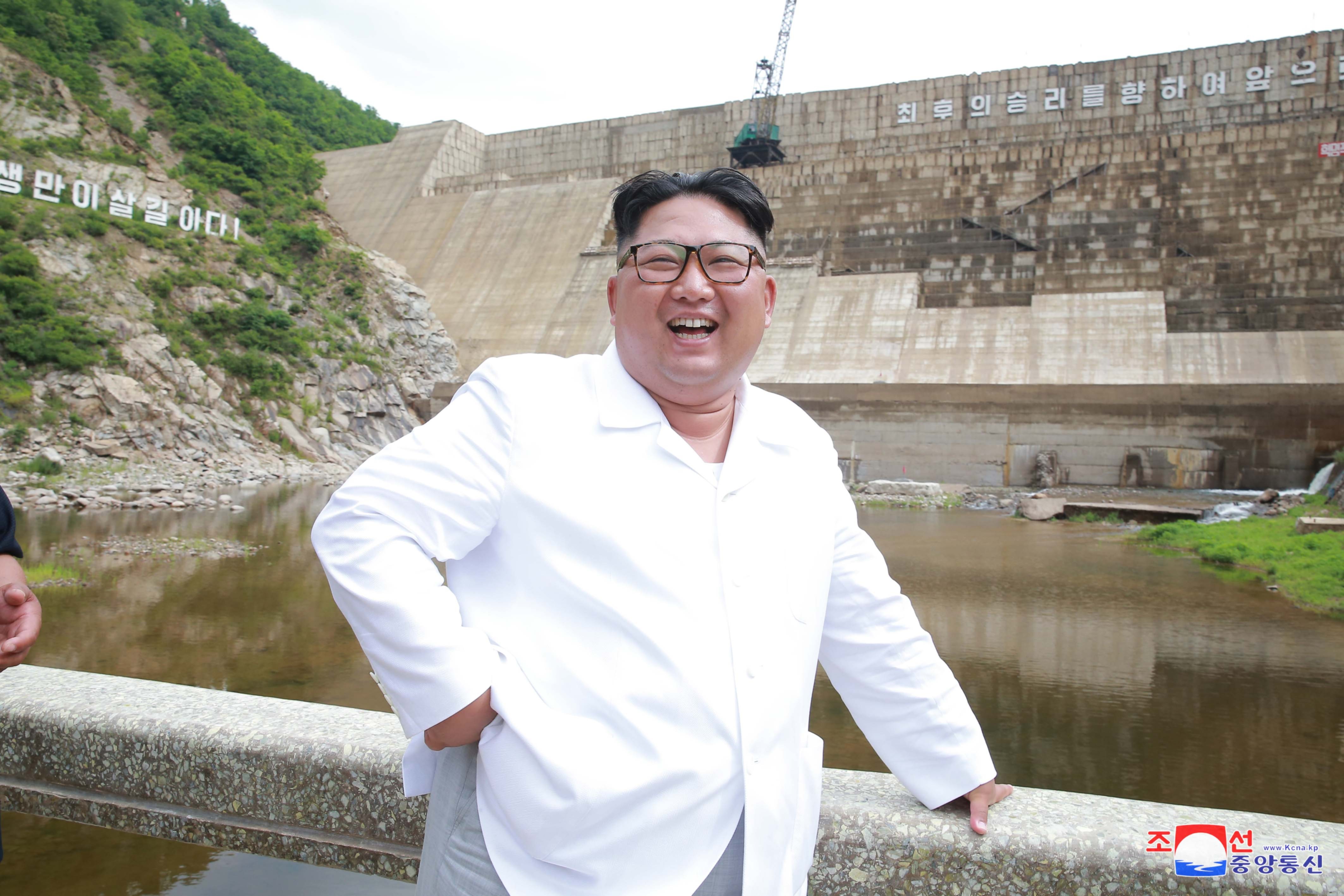
KJU’s last observed appearance was attending a commemorative photo-op with Samjiyo’n Workers’ Party of Korea (WPK) County Committee Officials
Kim Jong Un (Kim Cho’ng-u’n) spent a few days providing on-the-spot-guidance in North Hamgyo’ng Province. Attending the visits were senior party officials Hwang Pyong So (Hwang Pyo’ng-so’), Kim Yong Su (Kim Yo’ng-su), Jo Yong Won (Cho Yo’ng-wo’n), O Il Jong (O Il-cho’ng) and Kim Chang Son (Kim Chang-so’n) along with North Hamgyo’ng party and people’s committee cadres including North Hamgyo’ng WPK Provincial Committee chairman Ri Hi Yong (Ri Hi-yo’ng).
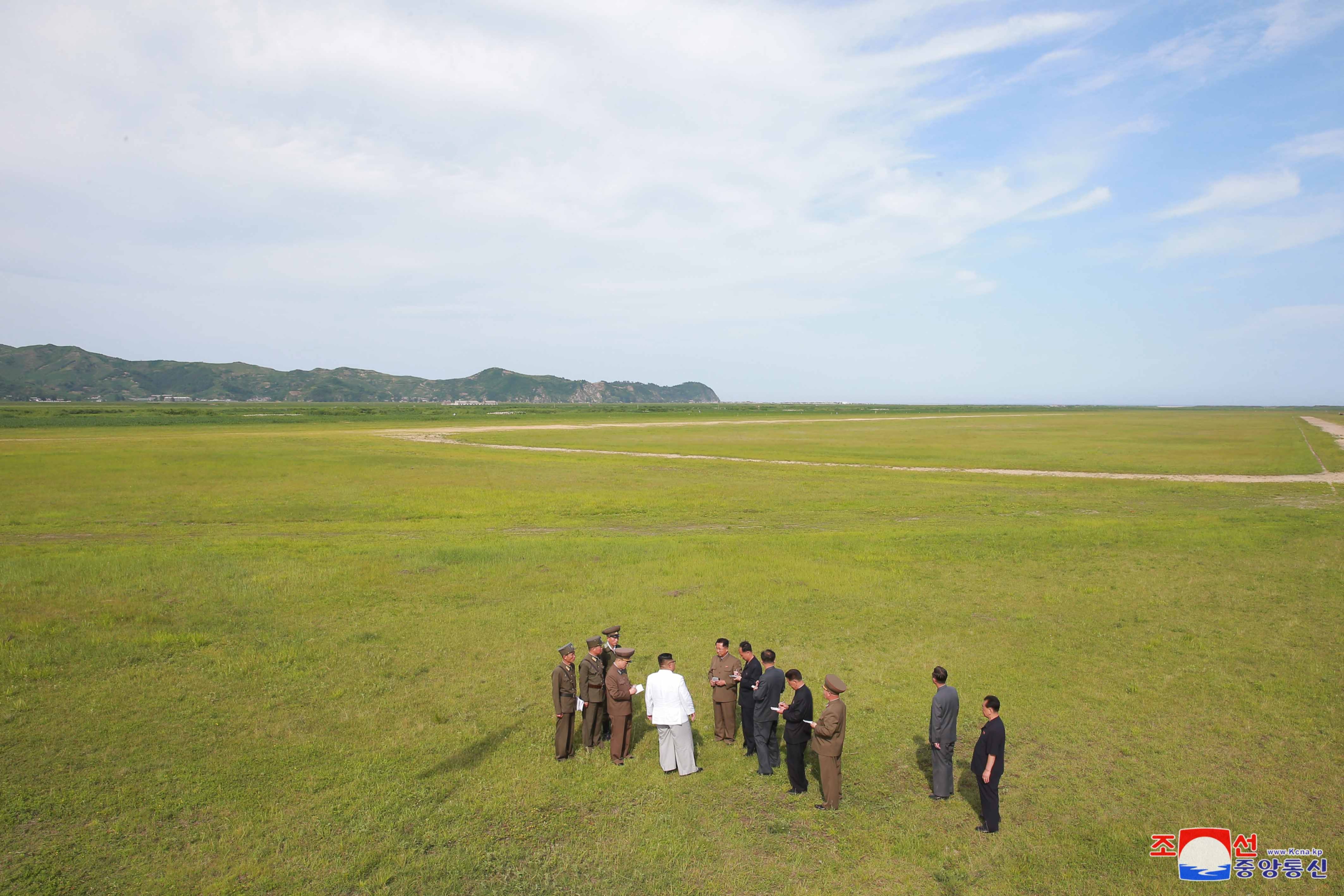
Jong Un conducted an inspection of Junghp’yo’ng-ri in Kyo’ngso’ng County with the intention of having a large vegetable greenhouse constructed there. According to DPRK state media he had “given his whole mind to sufficiently supplying vegetables to the people by massively cultivating them even in the northern oceanic climate more unfavorable than the plain area.” He traveled out to the land occupied by a Korean People’s Army (KPA) Air and anti-Air Force air regiment.
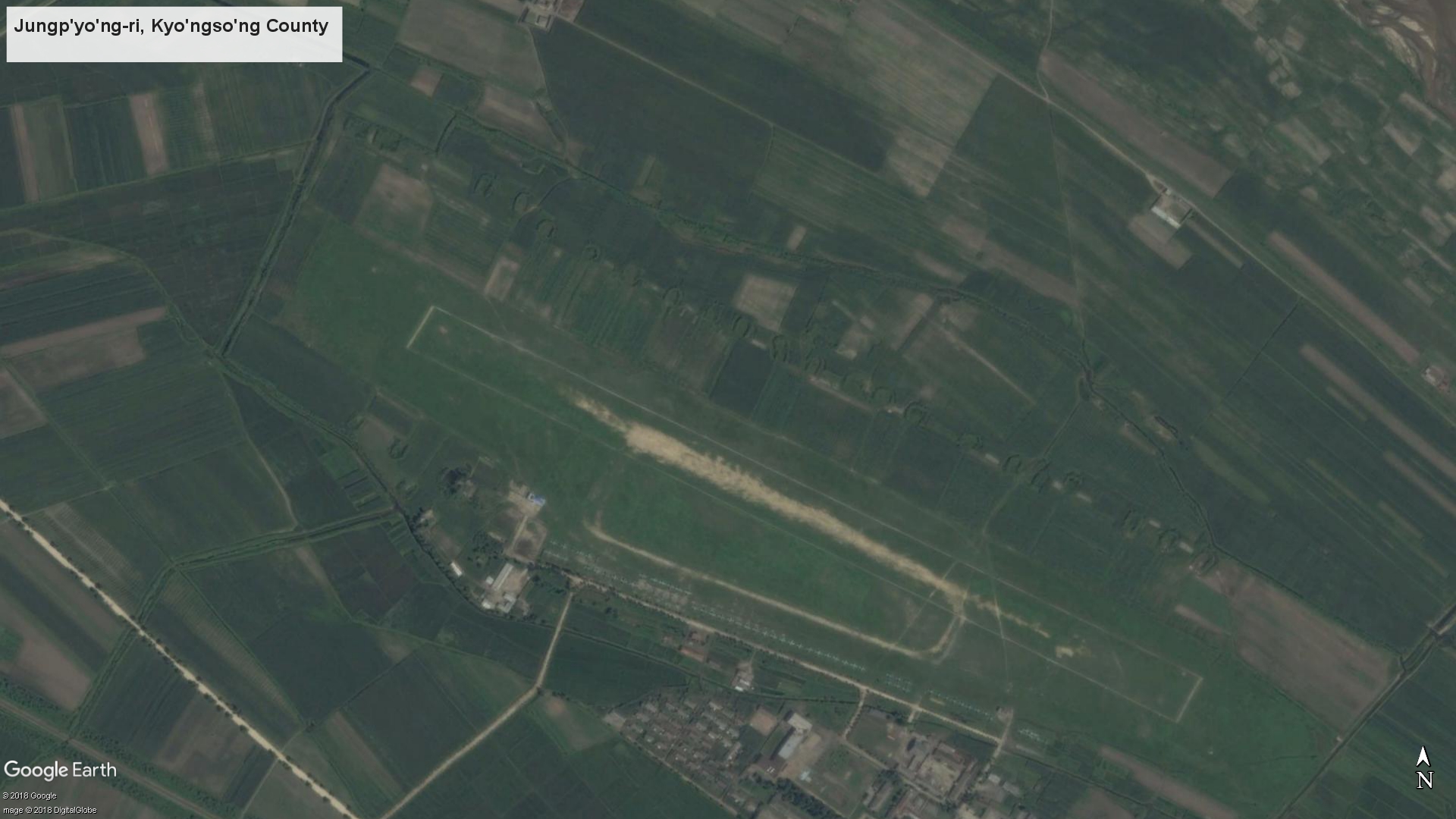
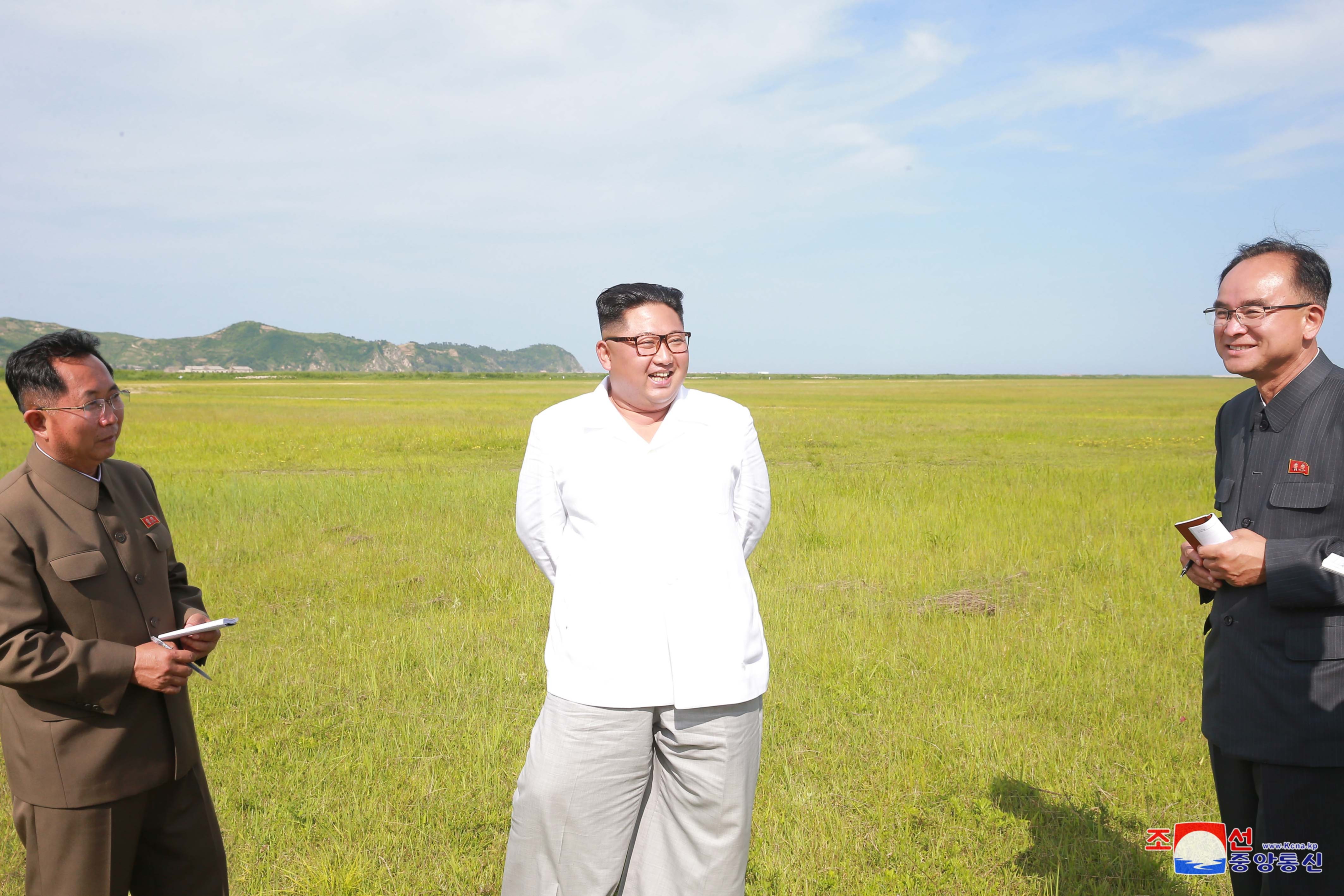
In accordance with a decision of the WPK Central Military Commission the regiment will vacate the land for the construction of the greenhouse. He said that “if we build a vegetable greenhouse farm of one hundred hectares, it will be splendid, and the area of the greenhouse will fully meet the needs of the people in the province. Jong Un expressed “great satisfaction” and said “he is very pleased today and most pleased that he does such worthy things for the people one-by-one.”
He said that the KPA “should build the farm at lightening speed as it is the first gigantic and large-scale construction in the country” and “stressed that it is necessary to build it at the highest level while ensuring both construction speed and quality as it is the farm to be provided by the Party with firm determination, not sparing the investment for the people in North Hamgyo’ng Province.” He “called for building the farmers’ residential area and cultural and welfare establishments in a modern and civilized way and thus successfully sprucing up the farm village as a model of socialist rural cultural construction and socialist paradise in which it is nice to live and work.”
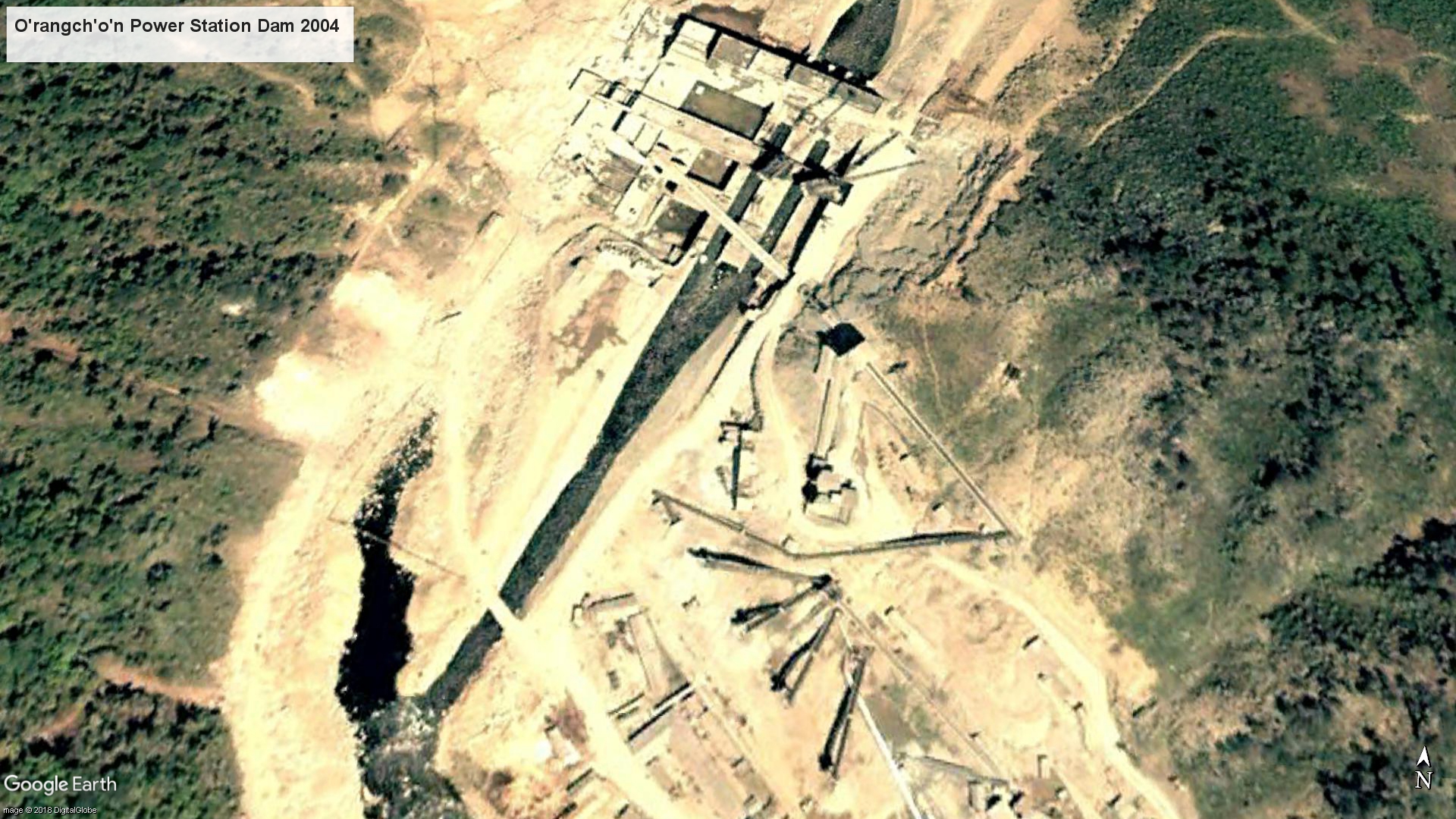
Kim Jong Un indicated “a general orientation arising in building the farm and operating it including the issue of organization the powerful headquarters for dynamically pressing ahead with the construction and permanent organs of different fields, the issue of manufacturing greenhouse equipment and supplying the construction materials and the issue of training the greenhouse engineers and securing seeds and manpower.”
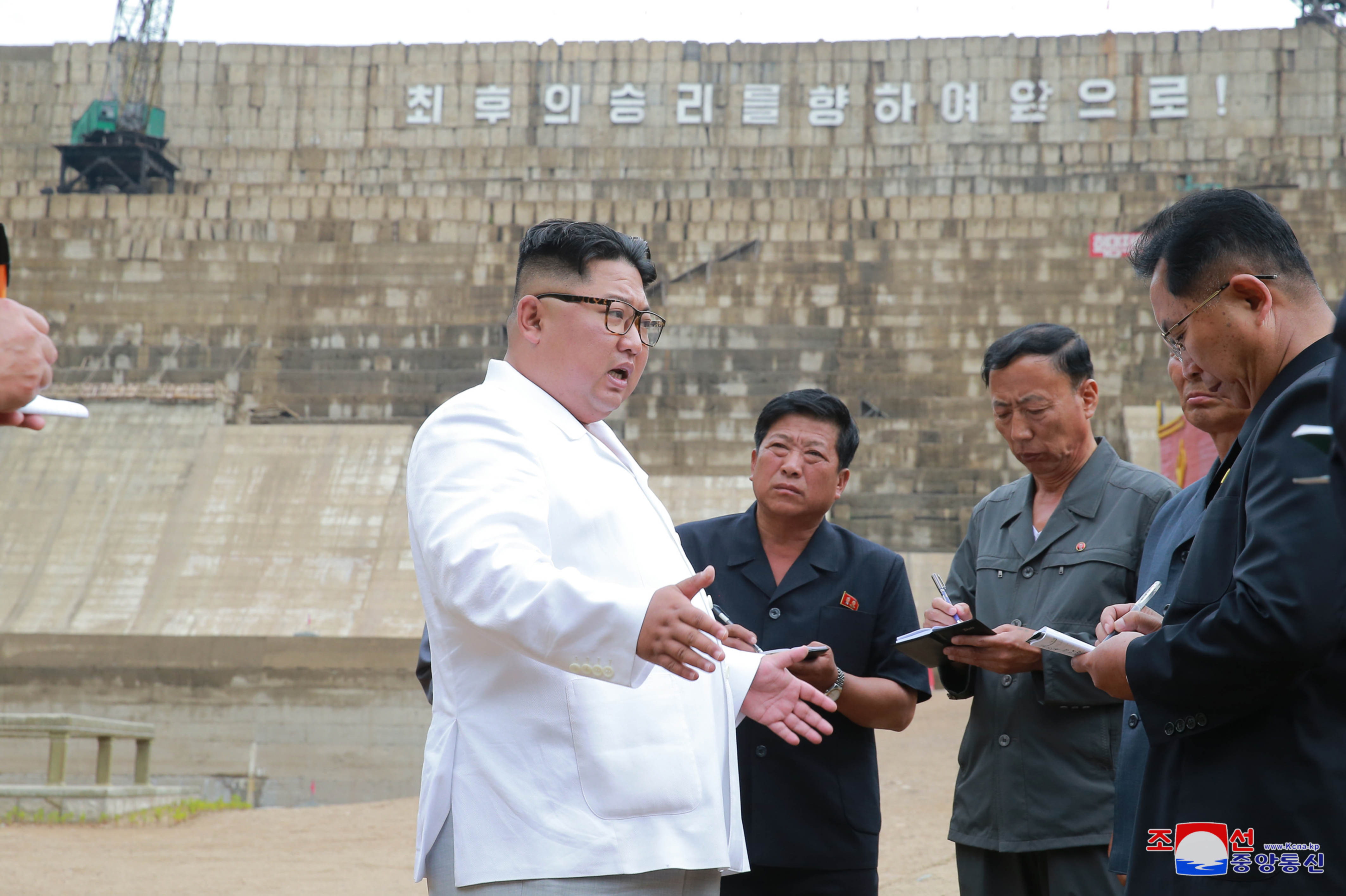
Jong Un then inspected O’rangch’o’n Power Station, first visiting the construction of the P’alhyang Dam, which has been under construction for 17 years. He “exchanged greetings with the officials who greeted him, appreciating their services.” He remarked that he was visiting to “personally learn about the situation and take measures as the project has not yet been completed.”
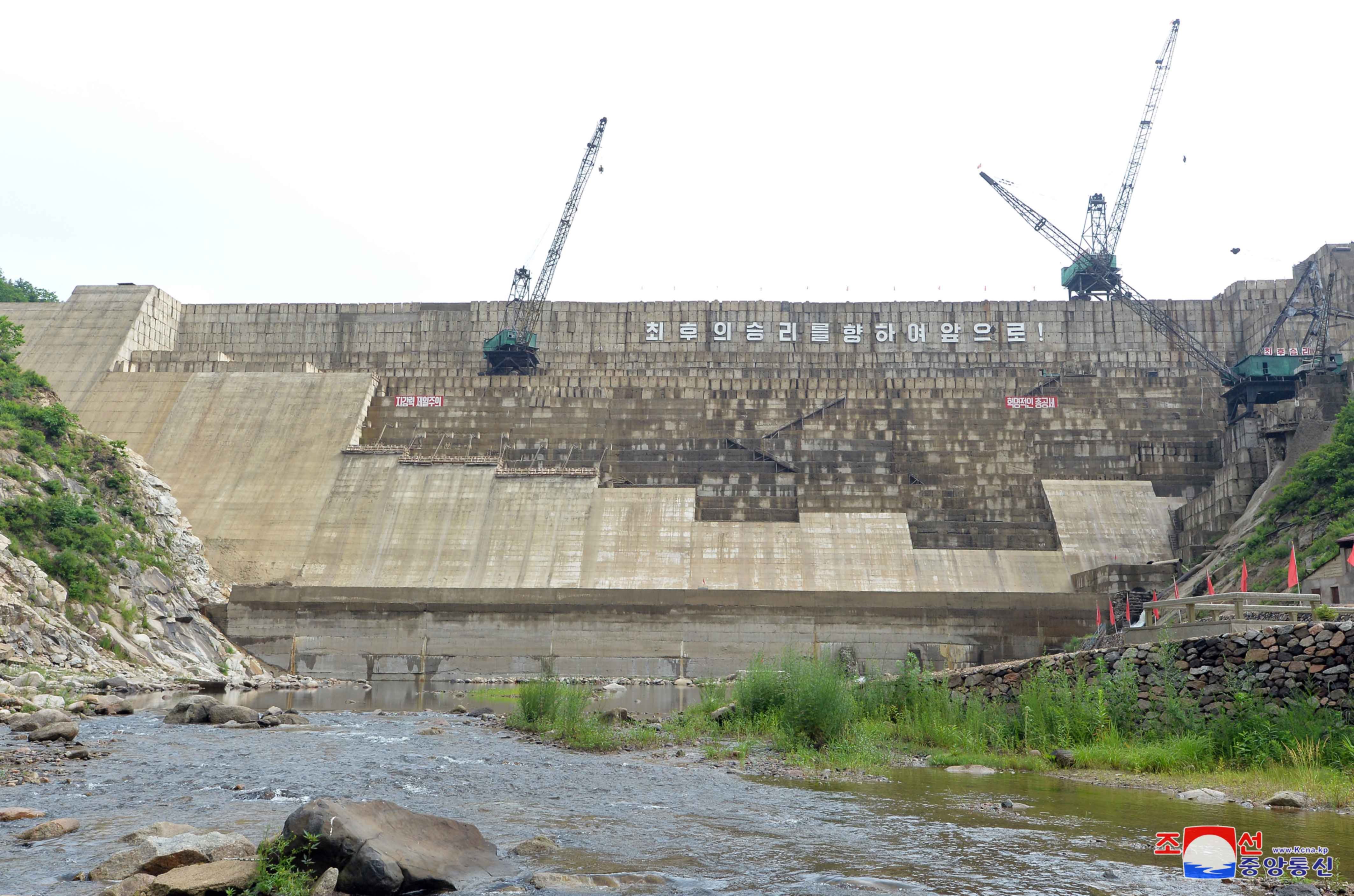
He said that “upper organs, in disregard of the situation of lower organs, only make a wordplay that the construction of the O’rangch’o’n Power Station is a task to be fulfilled in the period of the 5-year strategy for national economic development.” Jong Un pointed out that “the Cabinet has only specified the project as a target project that should be accelerated with the concentration of efforts in its reports of its series of joint meeting or on the list of its stereotyped work plan, but the Cabinet had never taken any practical and blitz measures for economic and organizational work.”
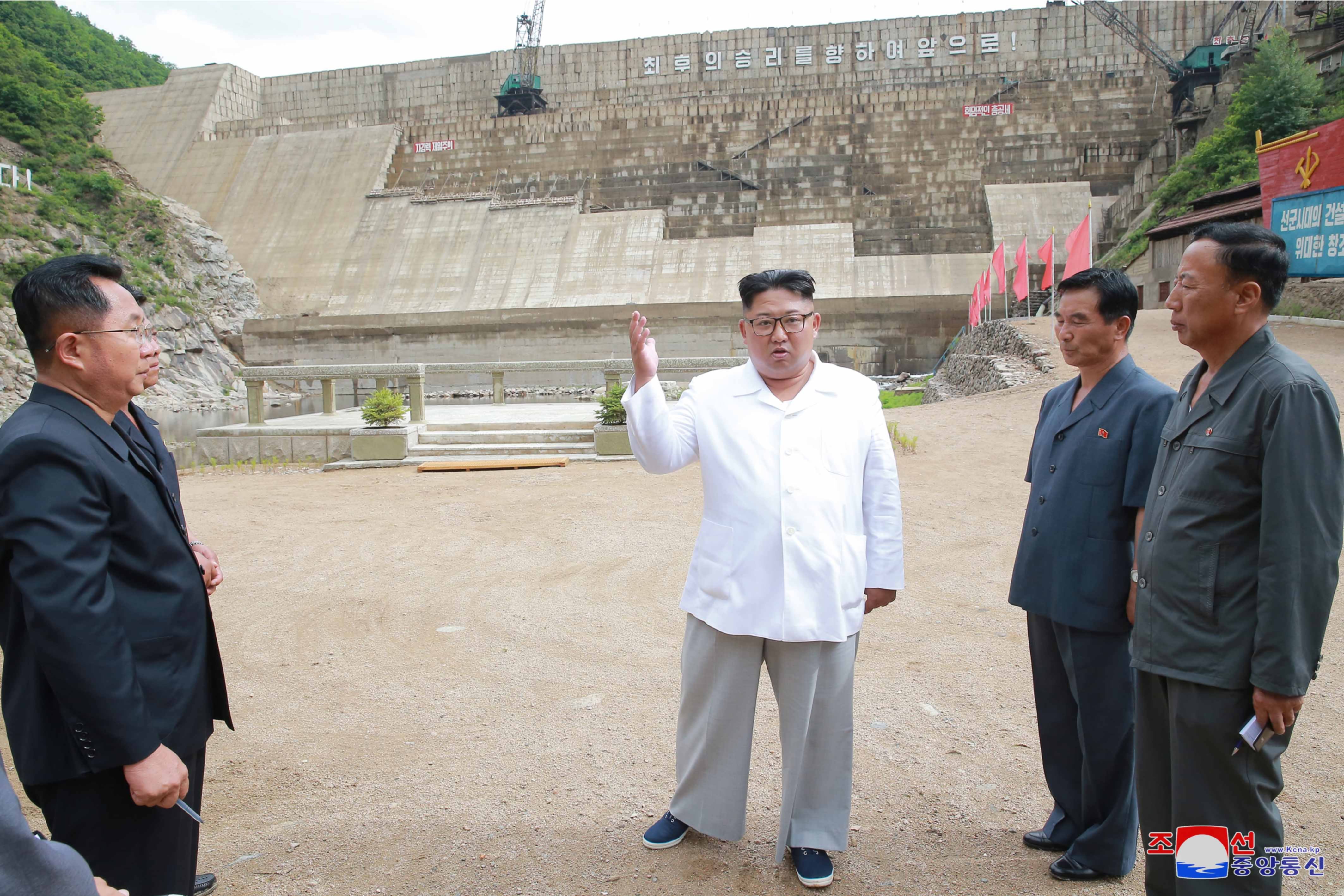
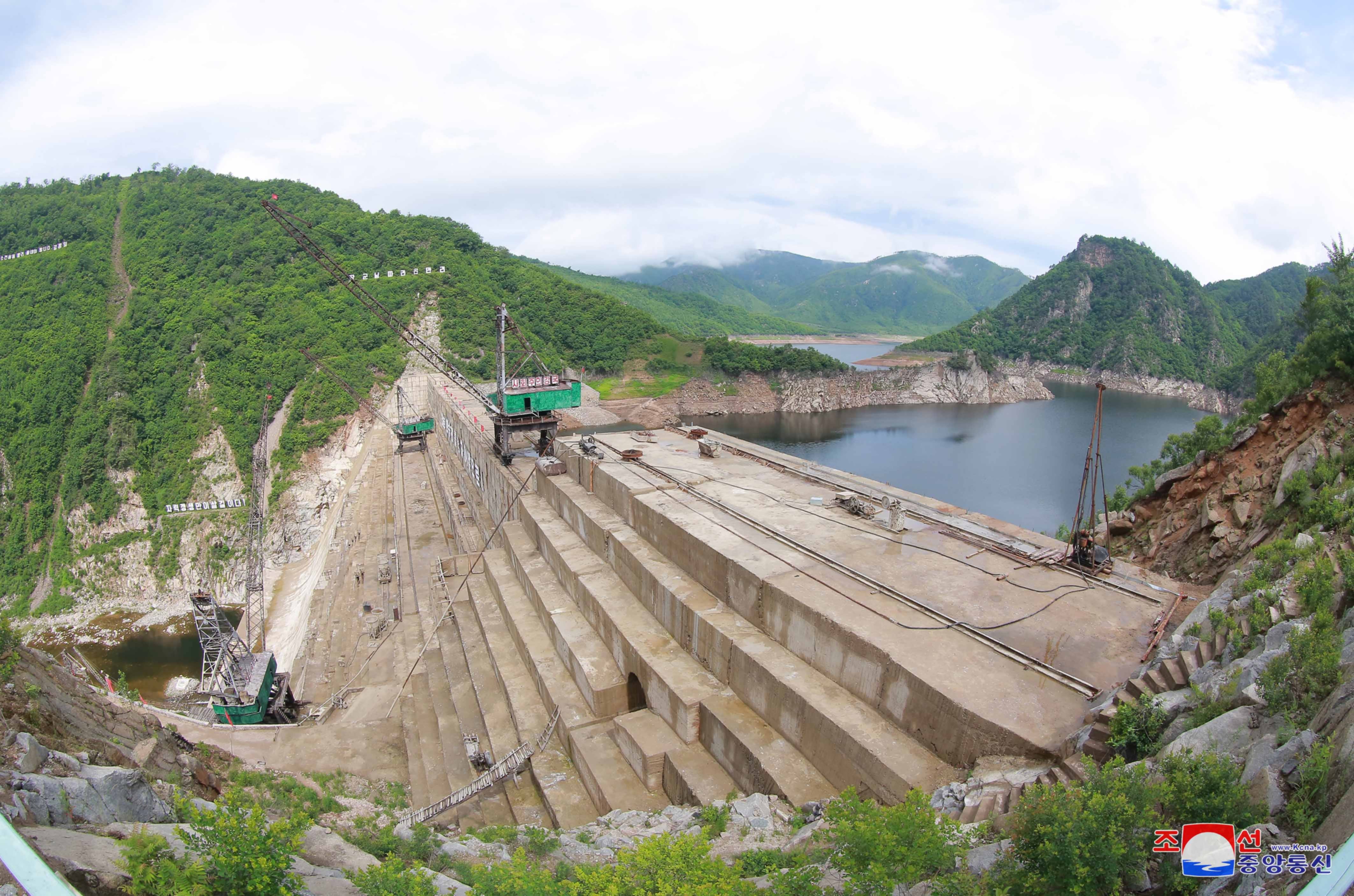
Kim Jong Un “reprimanded the leading officials of the Cabinet for leaving the project to the province only and not paying attention to it. Worse, still, the officials who are responsible for the national economy make their appearances in every inaugural ceremony for power stations, though they never inspected the power stations and dams when they were under construction.”
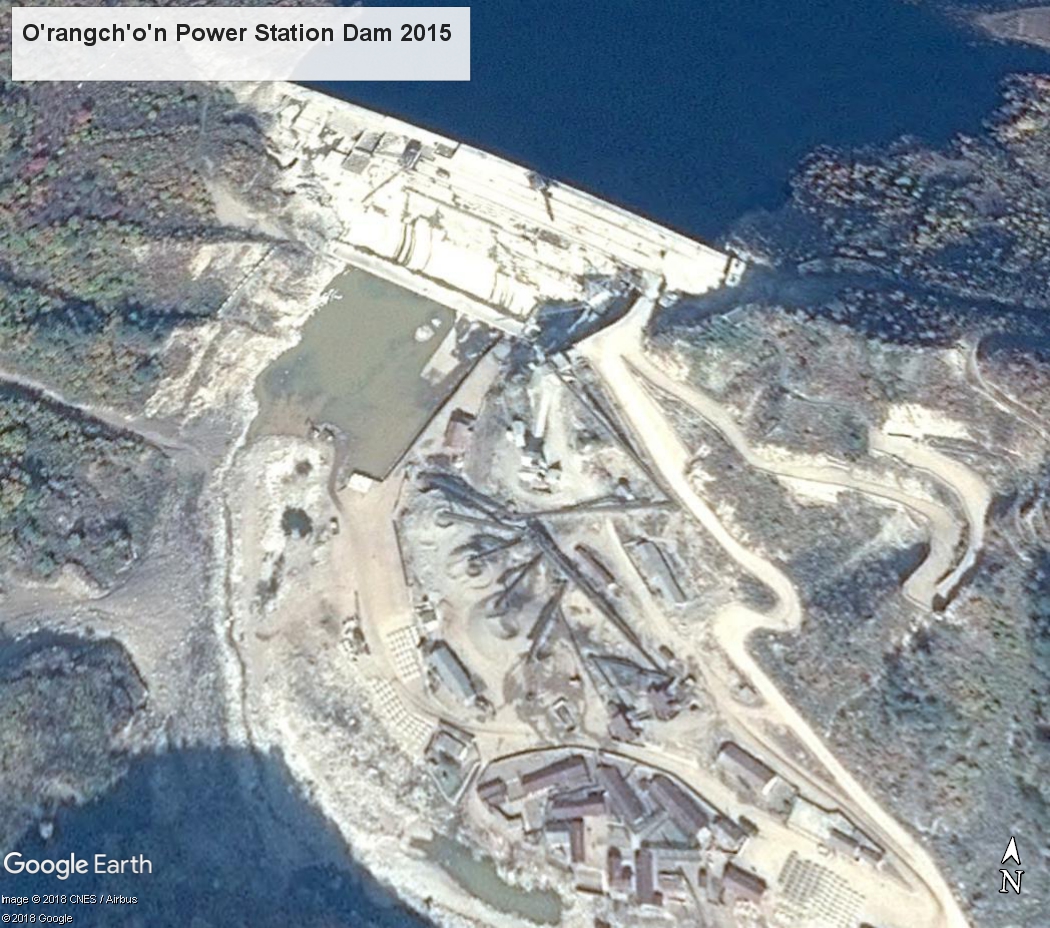
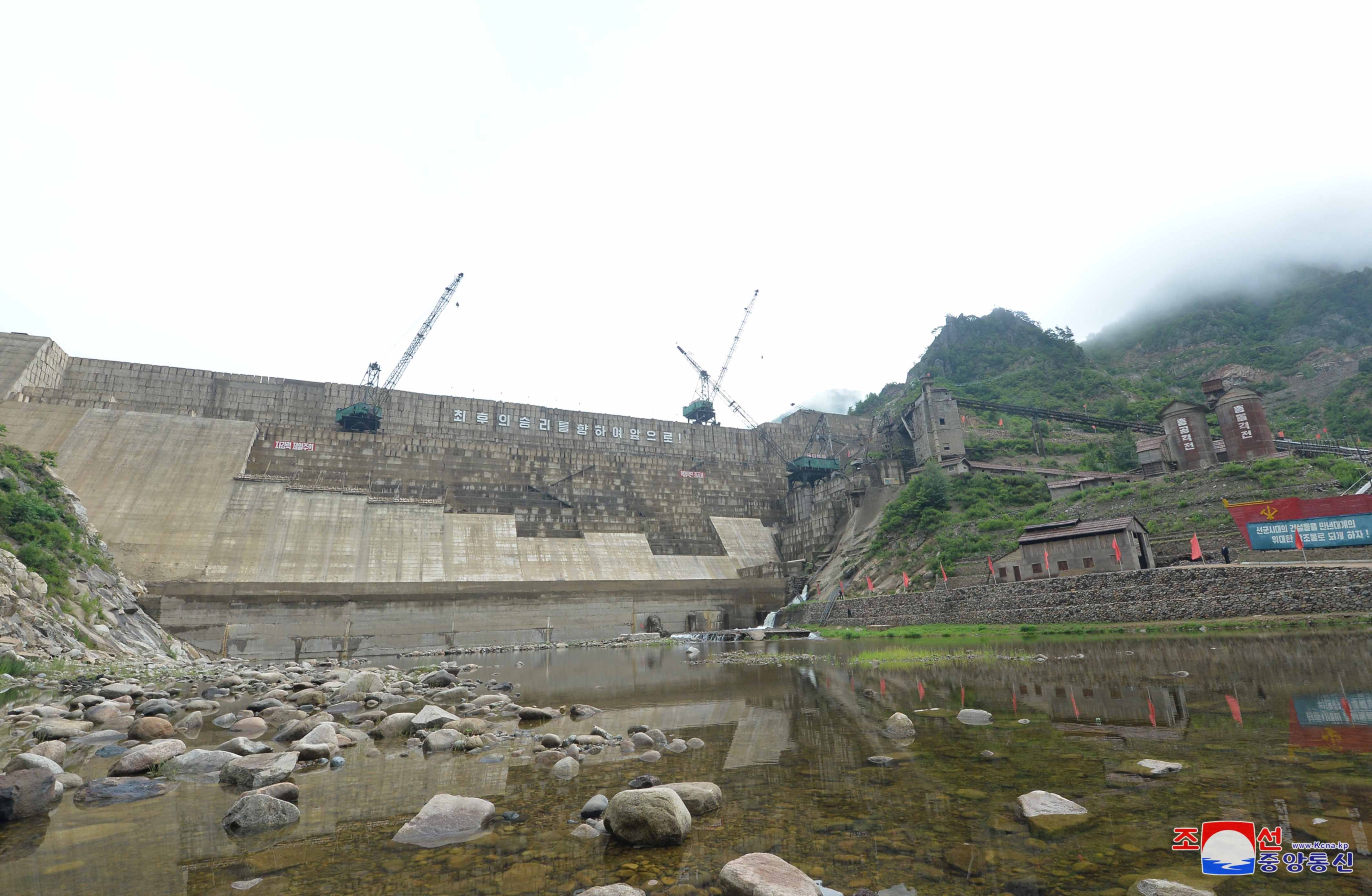
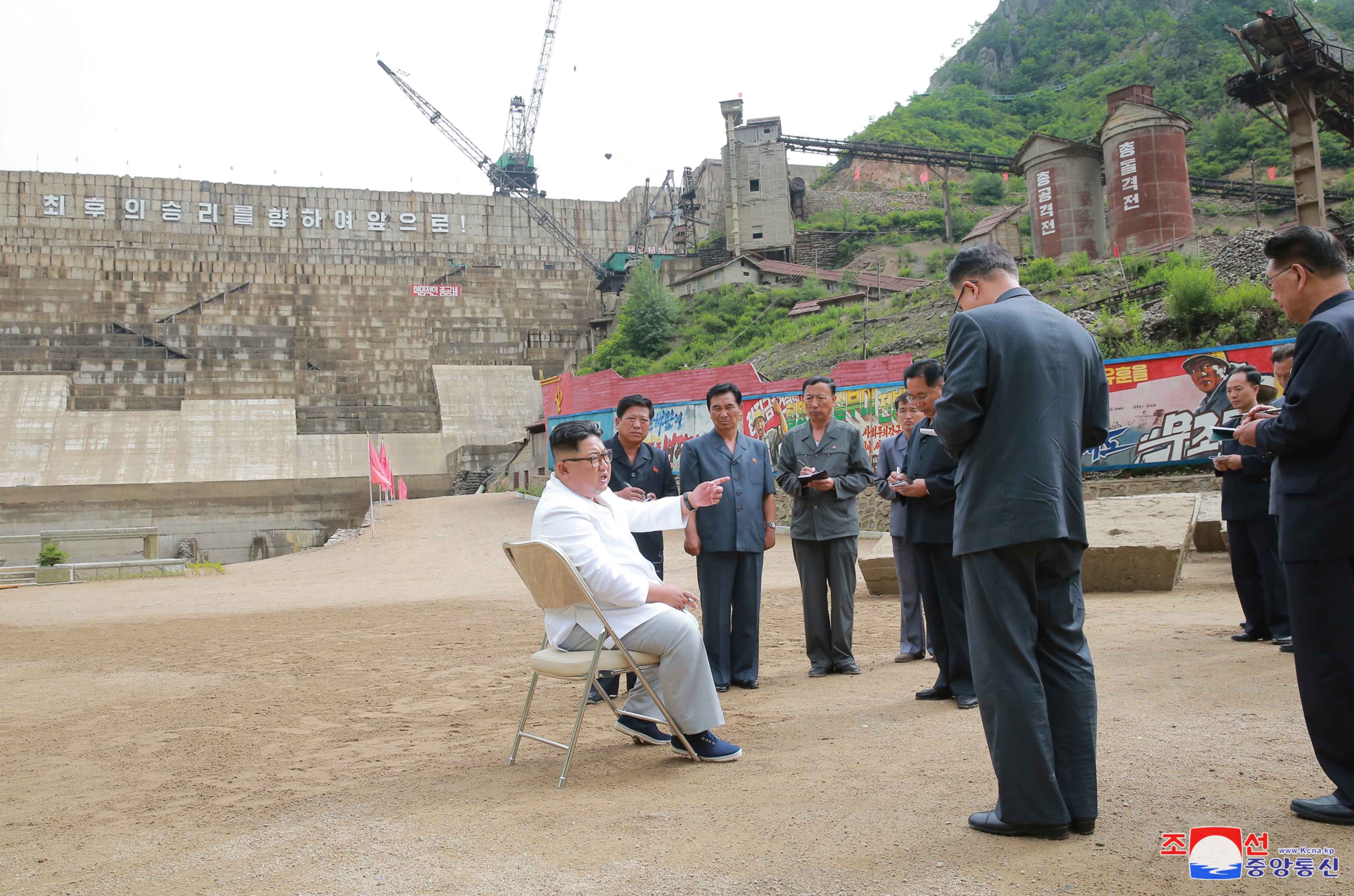
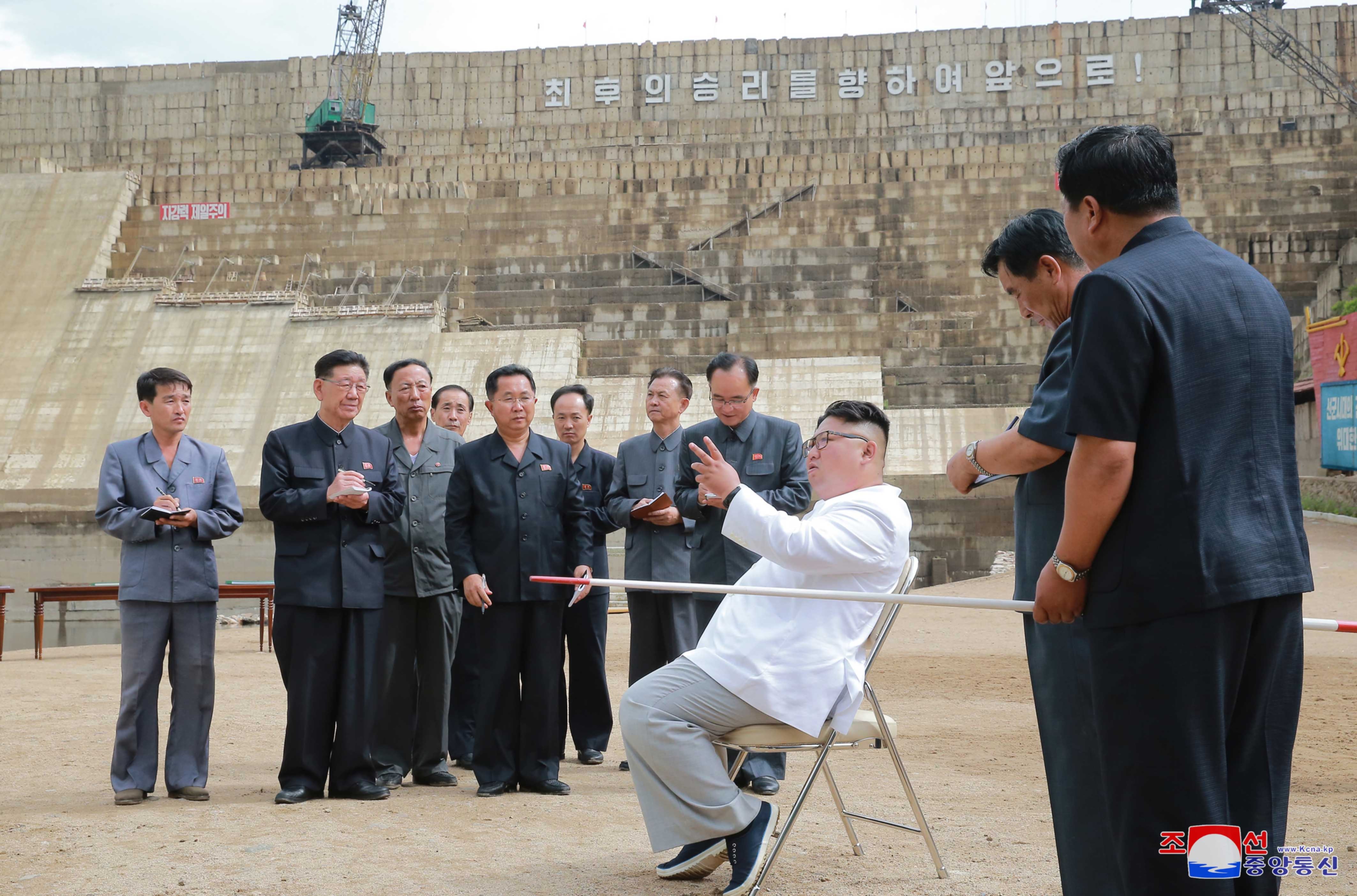
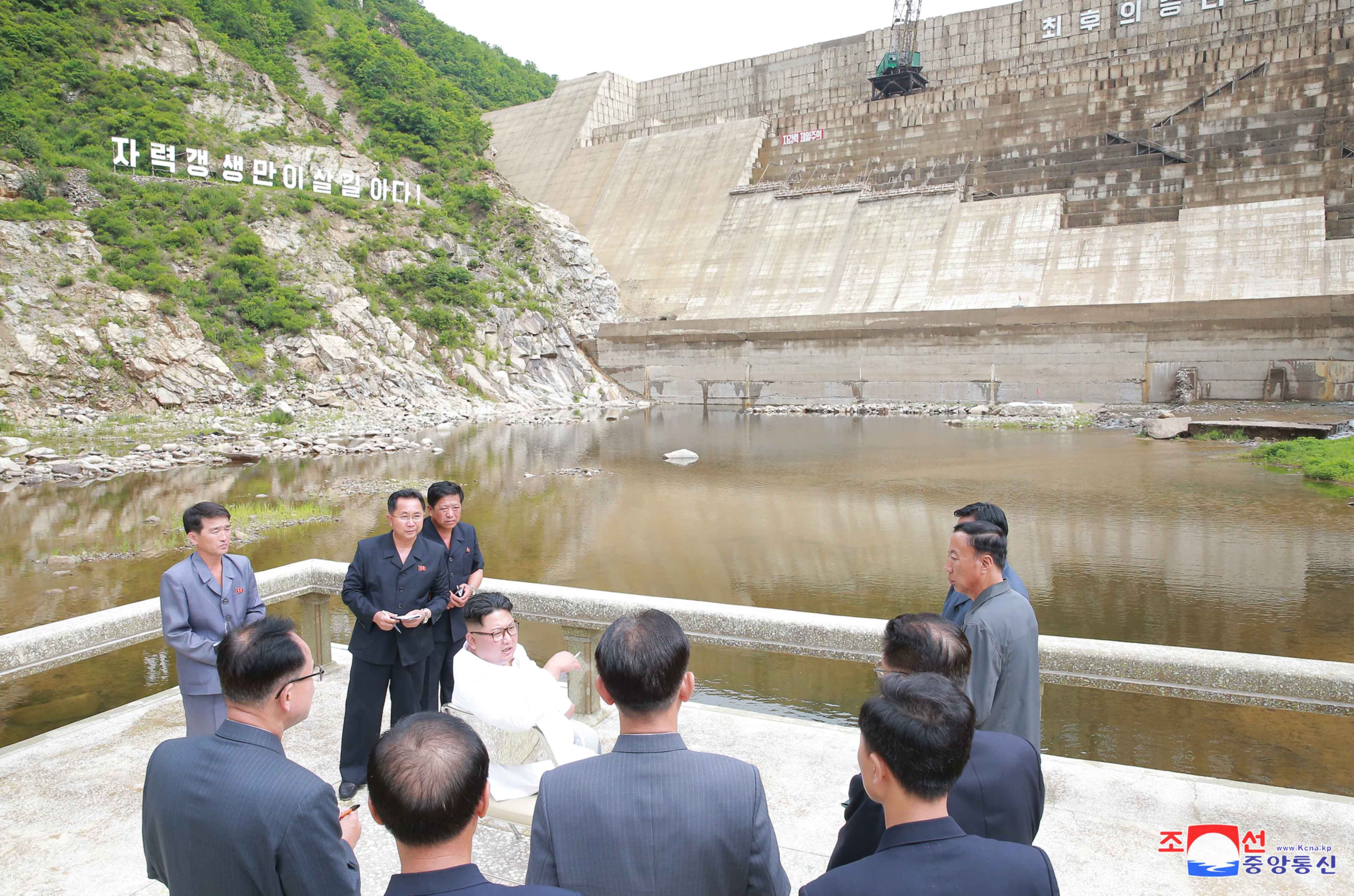
Kim Jong Un noted that “if the O’rangch’o’n Power Station is constructed, it will tangibly contribute to promoting the economy and the people’s livlihood in North Hamgyo’ng Province where industrial establishments are densely located.” He also “criticized the officials of the province and county for not having sent a letter to him connection with the situation though they were very much concerned about the delayed construction of the power station which is vital and urgent work of the province, and for having neither worked in a far-sighted manner nor focused their efforts on the construction for the mere reason that it gives no immediate benefits, but requires heavy investment.”
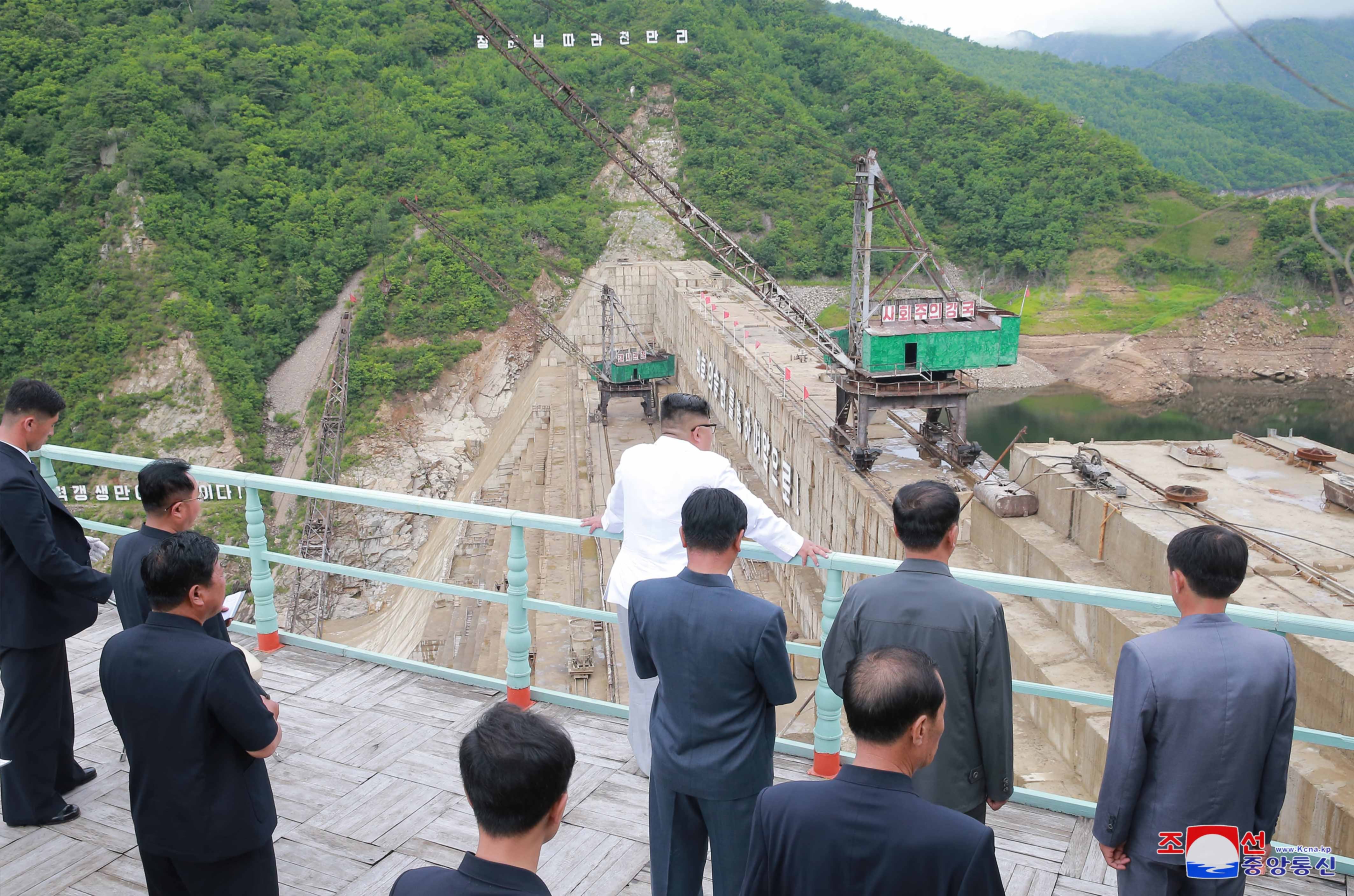
Jong Un “took a revolutionary measure by giving an instruction for the Party Central Committee to provide organizational guidance to the construction of the dam and the power station by mobilizing all party organizations and members thus complete the project by October 10 next year (2019).”

He also toured O’rangch’o’n Power Station #5. He watched “generating equipment installed at the power station” and said “highly efficient and modern generating equipment should be installed and operated in full capacity to steadily increase the production of electricity, pointing out that the power station was built with so much effort but it fails to produce electricity at full capacity.”
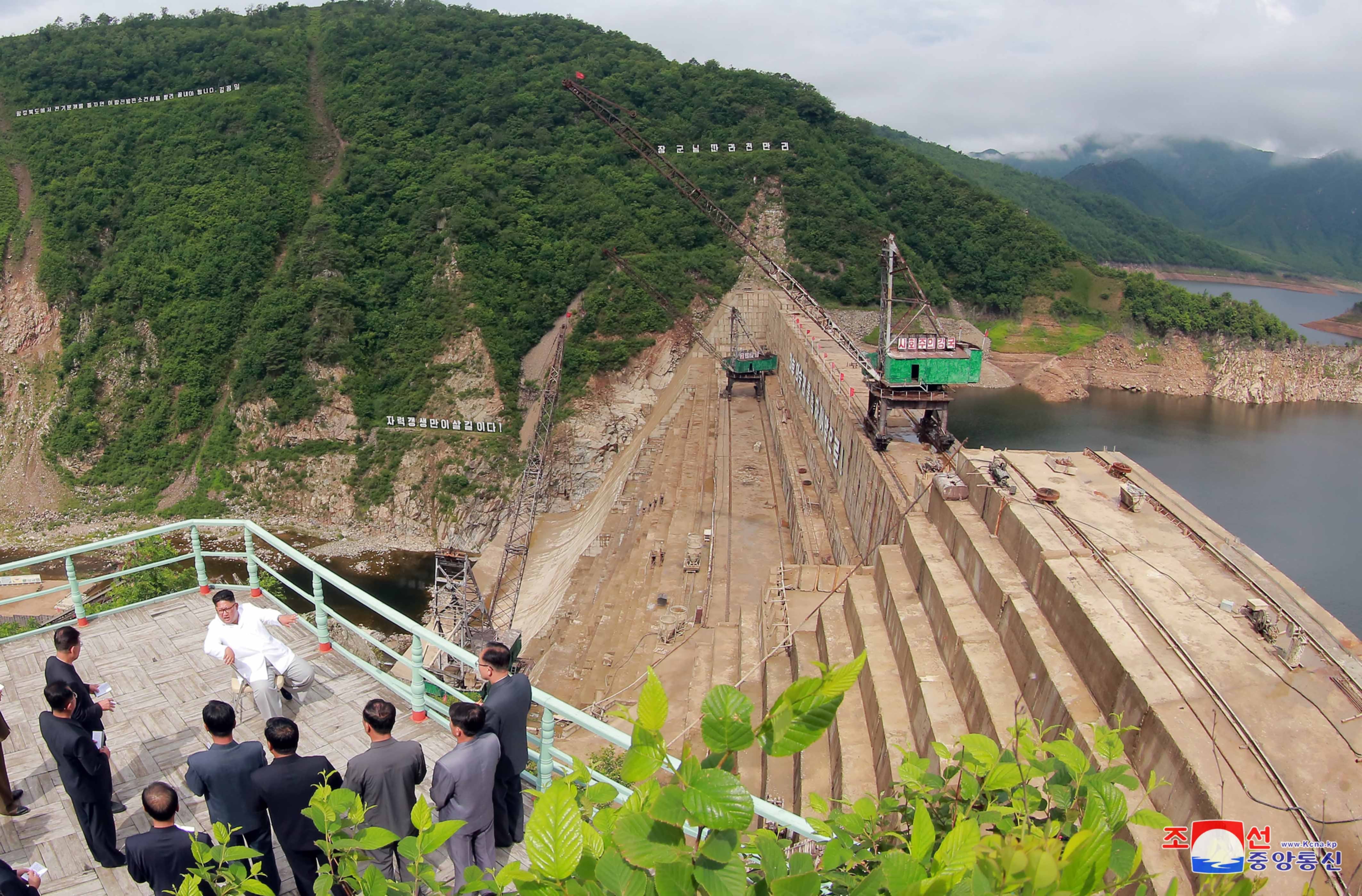
Jong Un noted that “if the loss of electricity in transmission is decreased, electricity reserves equivalent to building some new power stations will be gained.” He said “produced electricity should be effectively used by taking a decisive measure to decrease the loss of electricity in transmission though it might require much efforts.”
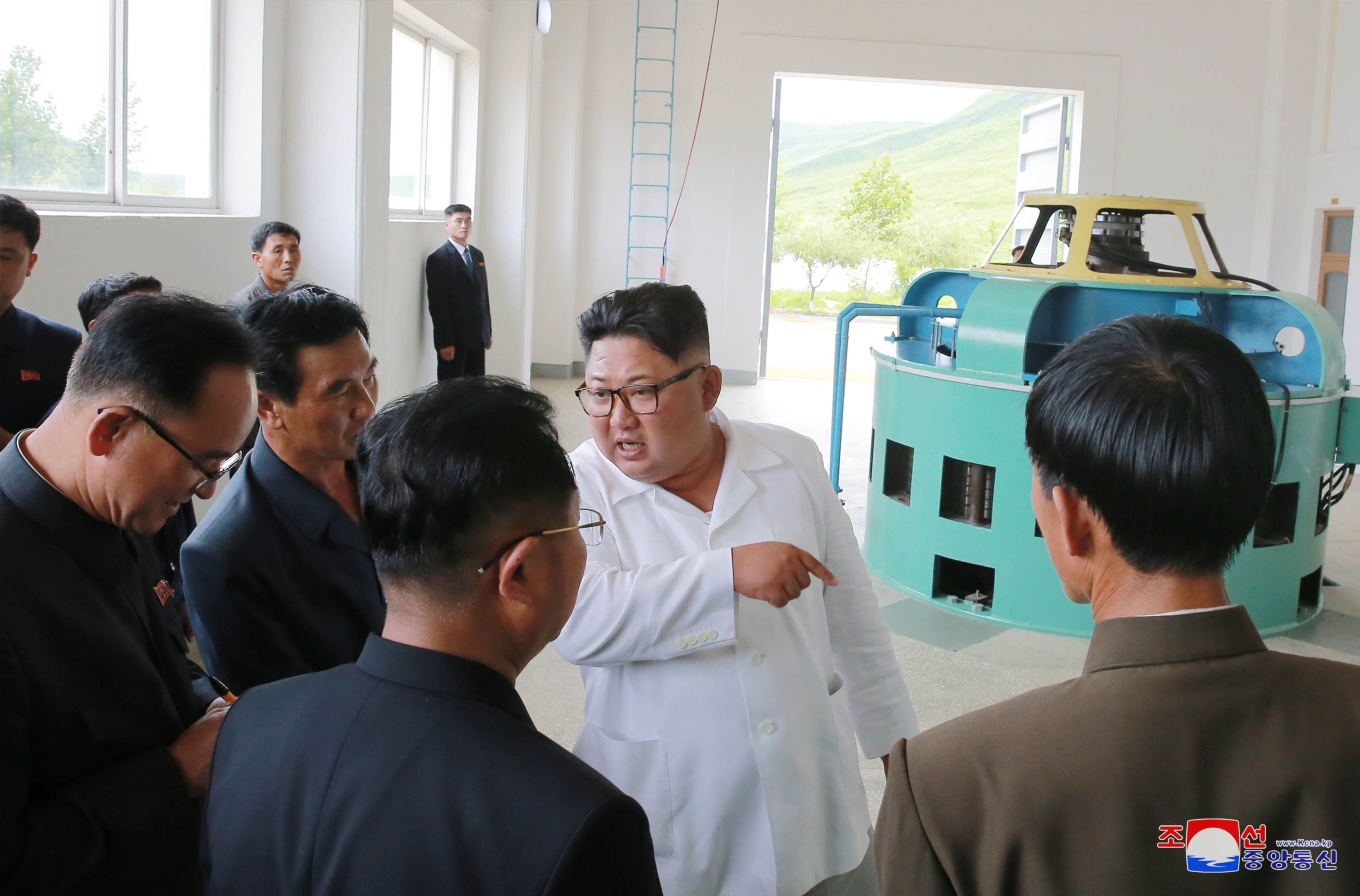
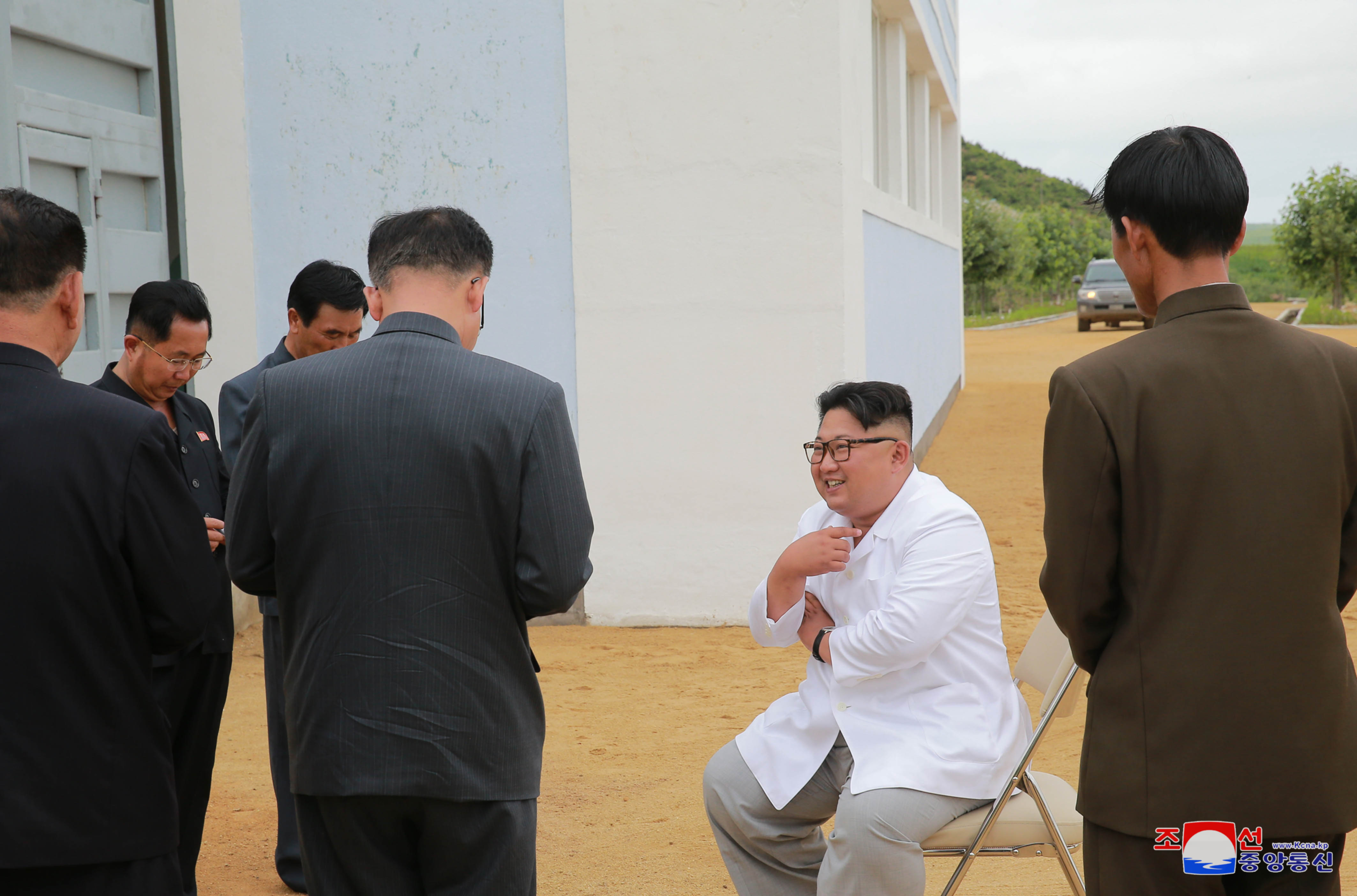
He noted that the “builders of the power station have so far done much with pure conscience despite difficulties, whether their efforts are known or not, and the dam is growing thanks to the intense loyalty and inexhaustible strength of the builders who have performed labor feats for implementing the Party policy.” Kim Jong Un “ardently called on the whole country to turn out in the general drive, keeping step with the builders.”
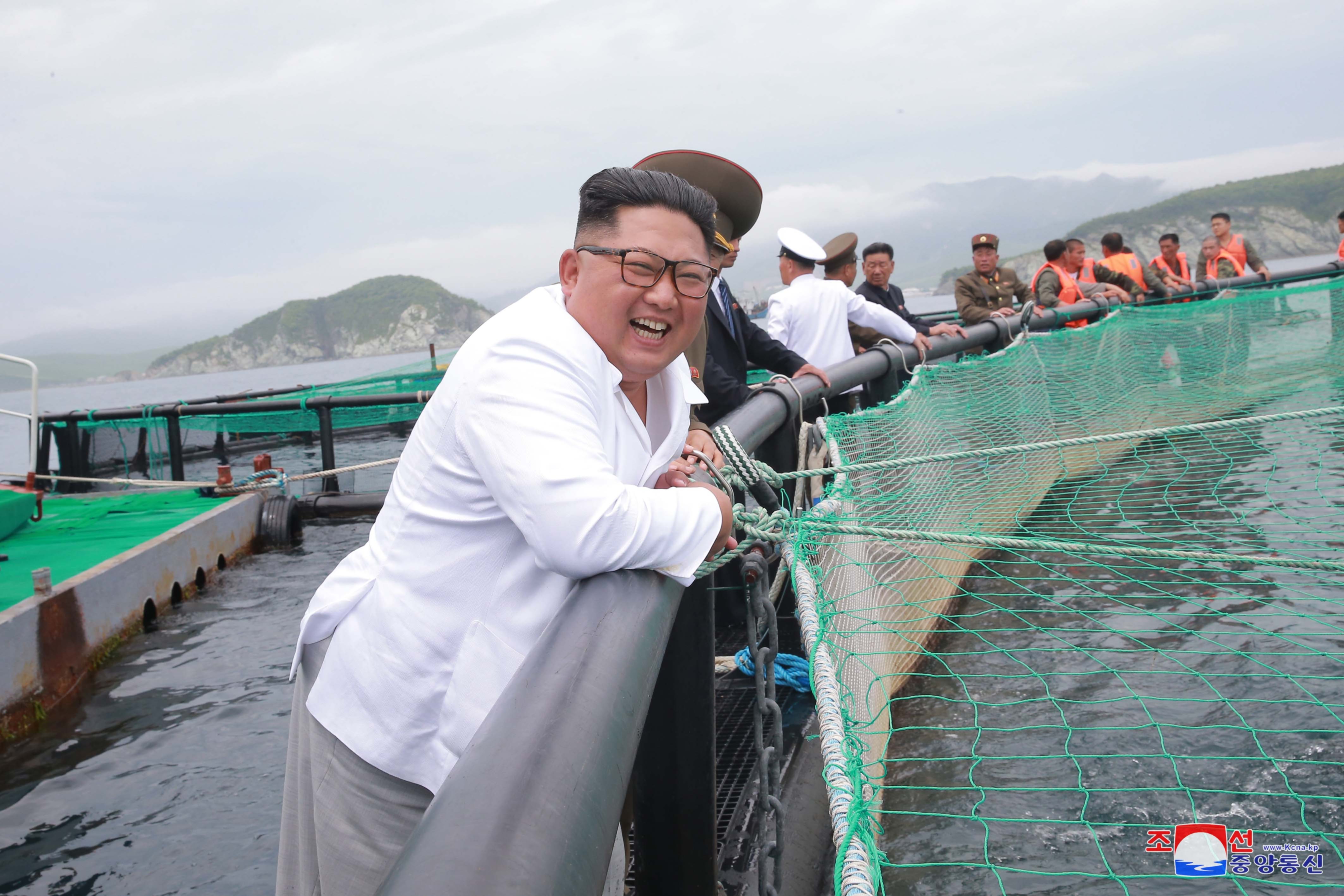
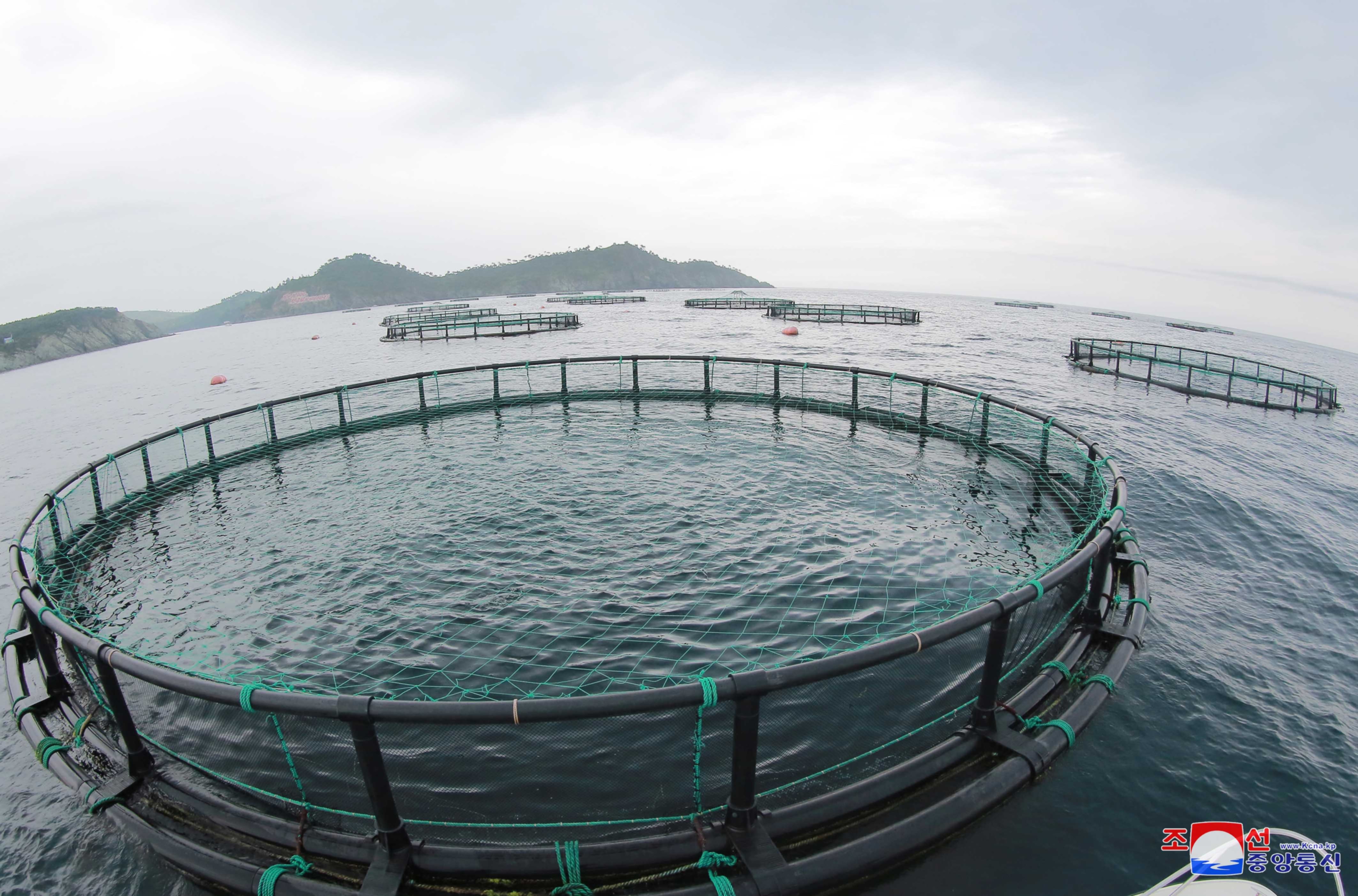
Jong Un toured salmon farms subordinate to KPA Unit #810. He stopped in to the revolutionary history room and was briefed about salmon breeding. He remarked that “it is important to creat a clean environment and establish a strict hygienic and anti-epidemic system in fish breeding grounds like in stockbreeding” and “noted with appreciation that ten-odd settling troughs were newly arranged at rivers flowing to Raksan Bay and at waste water outlets of industrial establishments and seaweed and tangle culture grounds were built around cage-net fish breeding ground to prevent sea pollution and protect the global ecological environment.”

Jong Un said that “advanced technology should be positively introduced to put the offshore fish farming, cage-net farming, on a scientific and industrial basis and big efforts be directed to the work for preserving the uncontaminated ecological environment of sea on a high level so as to expand the water areas fit for breeding Atlantic salmon and produce the kind of fish in a larger quantity.”
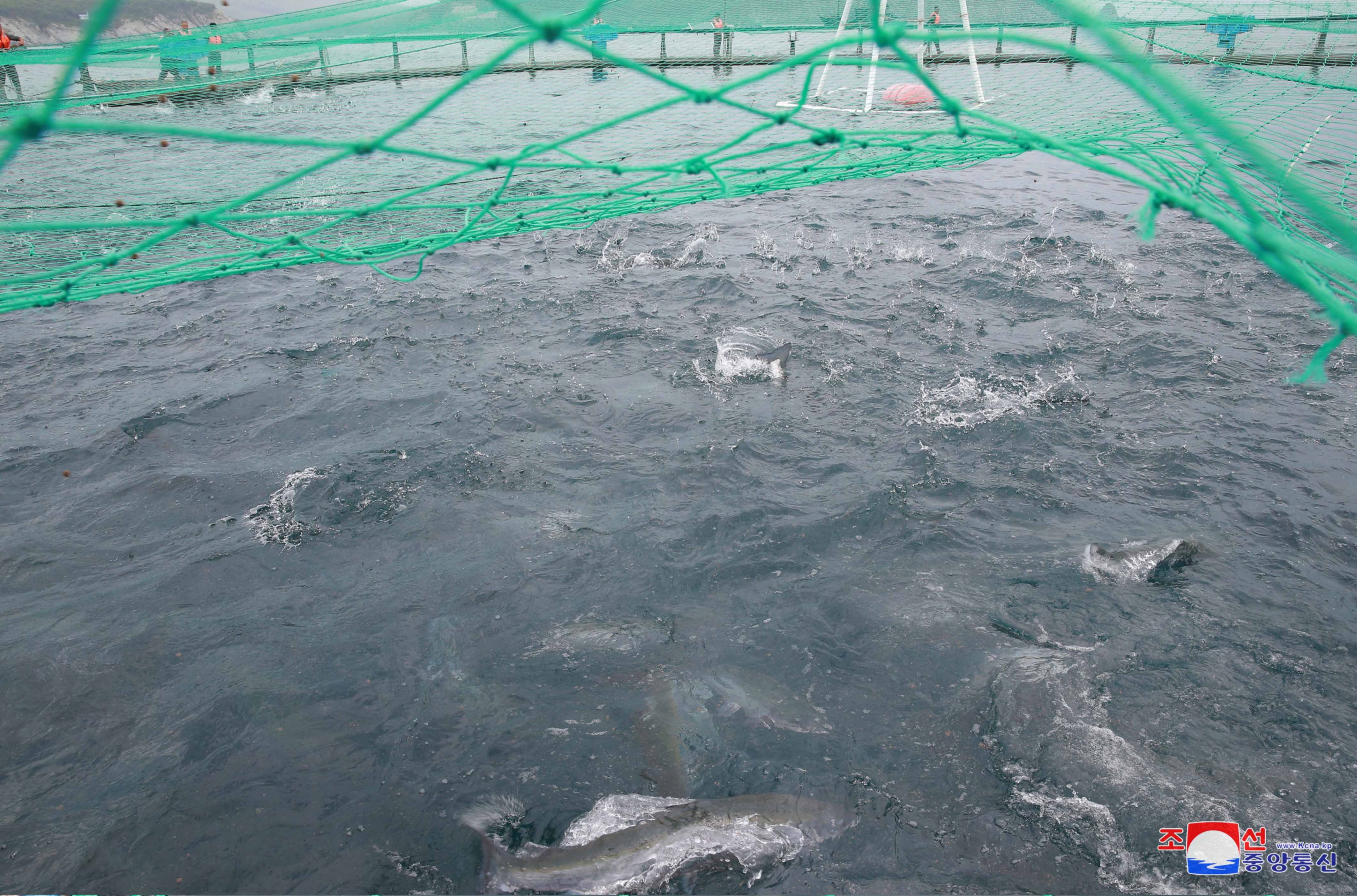
He said that “it is necessary to raise the level of putting the production of processes salmon on a scientific, automatic and modern basis, strictly ensure its hygienic safety and quality and realize its standardization” and that “Atlantic salmon bred on the East Sea of Kore and processed fish should be intensively supplied to the Pyongyang Taedonggang Seafood Restaurant to improve the people’s diet.”
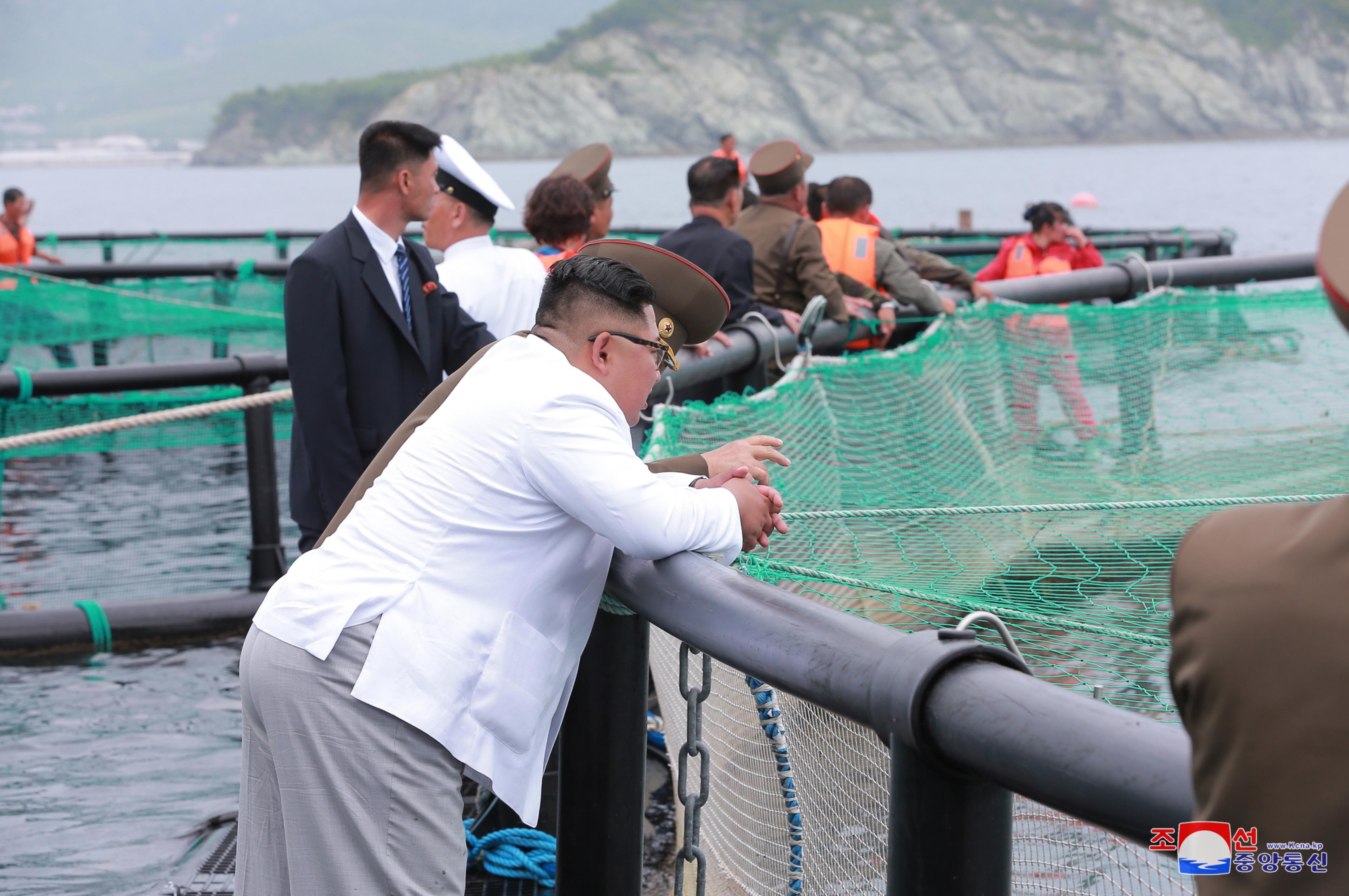
Kim Jong Un also went ’round the Sokmak Atlantic Salmon Pedigree Farm, touring the revolutionary history education room, a fisheries pond and other places to learn “about its management and operation.” He “highly appreciated the officials and employees of the farm for having done a lot of work through a dynamic drive for updating the farm on a high level over the last three years to carry out the tasks given by him on the spot in May 2015.”
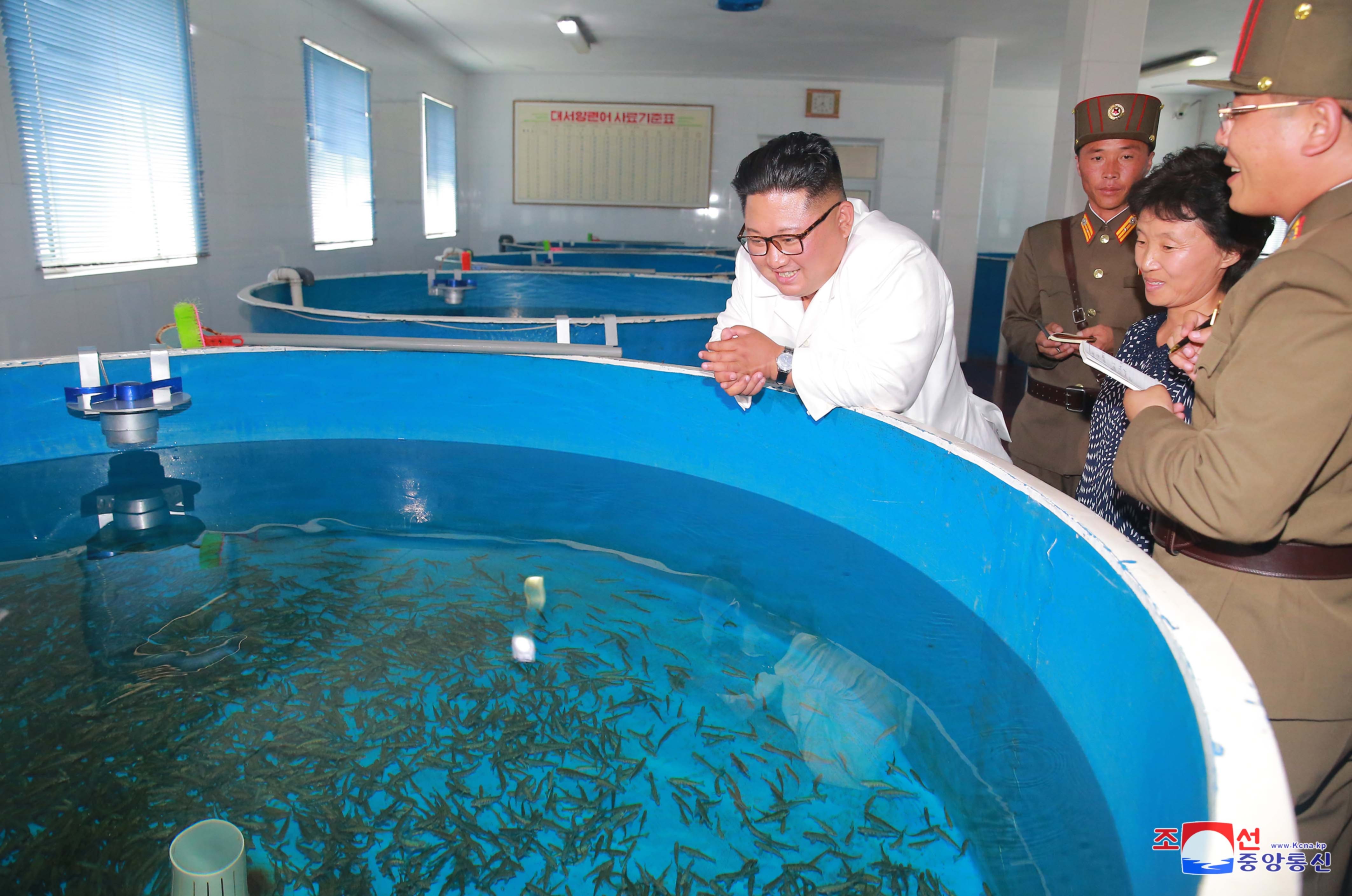
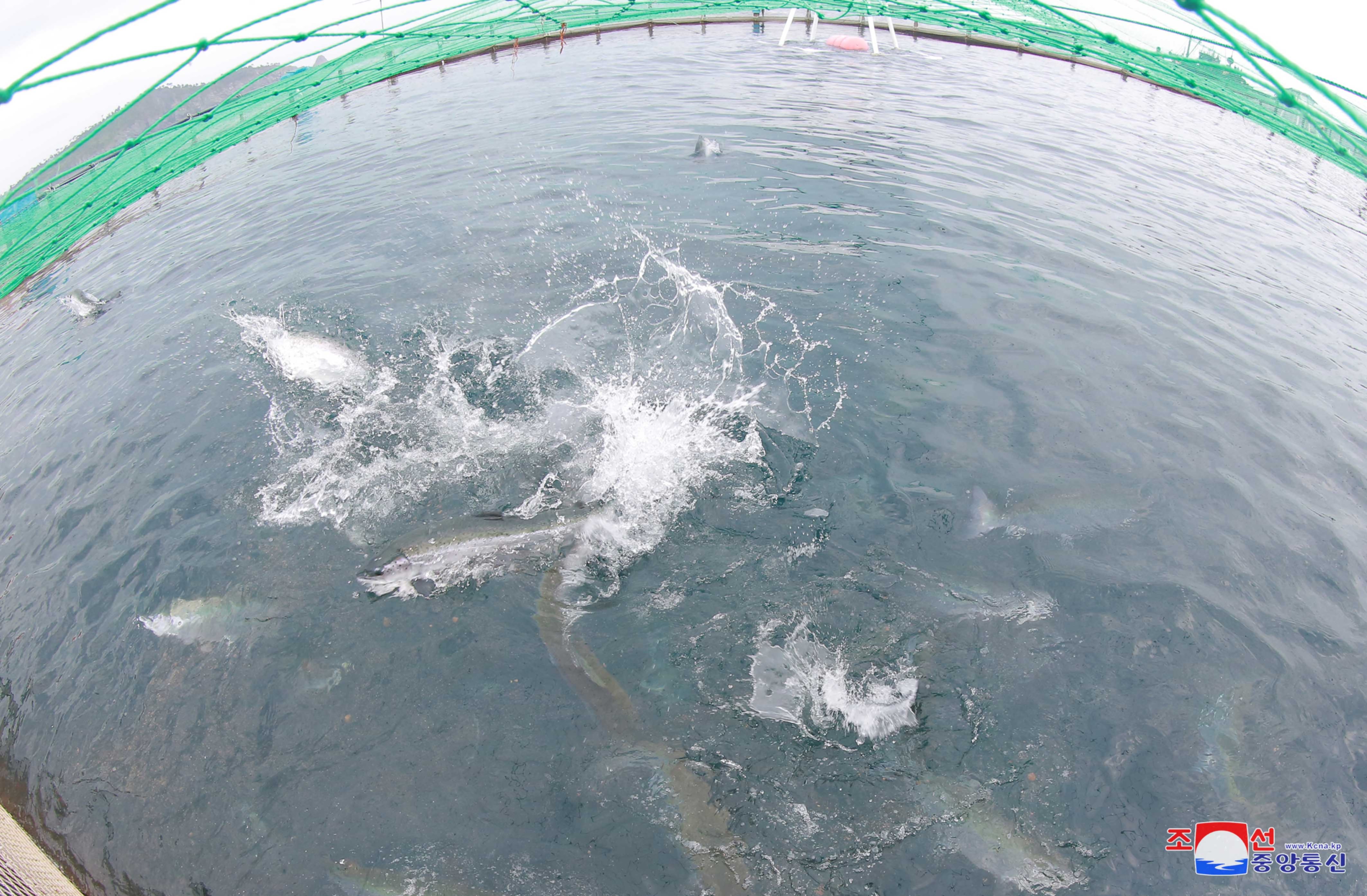
To that effect the farms employees “spruced up the room for education in the revolutionary history, established an automatic control system for water recycling by computer and newly built oxygen-generating station, cylinder caisson and ultraviolet sterilizing station to increase the capability of water purification and oxygen saturation.”

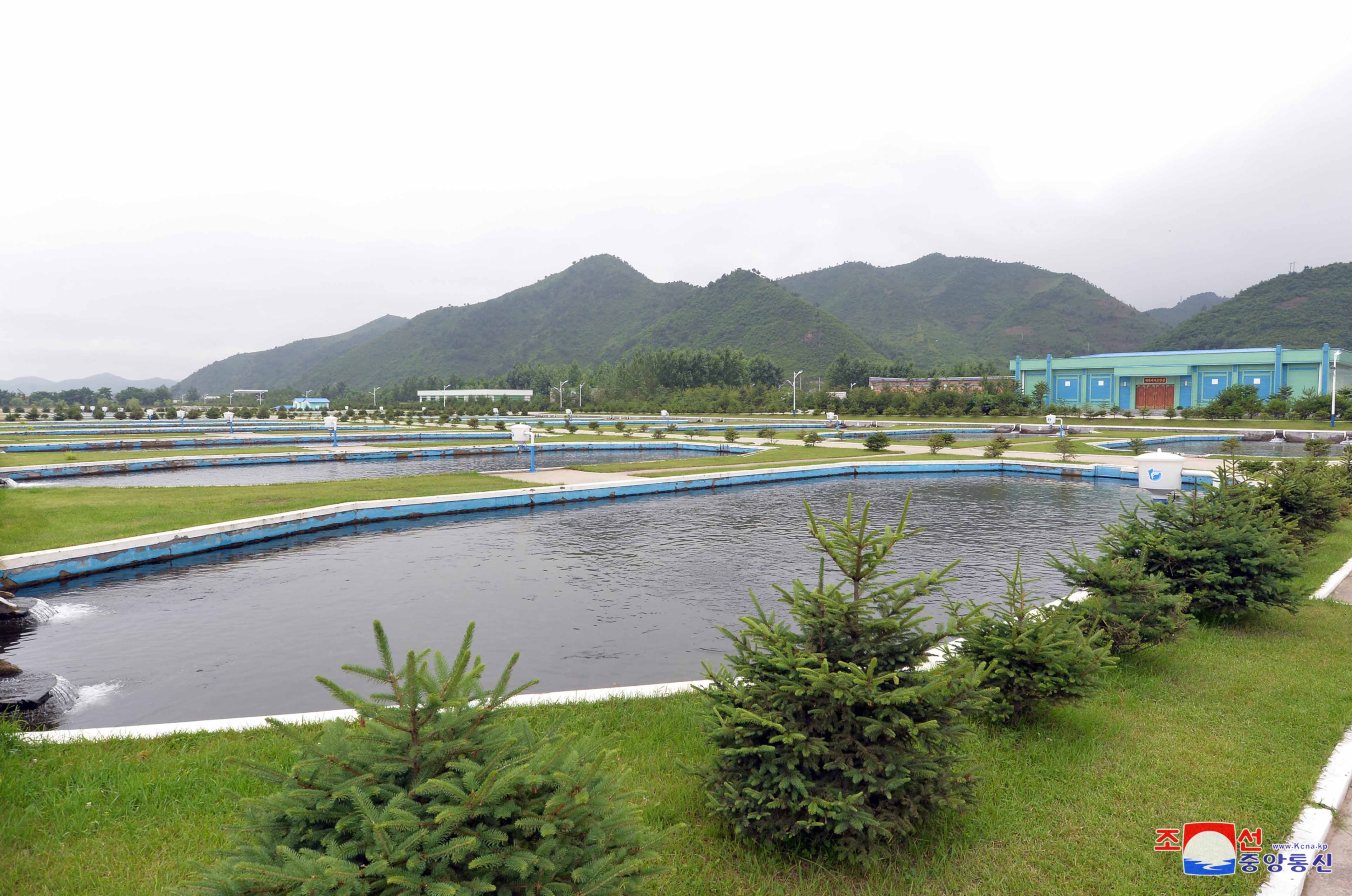
The workers also “rebuilt the modern fattening ground in a hygienic and anti-epidemic way to raise the survival rate of fry salmon, remodeled 54 concrete fishing ponds at six indoor blocks into resin ones and settled the problem of disposing waste water to decisively decrease the death rate of fish.” In addition to that, “they newly build a superfine grinder, bulking feed plant and 1000-ton feed storehouse and established a system of feed production by antibiosis.”
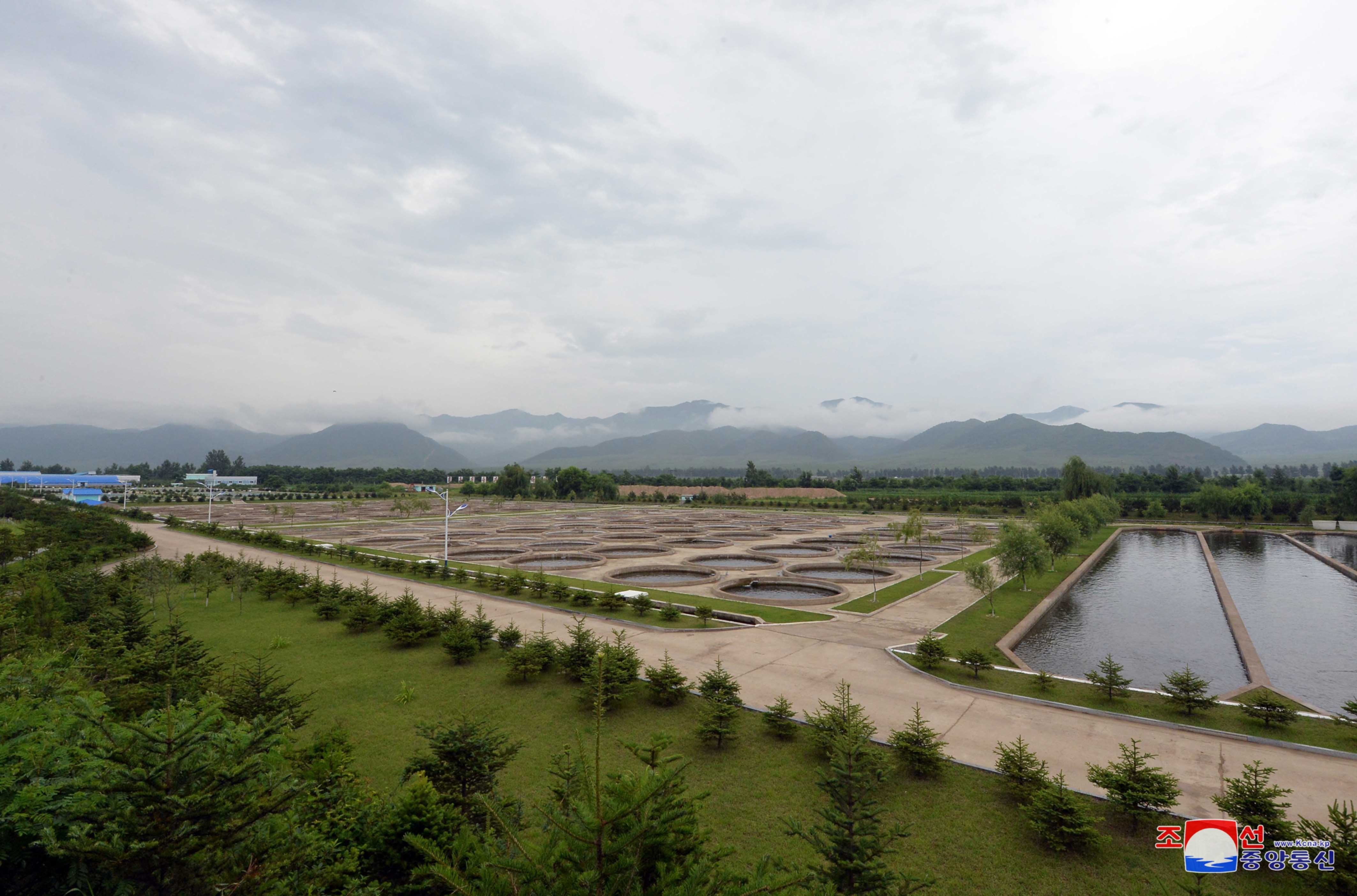
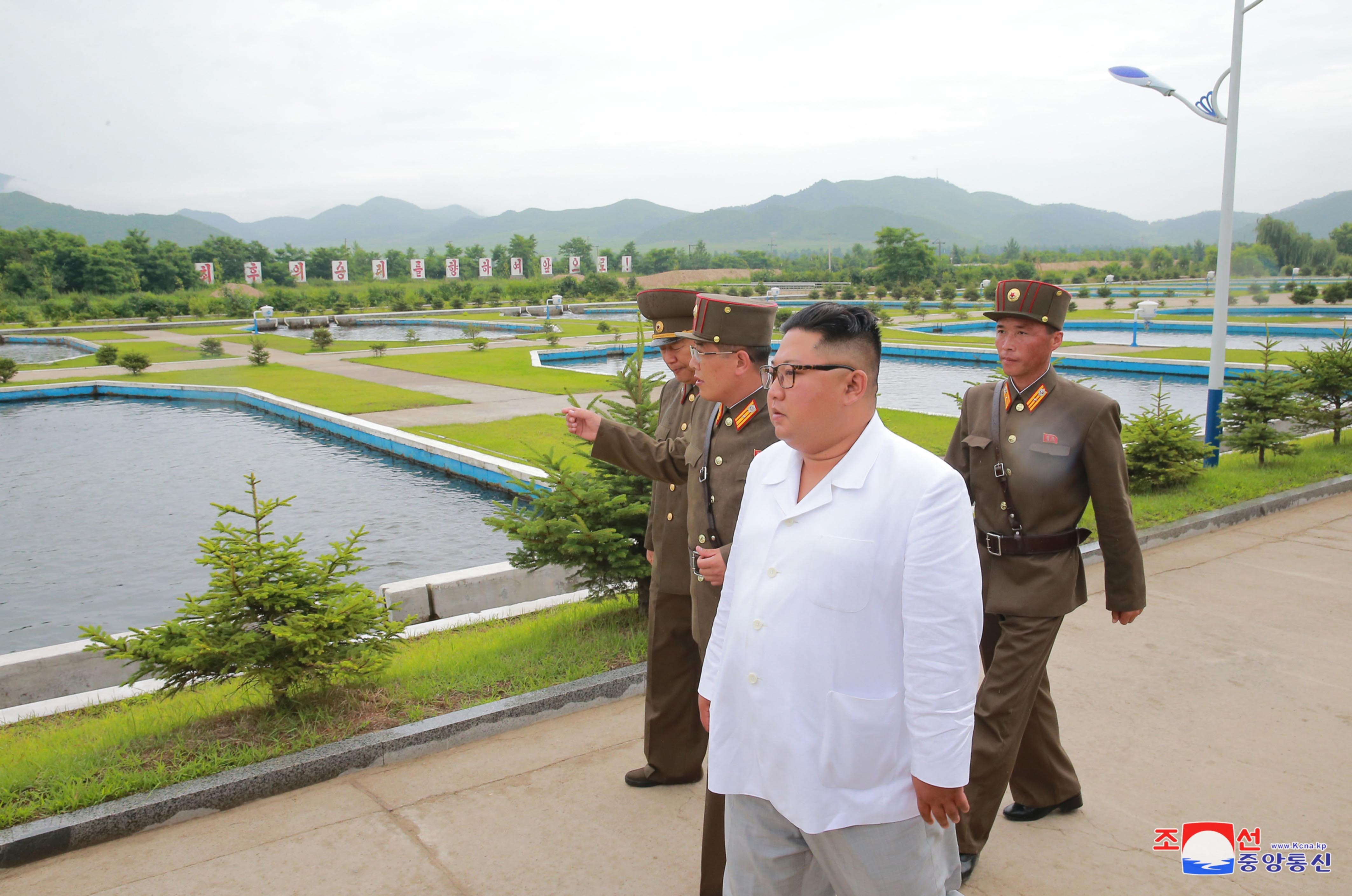
Appreciating these accomplishments, the Suryo’ng said it “is very admirable that our scientists established a technique for preventing the group death of salmon fries and thus made it possible to breed hundred of thousands of salmon fries at sea this year.
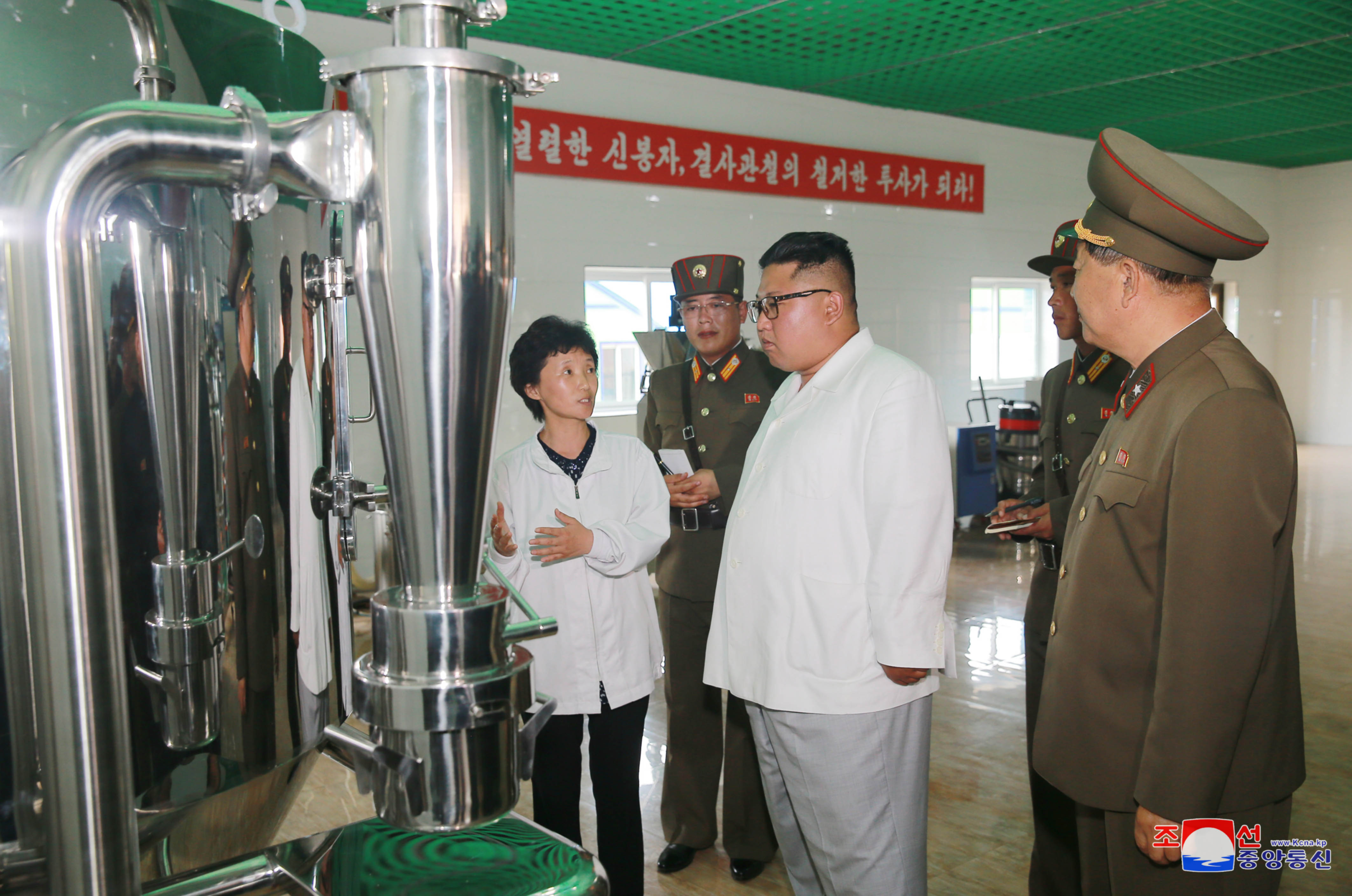
Now it is possible to further activate the culture of salmon given enough material and the technical foundations for safety production of Atlantic salmon and increase the level of its scientification and modernization.” He expressed “great pleasure over the appearance of a promising delicious fish producer in the country.”
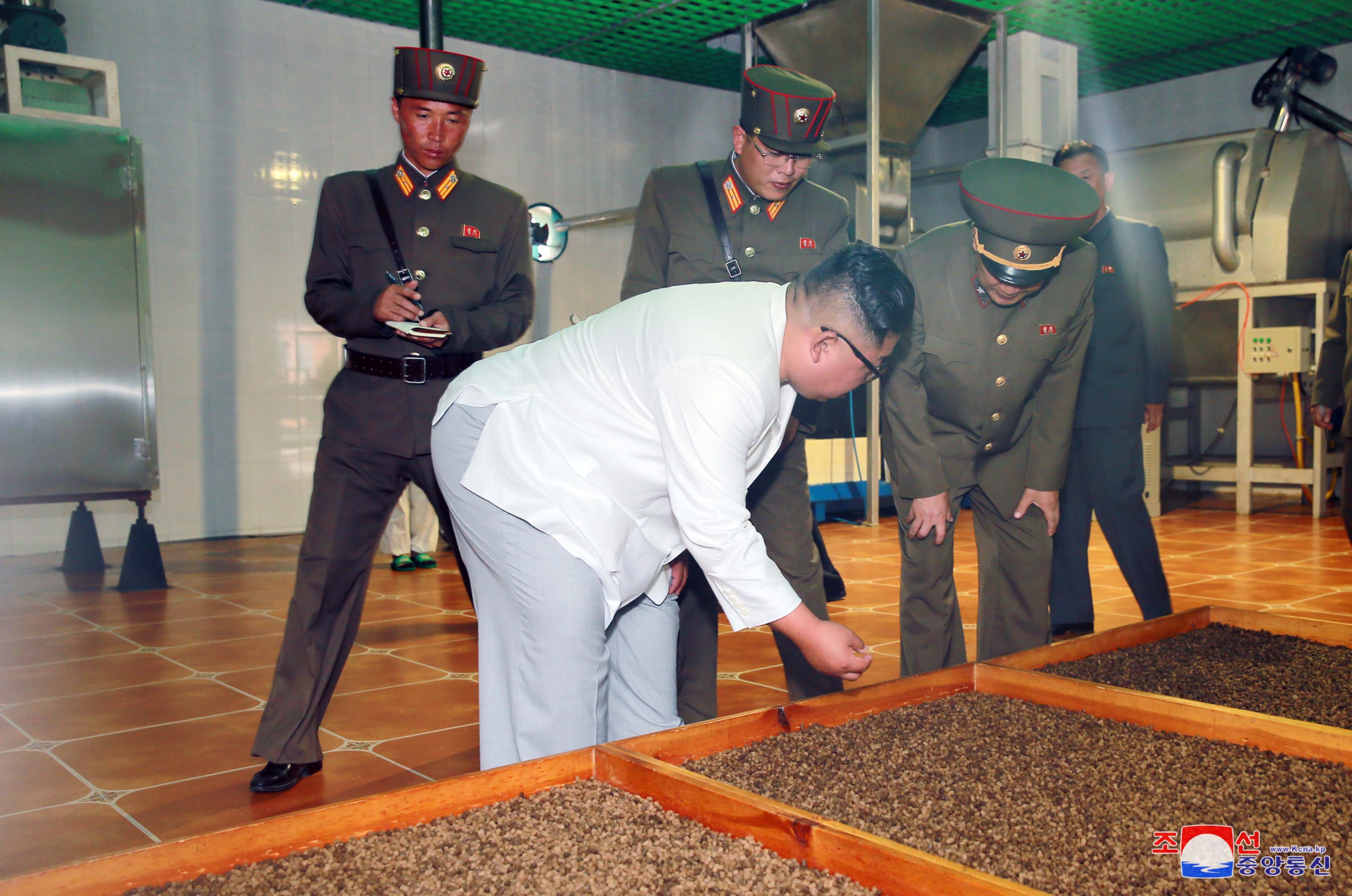
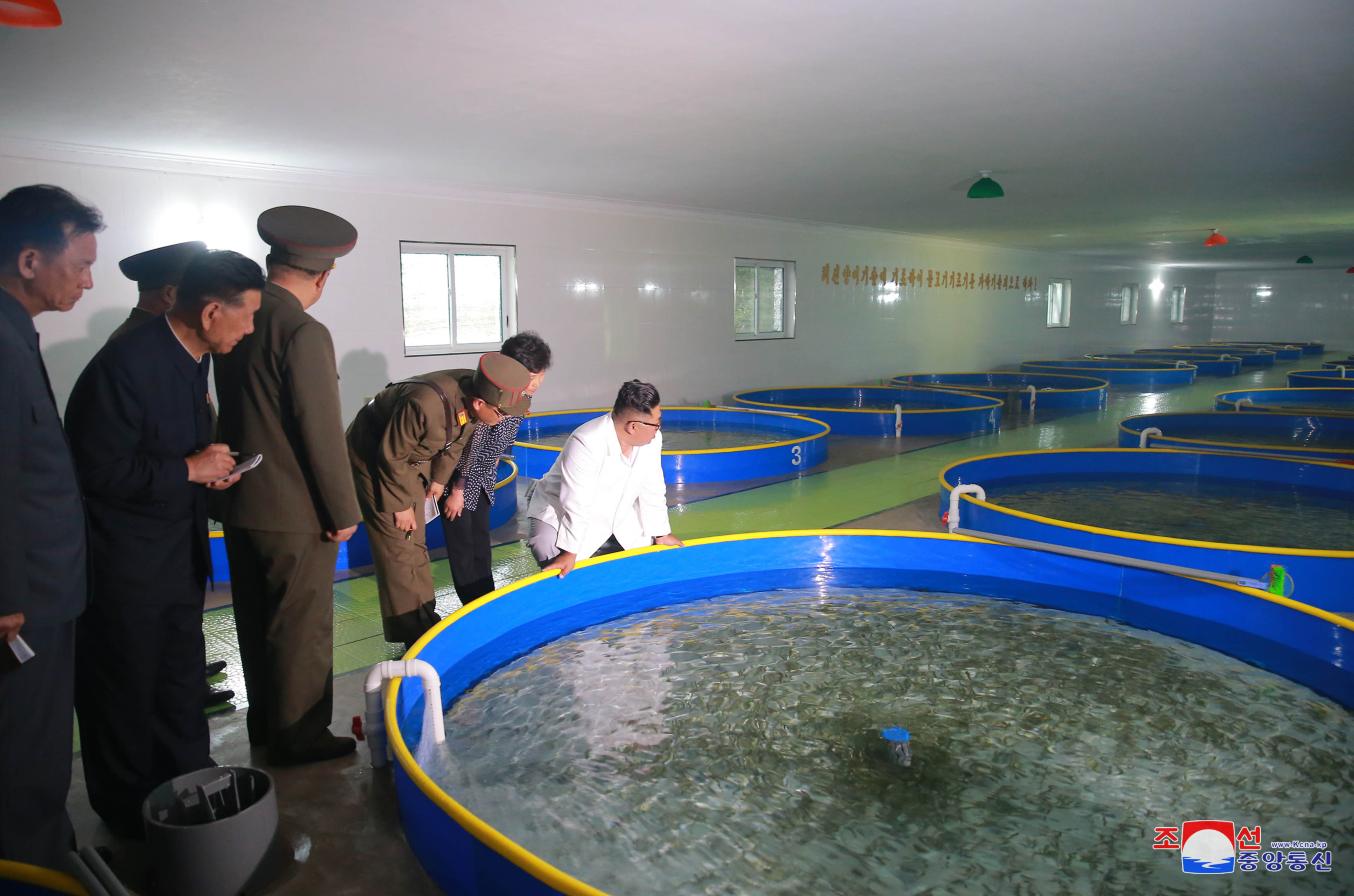
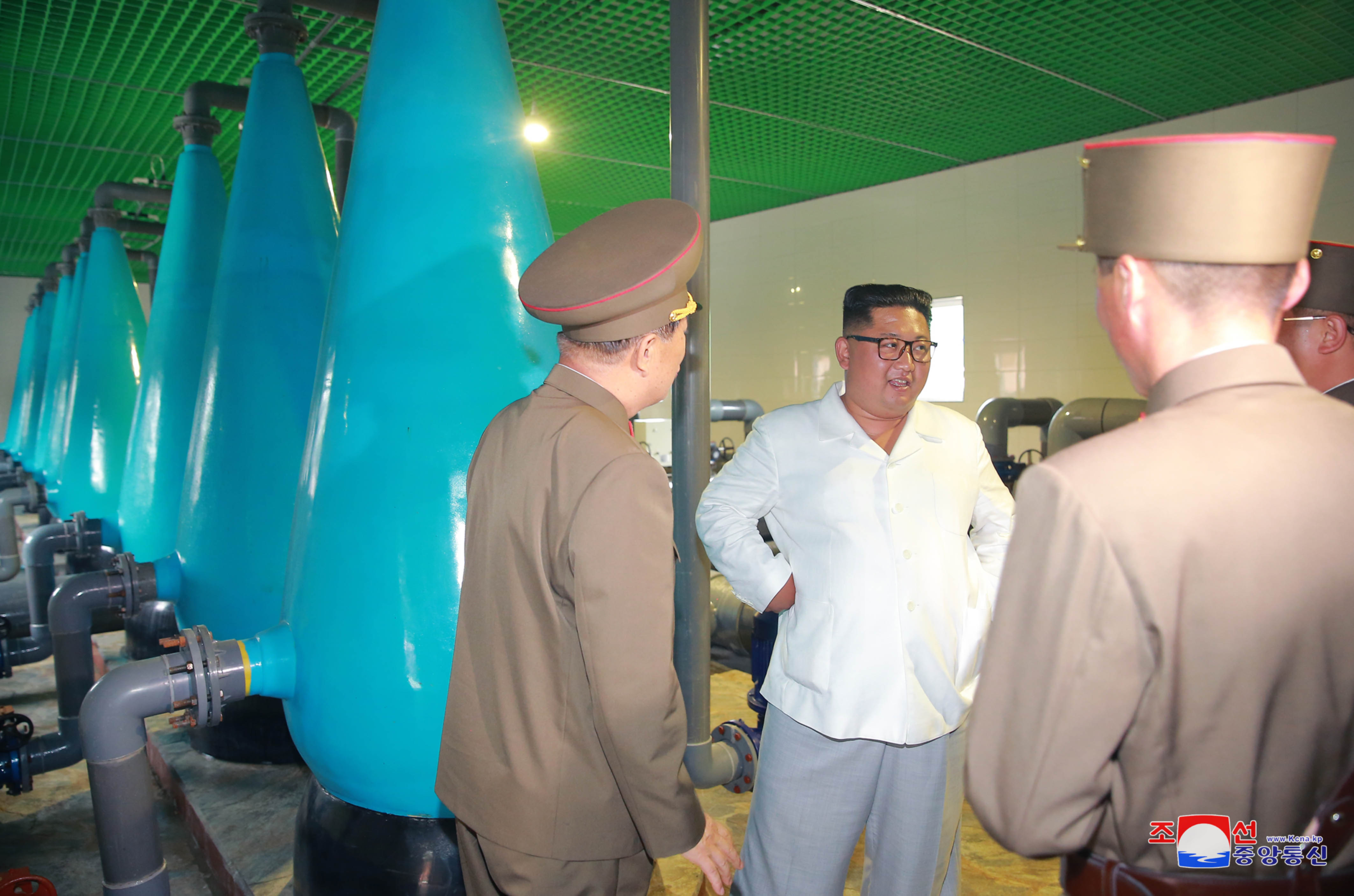
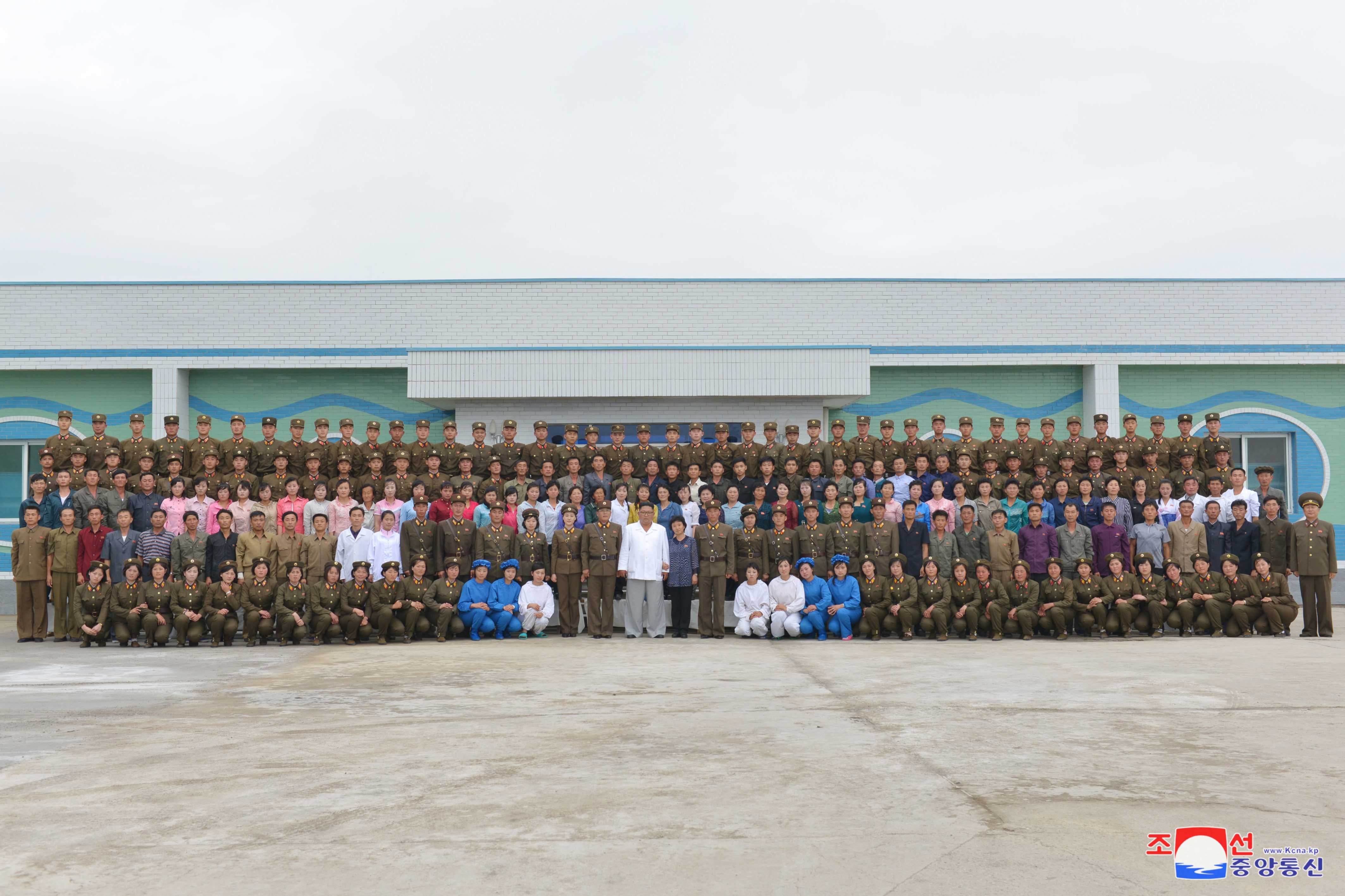
Kim Jong Un posed for commemorative photos with the managers and employees of the fish farm and expressed his “expectations and belief that they would be a model of the country in implementing the WPK’s pisciculture policy by steadily adding to the achievements under the banner of putting the fish farming on a Chuch’e, modern, scientific, industrial and intensive basis.”
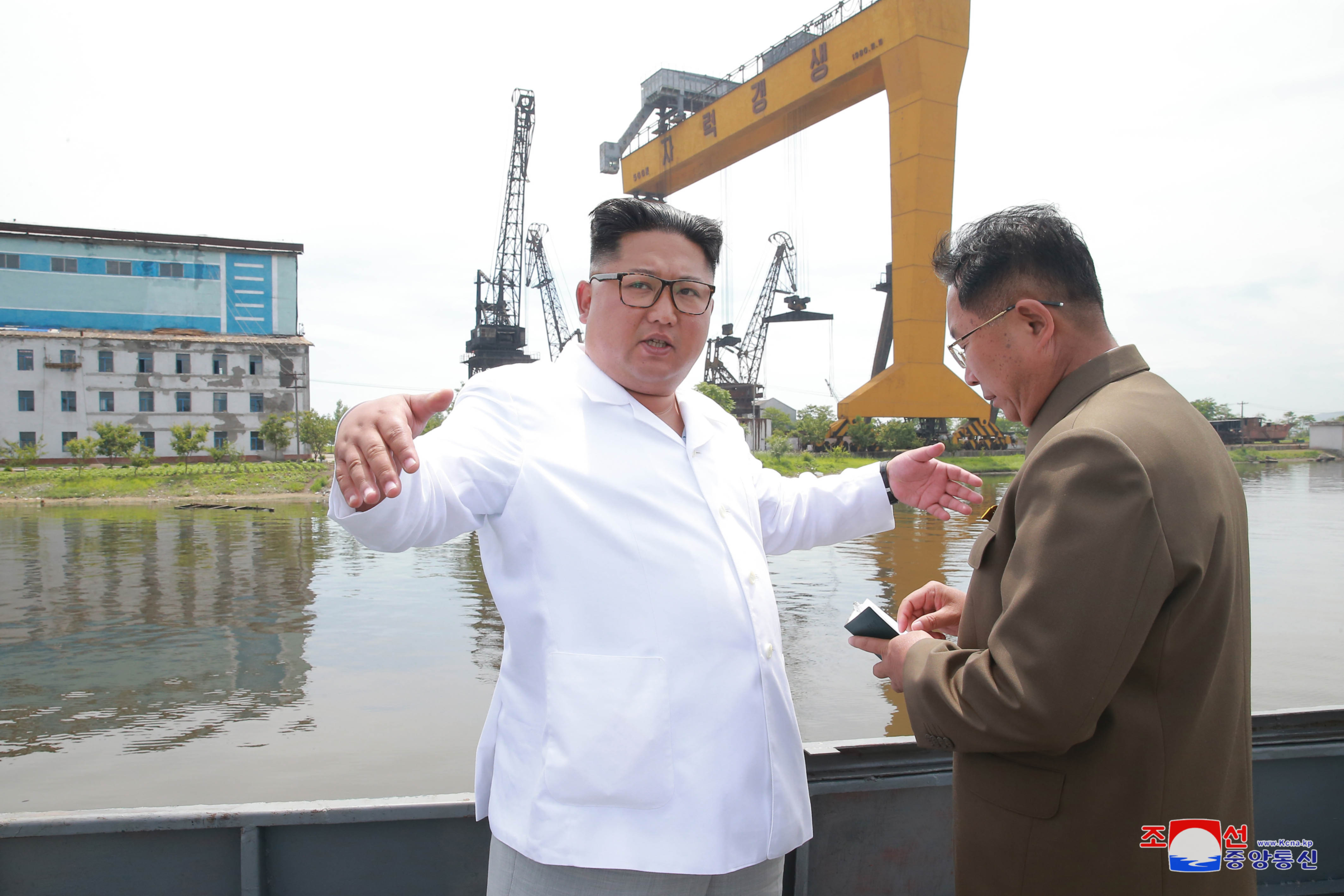
Jong Un provided on the spot field guidance to the Ch’o’ngjin Shipyard. He toured the revolutionary history room and remarked that the shipyard’s officials and workers “should create new miracles and innovations in shipbuilding to glorify the undying leadership exploits of our Party by carrying forward the baton of loyalty and self-reliance recorded in the proud development course of the shipyard with great pride and honor of working at the glorious workplace visited by President Kim Il Sung (Kim Il-so’ng) 12 times and by leader Kim Jong Il (Kim Cho’ng-il) six times.”
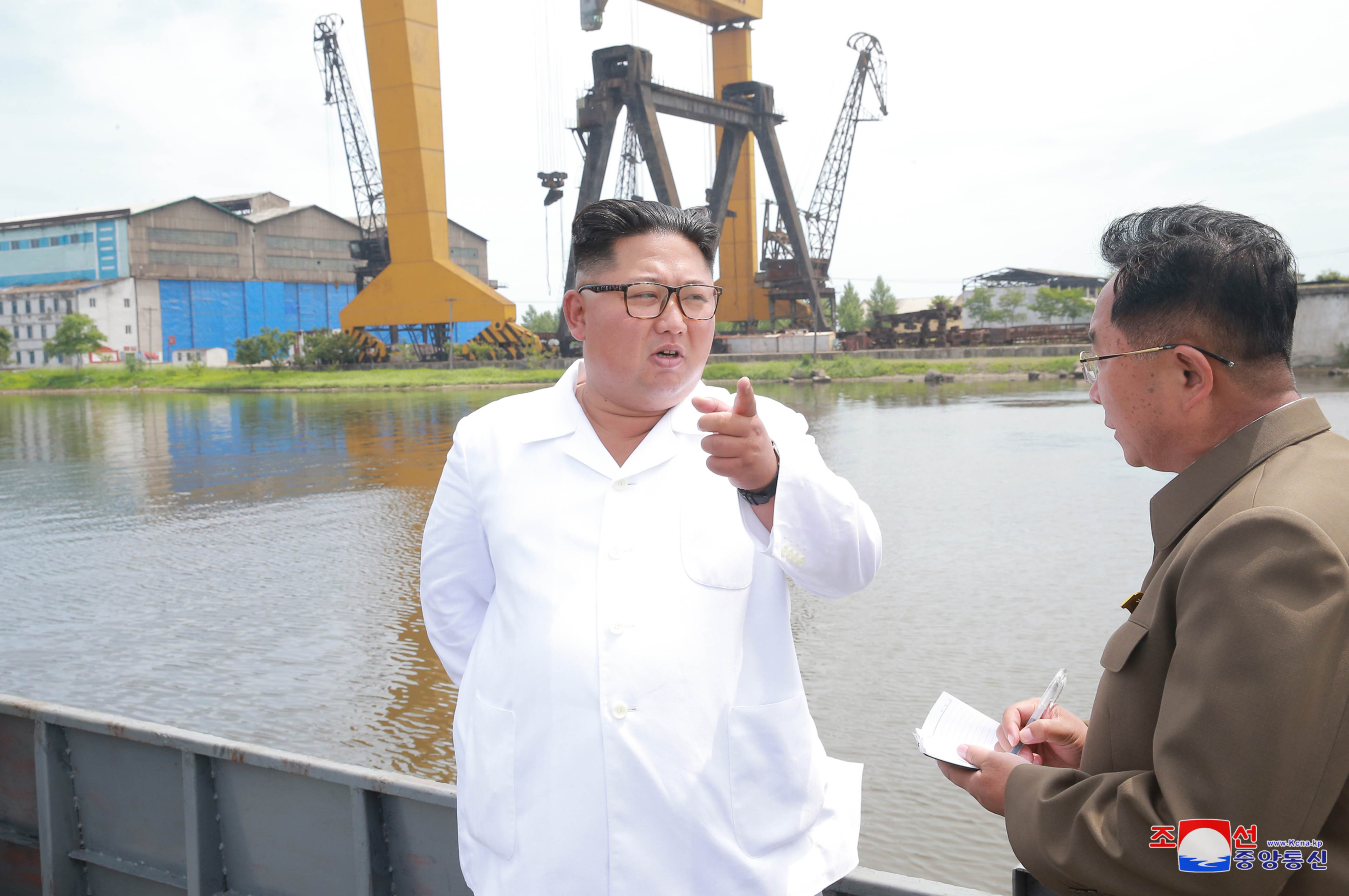
He was briefed about the shipyard’s operations and working conditions as he went around an anchor chain ship inspected by KIS and KJI. He was also briefed with “the structure and tactical and technical specifications of a newly built warship and its weapons and equipment.” Jong Un boarded the new warship for a trial navigation and “praised the workers of the shipyard for having successfully built the warship with excellent mobility and firepower capability to strengthen the People’s Navy by fully displaying the revolutionary spirit of self-reliance.”
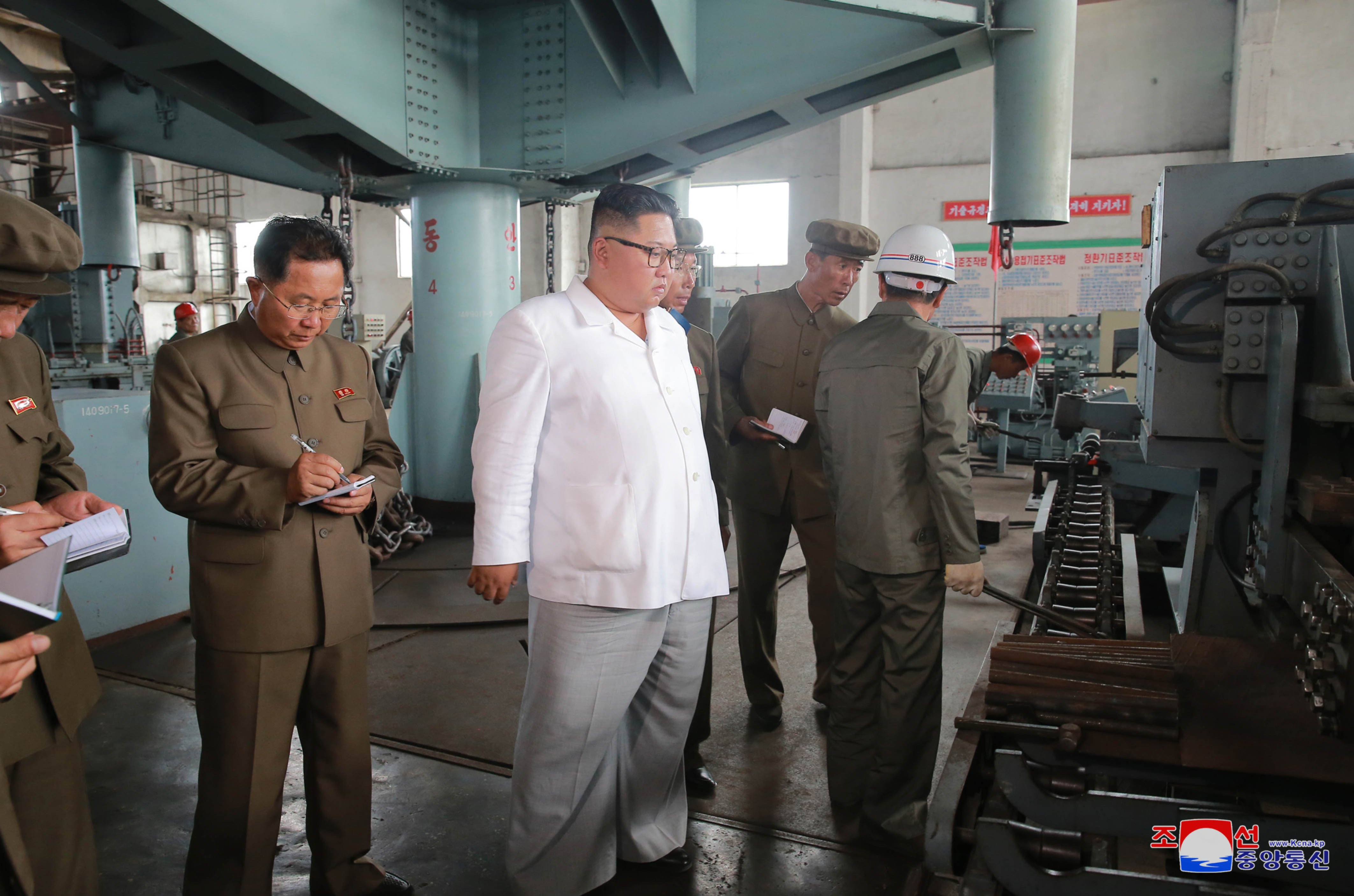
Jong Un said that the “Ch’o’ngjin Shipyard is able to build various ships better in the future as it has a history of shipbuilding and high technology” and he indicated “detailed tasks to further modernize the shipbuilding process.” He noted “with firm belief in the workers of the Ch’o’ngjin Shipyard” and “decided to entrust it with the building of a newly planned modern cargo-passenger ship.” He said that the “shipyard can easily carry out this task as it had already experienced building the ship Mangyo’ngbong-92.”
He added that the “shipyard should launch and conduct the work in a bold and revolutionary way and, in this course, further develop its shipbuilding technology and put the production processes on a scientific and modern basis of high level and thus take the lead in bringing about a great leap in the development of the country’s shipbuilding industry.” Jong Un expressed his “belief that the officials and workers of the Ch’o’ngjin Shipyard would perform shining feats in the struggle to attain the new goal set forth by the Party and creditably live up to the expectations of the Workers’ Party of Korea Central Committee.”
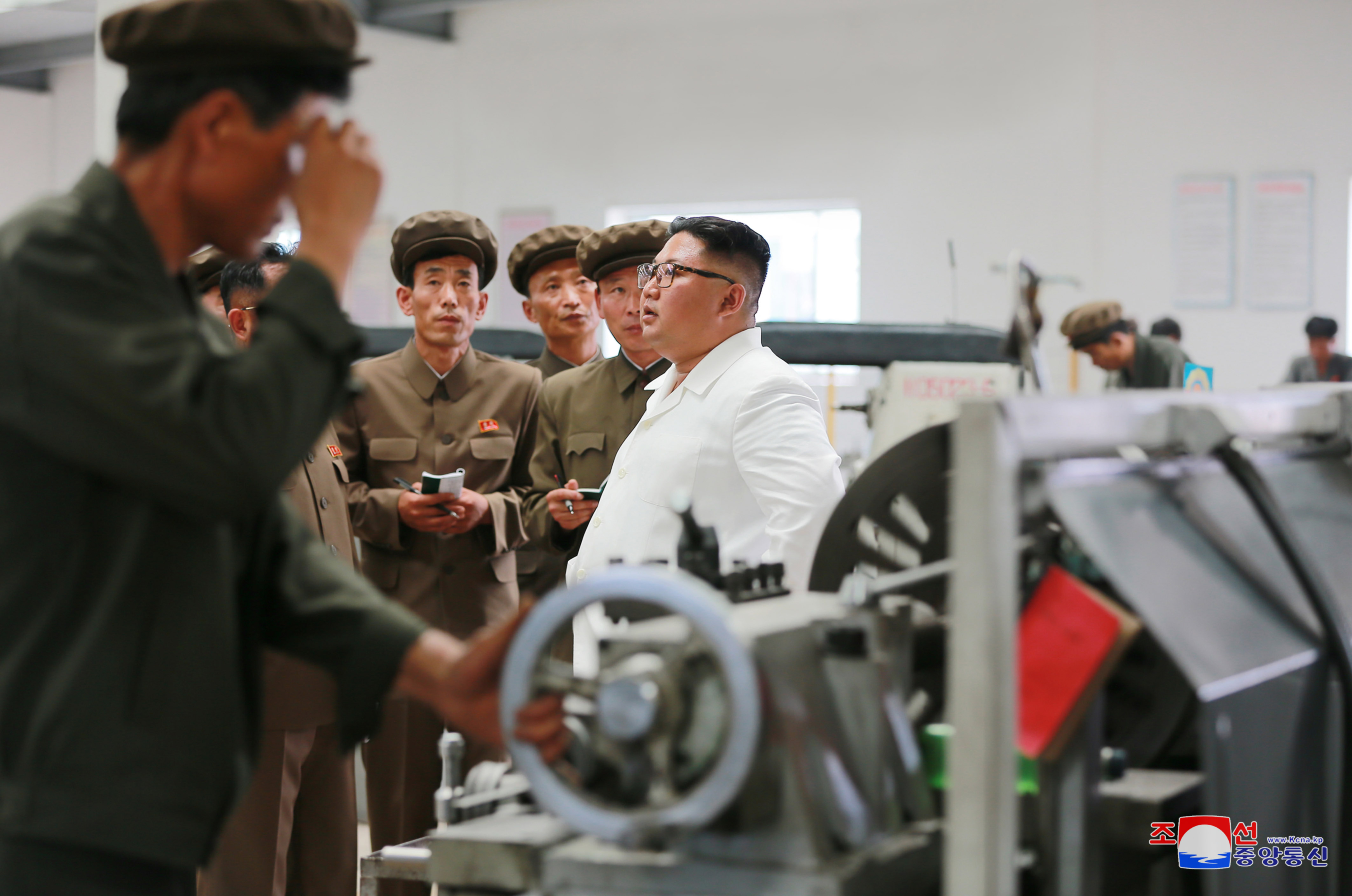
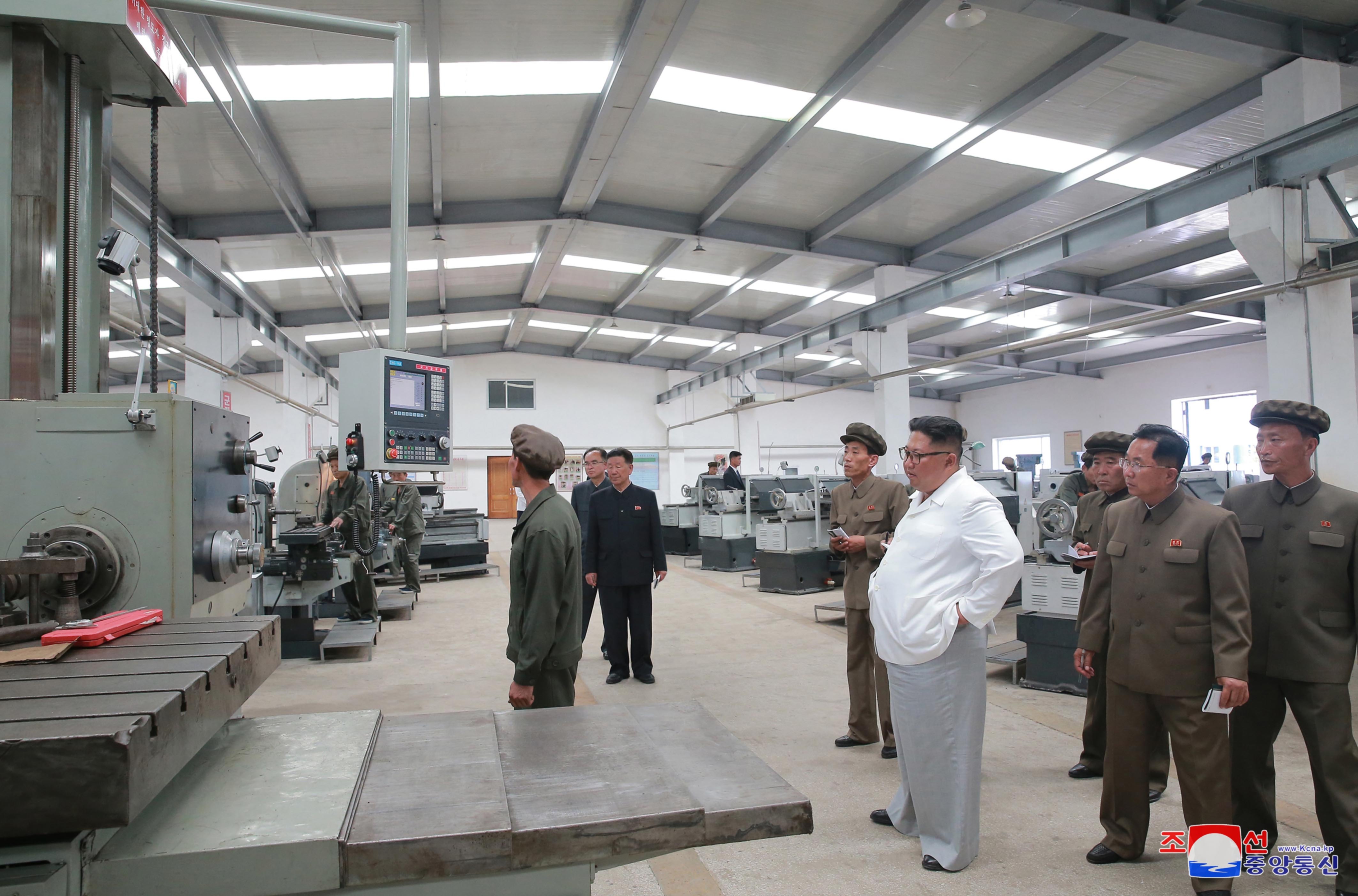
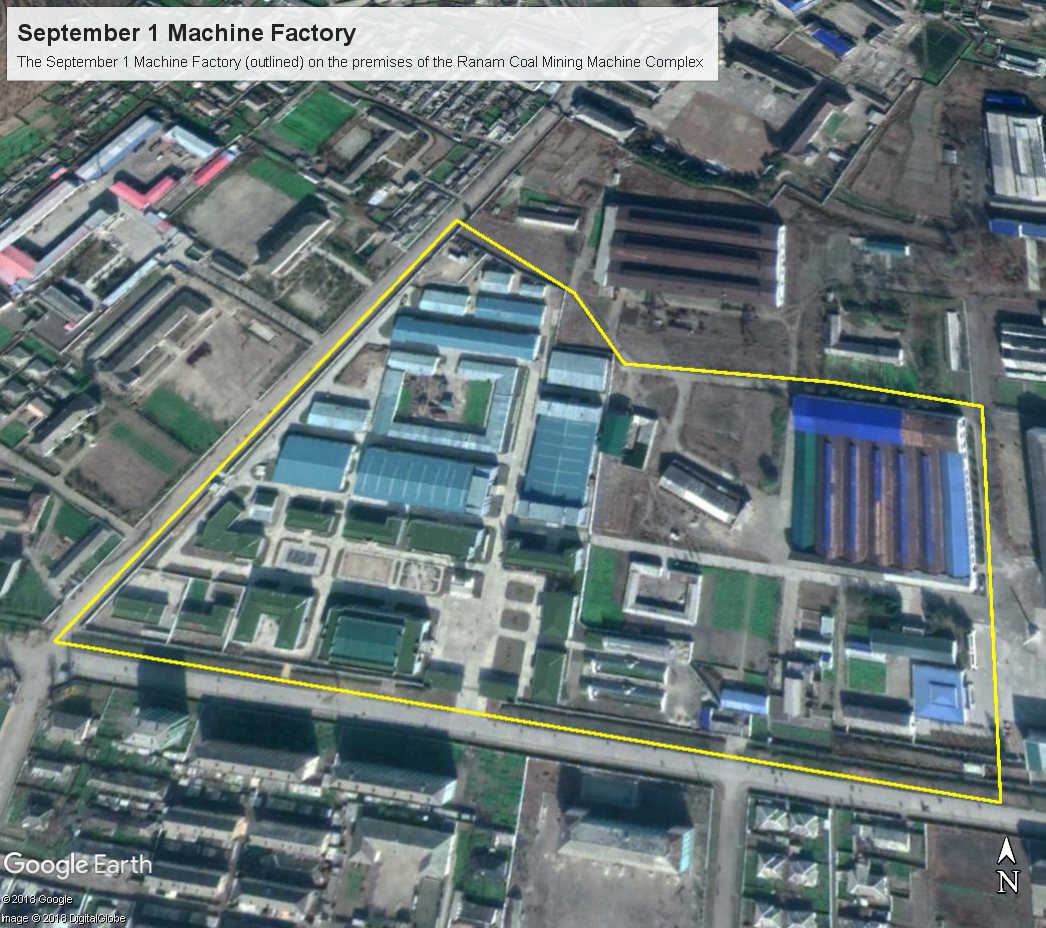
Kim Jong Un provided guidance to the September 1 Machine Factory of the Ranam Coal-mining Machine Complex. He was briefed about the production of the machine factory, touring the revolutionary history education room, a science-technology learning space, machine assembly area and other locales. He praised the workers for “having conducted a fierce offensive to build modern buildings for production and life and spruced up the inside and out of the factory.” He stressed the “need to continuously push ahead with the technical updating of production processes and equipment as well as regular management of production buildings.”
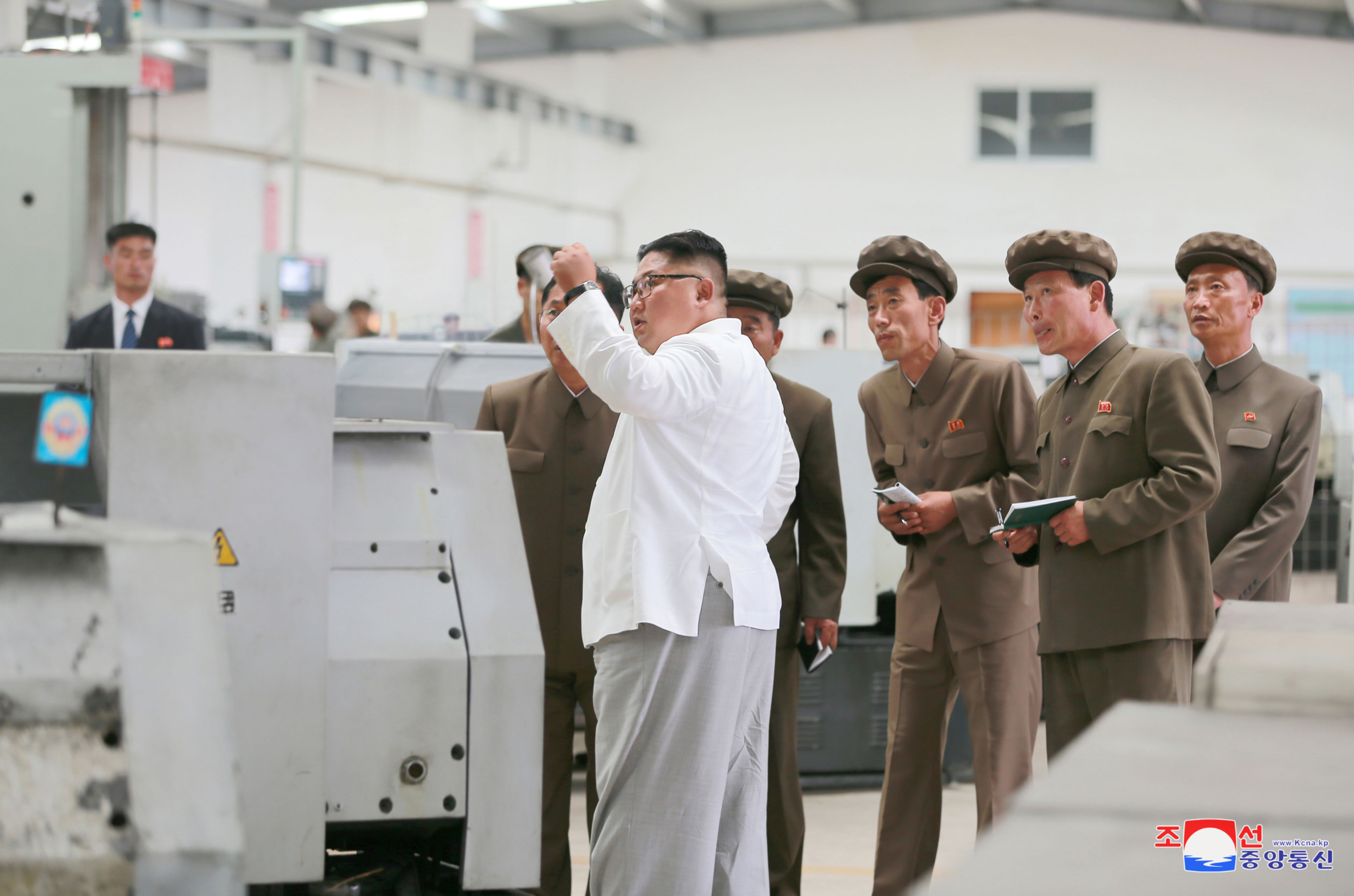
He said that, “it is necessary to bring science and technology close to production and work out a plan in a bold and big way and stubbornly carry it into practice at the factory and thus further consolidate its material and technical foundations so as to produce machines requiring high technology.” He noted that the “sci-tech learning space should be arranged better and study-while-working habits thoroughly established at the factory so that all its employees can master machine equipment and fully arm themselves with the modern science and technology to radically increase the quality of the machines.”
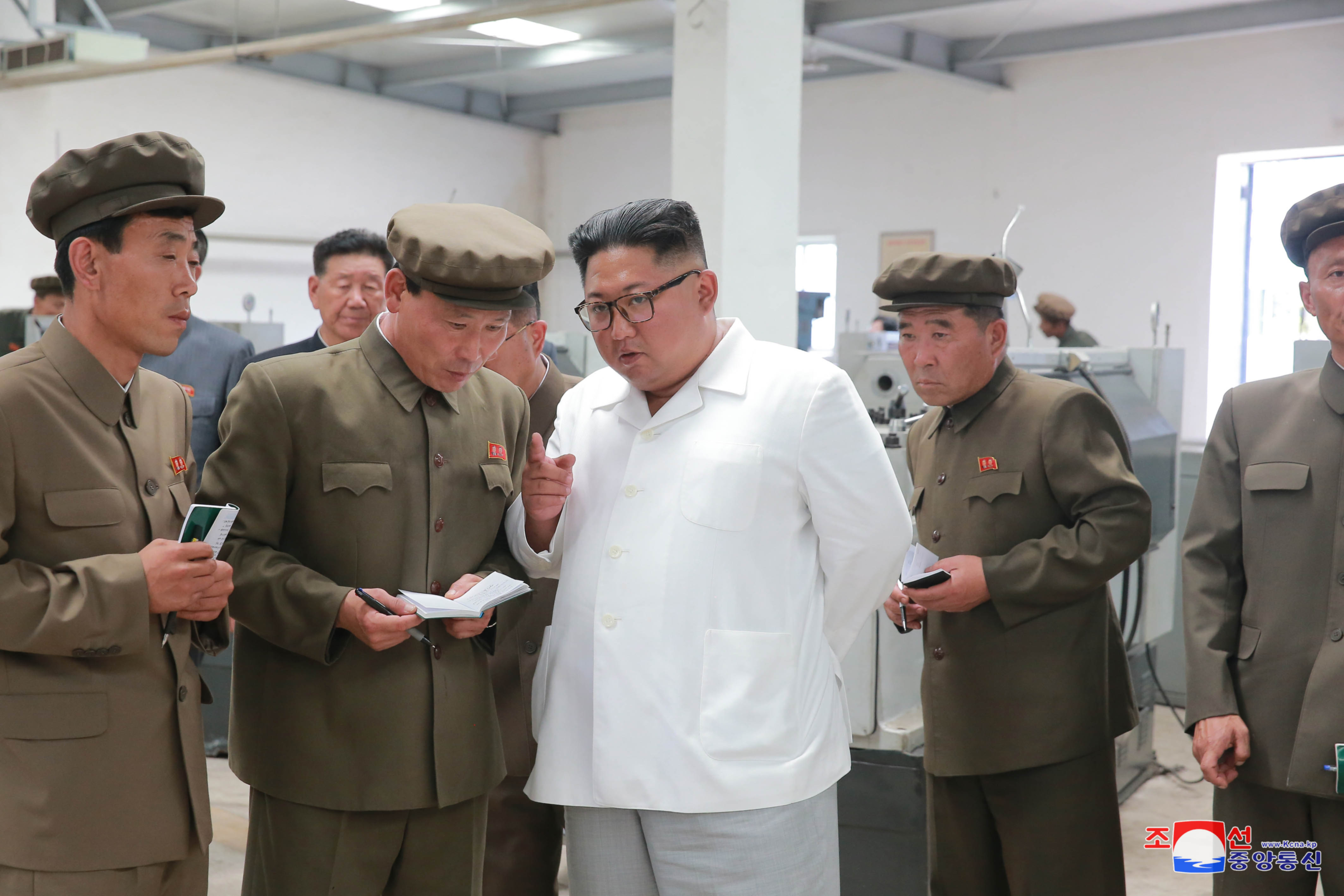
Jong Un said the “factory should pay attention to improving the supply service for employees and providing them with good material and cultural living conditions to bring about a great upsurge in production” and the “factory’s duty and role are very important” and then issued “tasks and ways for developing the factory into a leading machine producer.”
He posed for commemorative photographs with the managers and employees of the September 1 Machine Factory and expressed his “belief that they would bring about a fresh leap in the production of high-efficiency and modern machines of various kinds urgently needed for different field of the national economy and make positive contributions to the development of machine-building industry of the country.”
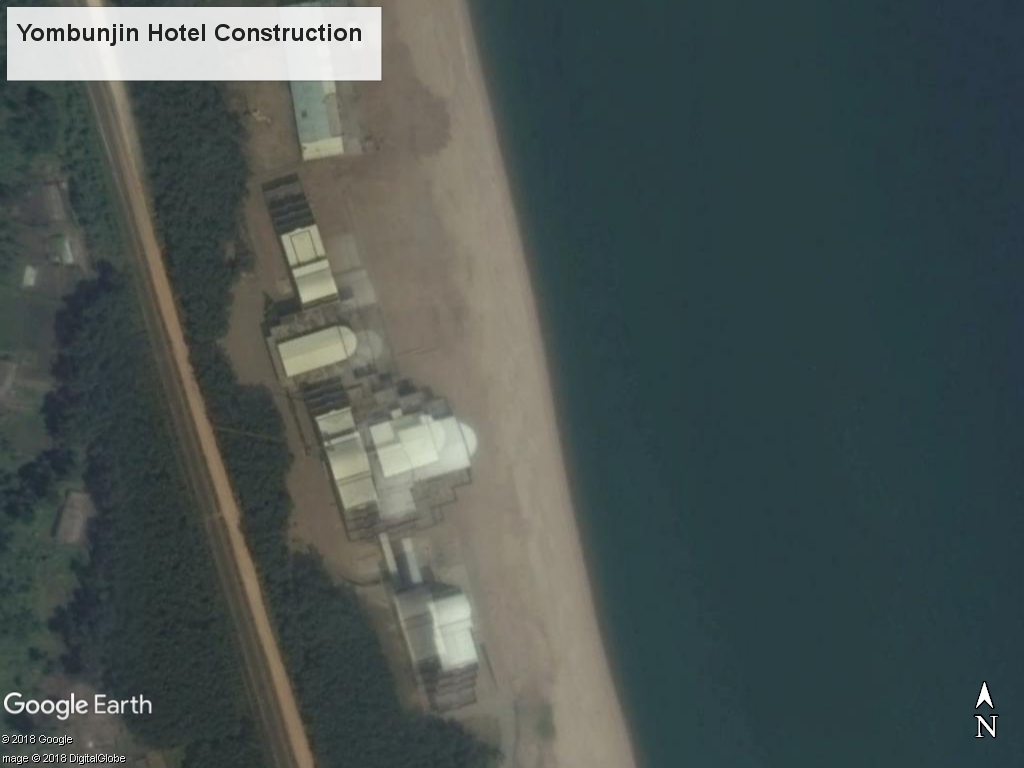
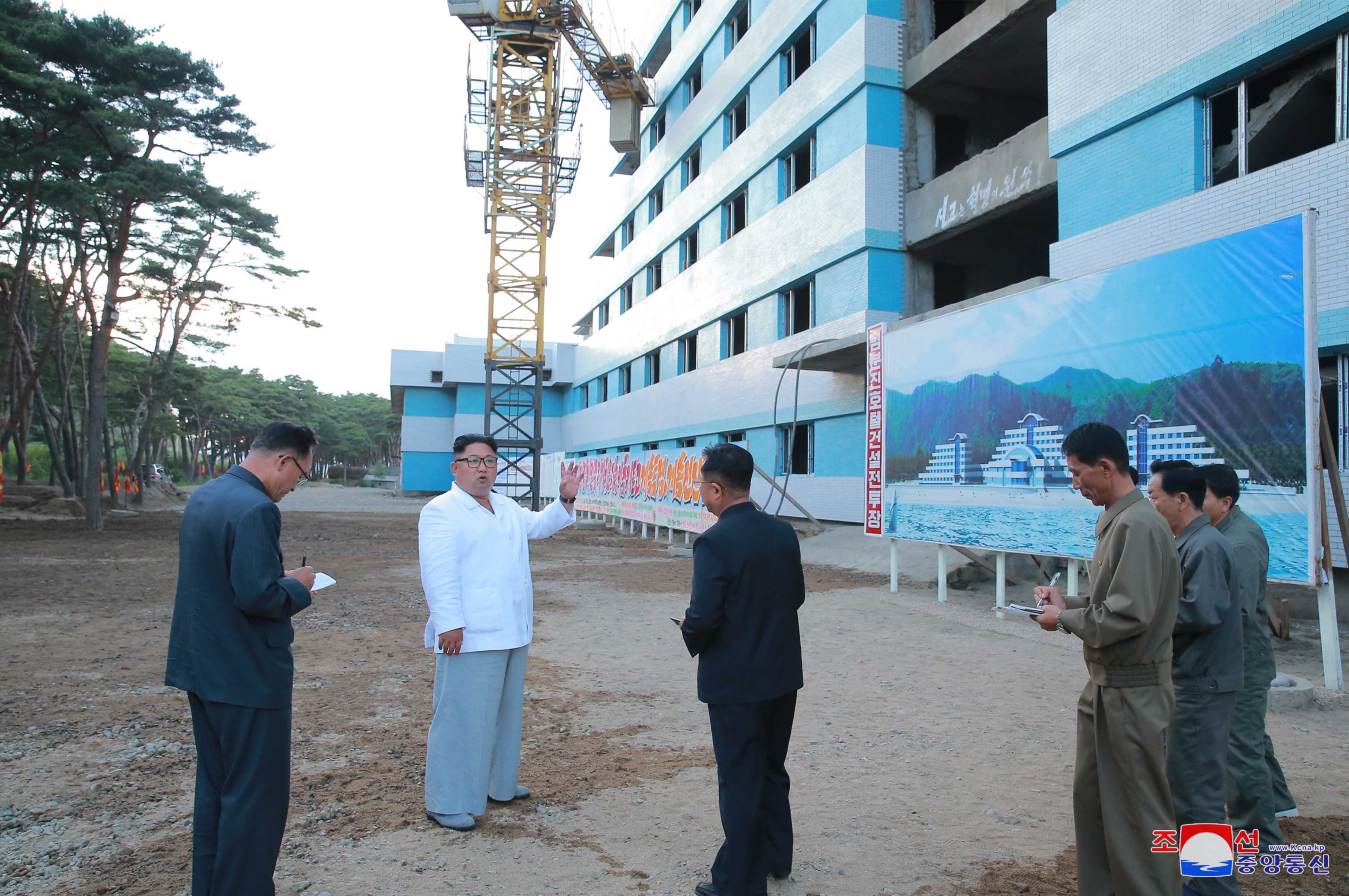
Kim Jong Un visited the Yombunjin Hotel, which has been under construction since 2011. He referred “to the fact that the plastering of the inside of the hotel has not yet been finished though six years passed since the completion of its framing project.”
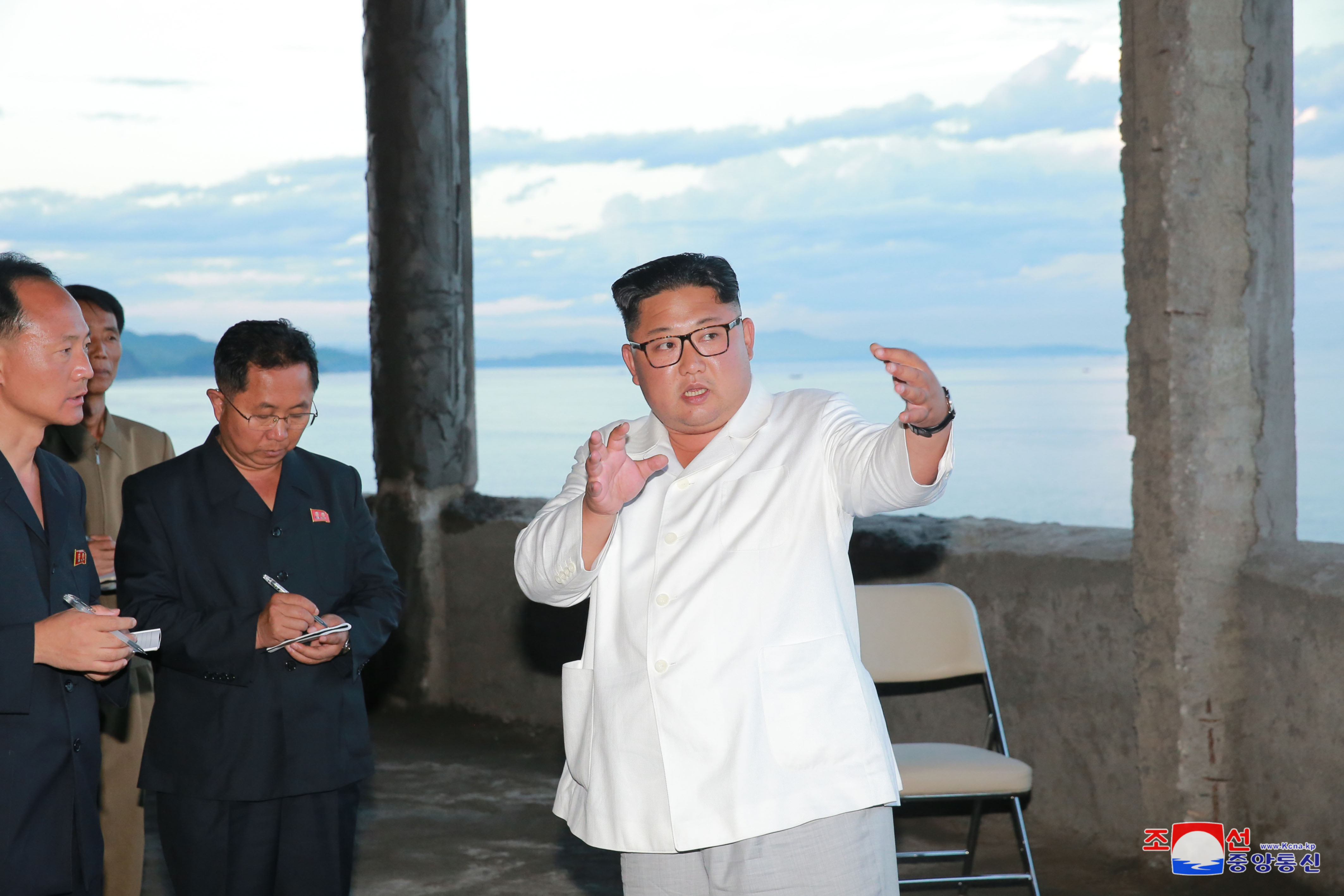
Jong Un called for taking a “decisive measure to quickly complete the construction” and said that “although leader Kim Jong Il chose the site of the hotel in the picturesque Yombunjin shore and paid attention to the construction till the last moments of his life while learning about it time and again, the project has not yet been finished and that it is a big mistake to delay the construction at a time when the entire Party is concentrating all its efforts on implementing the behests of President Kim Il Sung and leader Kim Jong Il while taking it as the main line and as lifeline.”
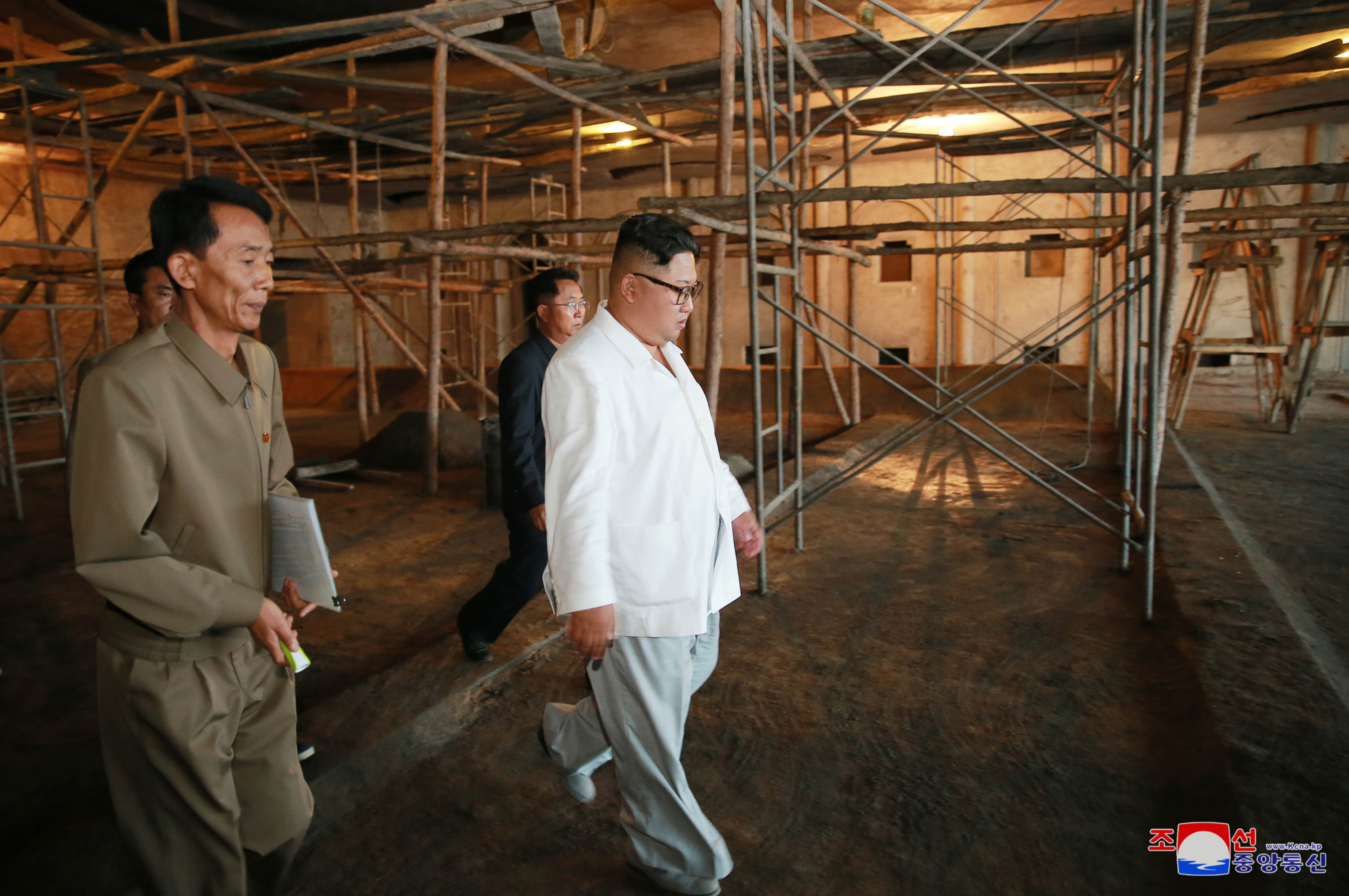
He indicated the “construction orientation and ways to turn the Yombunjin area into a wonderful resort for the people, saying that the Party will take a step for supplying funds and materials and the North Hamgyo’ng Provincial Party Committee should encourage the officials and builders of the province to the campaign for implementing the behests of the leader so as to build the hotel by Oct. 10 next year and the make a loyalty report to Kim Jong Il.”
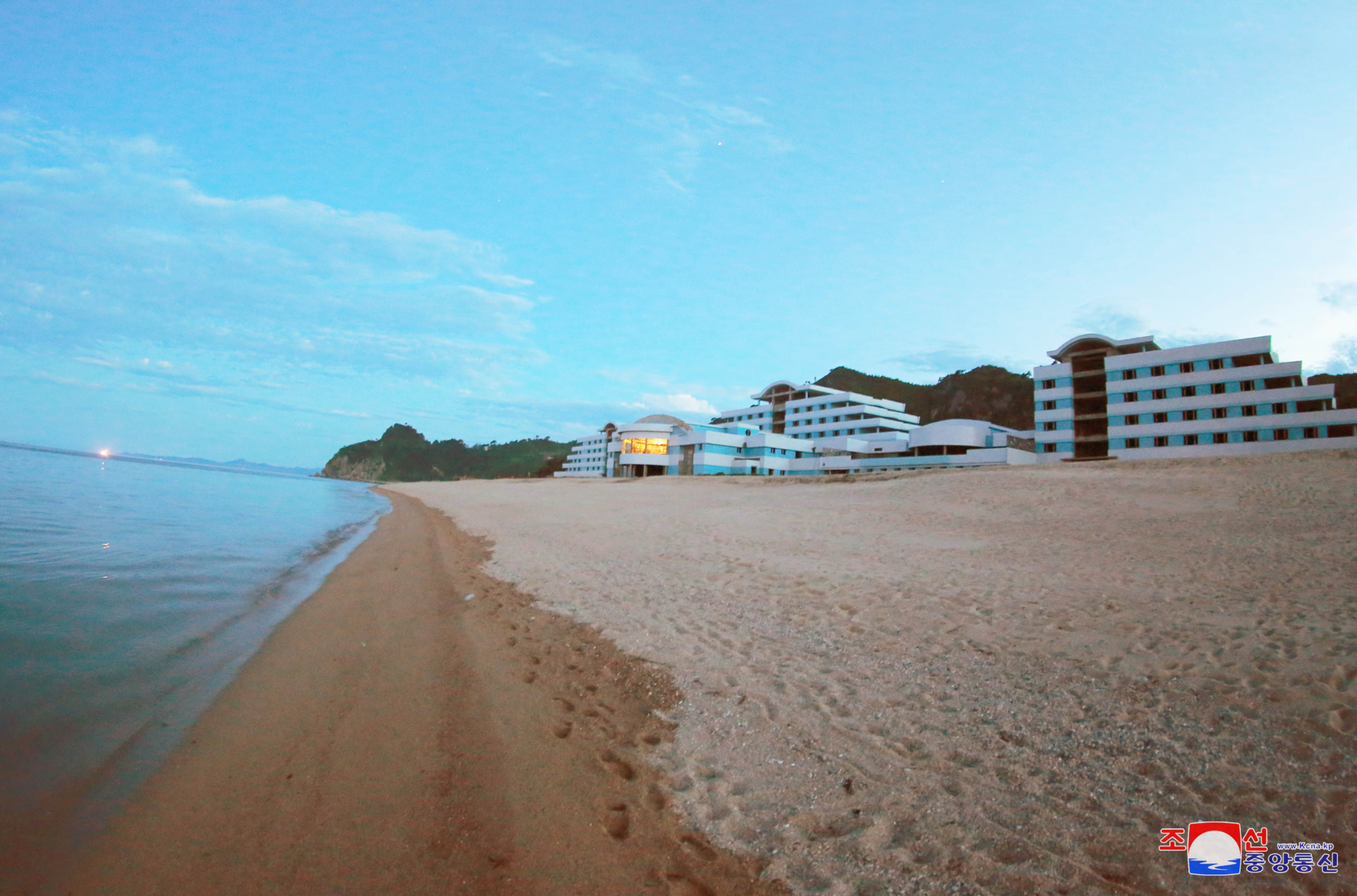
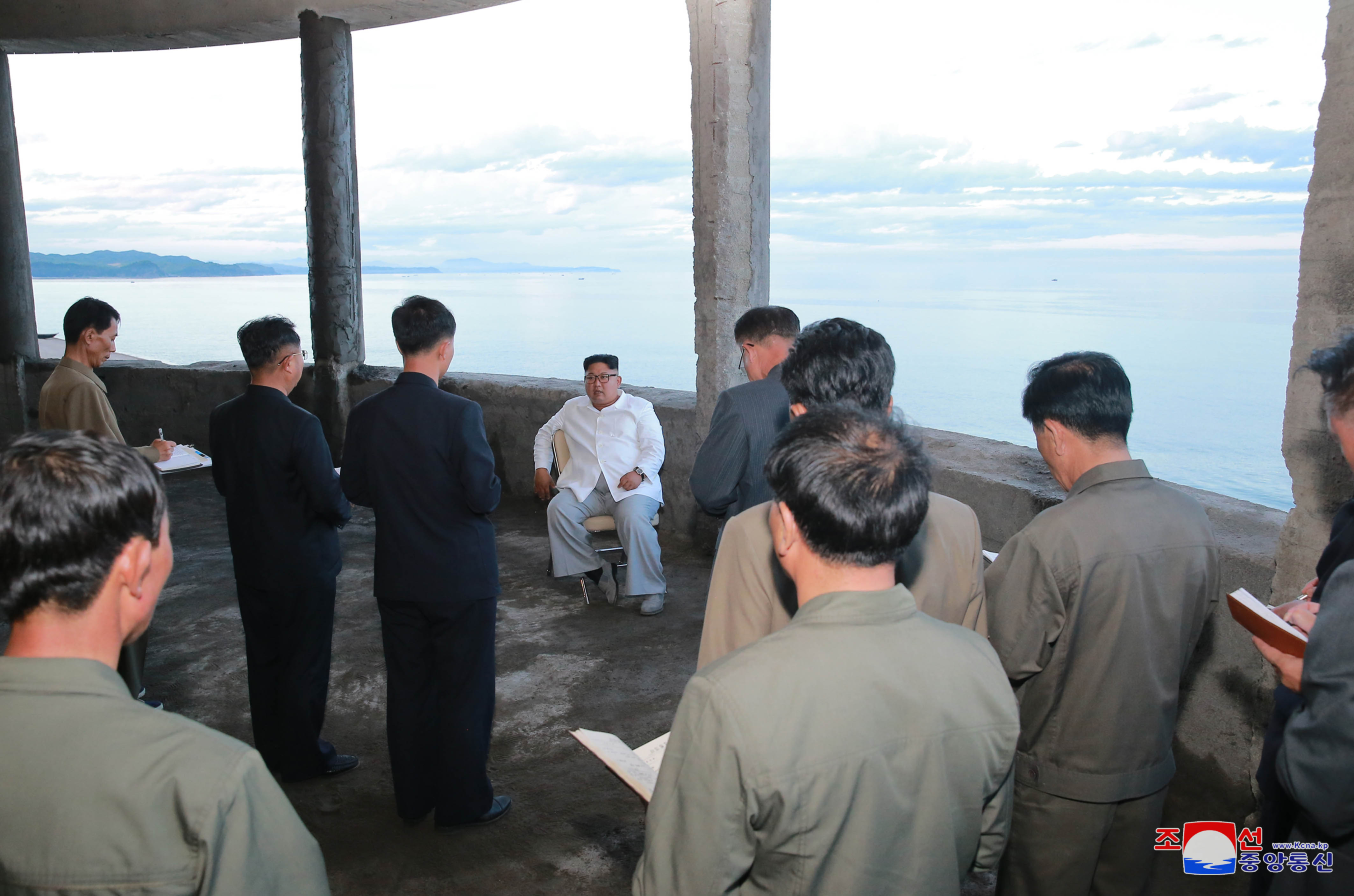
Jong Un said that “Yombunjin is an ideal place for the people to take cultural rest anytime as its seashore scene is unusually beautiful and it has good traffic conditions as it is located near railways, shipping lane and roads” and he “stressed the need to turn the area into the Yombunjin coast park of unique style by building more lodging quarters and service facilities of various forms and purposes in the section of more than 600 meters along the shore around the hotel.” He pointed out that the “ground design for exterior of the hotel is not good and its accommodation capacity is small” and issued “instructions for the central and provincial designing forces to make an overall examination of the design and redesign it in keeping with modern tastes from a new angle with their concerted efforts.”
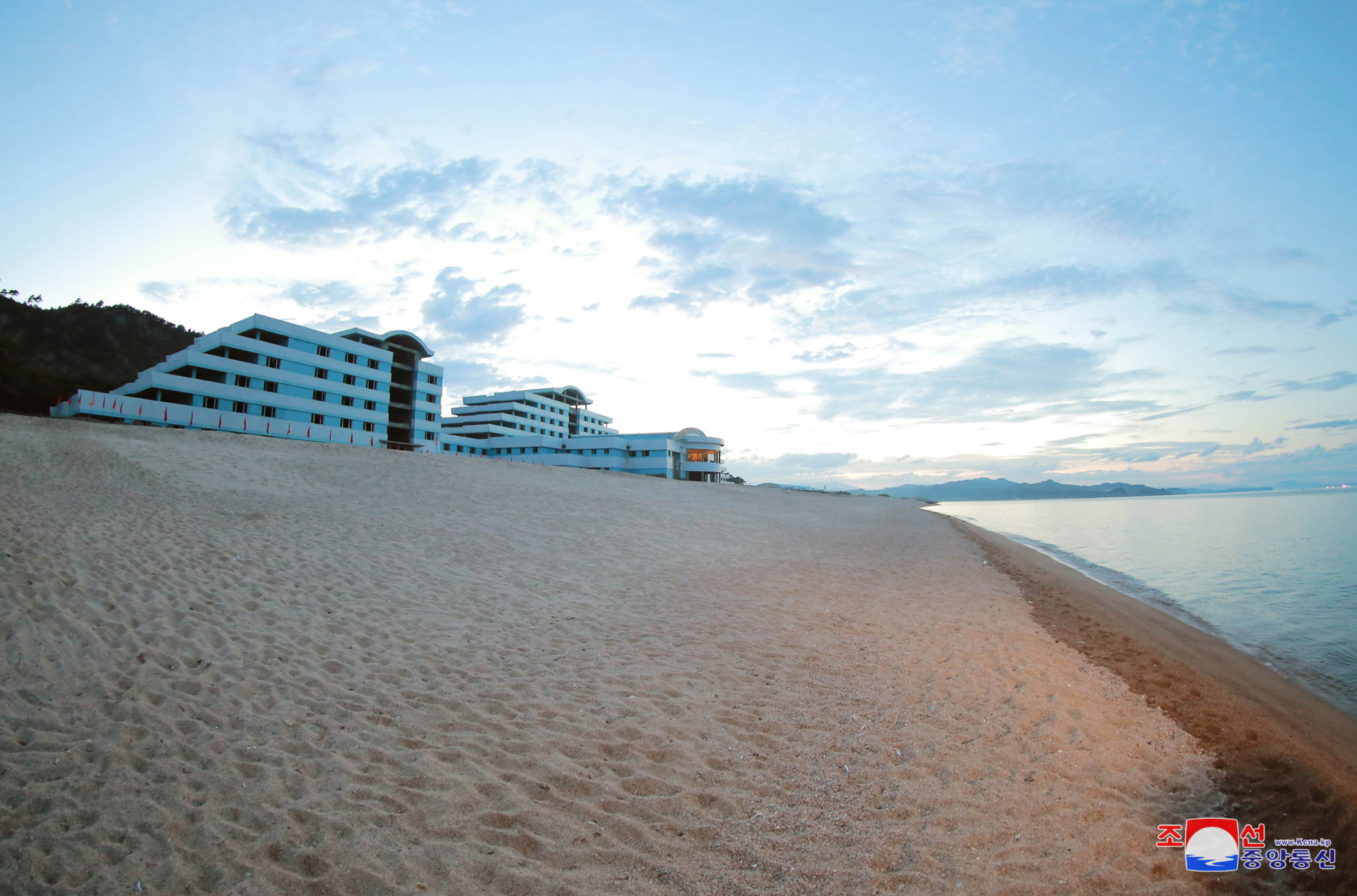
The Suryo’ng said that he would send professional technical forces of national institutions to help the province conduct the finishing construction of the hotel with its own efforts” and stressed “that the province should strengthen and develop its designing and building forces in this course.”
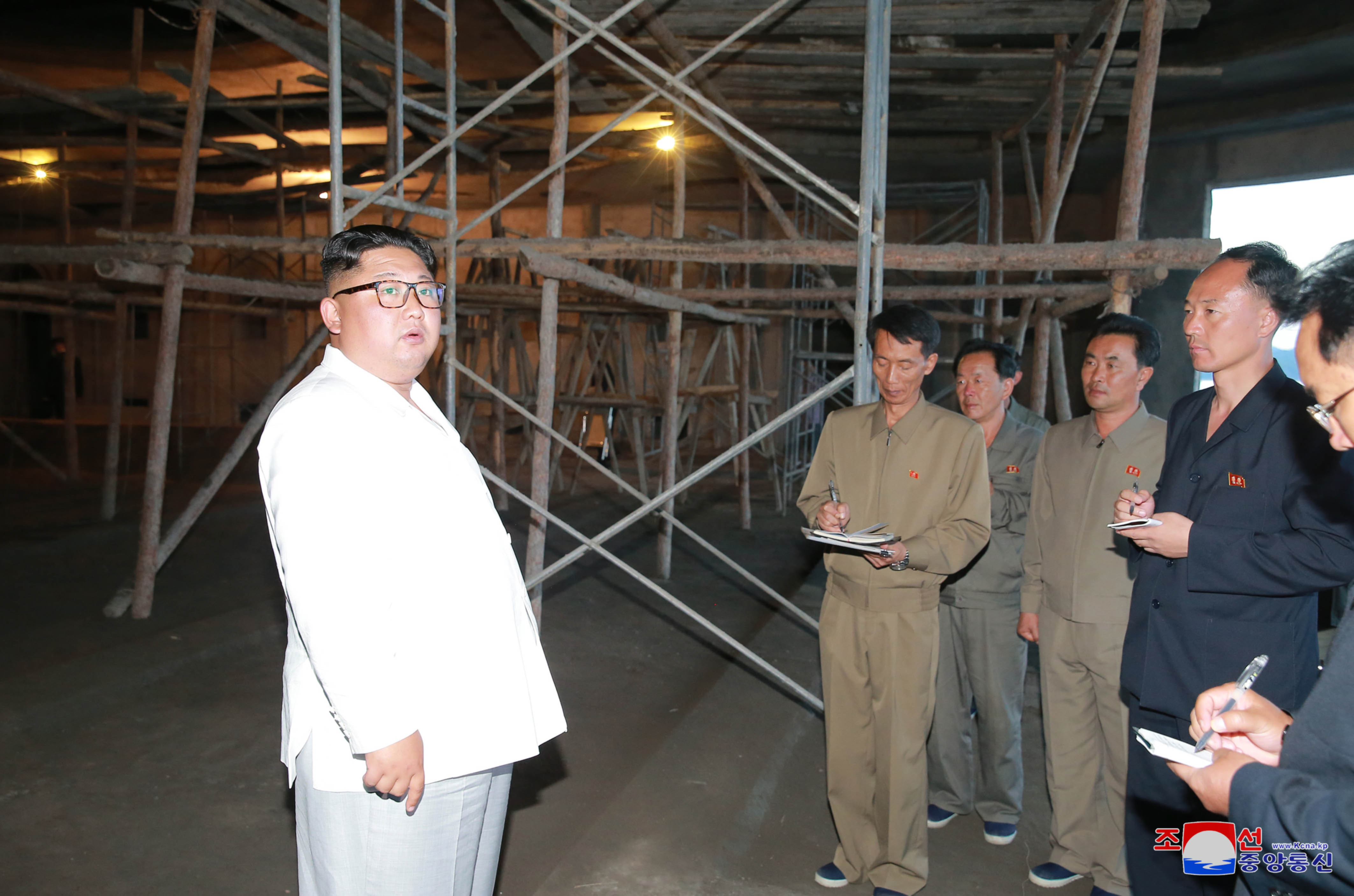
He said that if “modern hotels with adequate communal amenities are built in Yombunjin and its vicinity as there are scenic spots and famous hot springs, the people in the province and other people from across the country would take enough rest and lead a cultural and emotional life to the full while enjoying mountain-climbing, sea-bathing, angling, river-fishing and hot-spring cure in the area.”
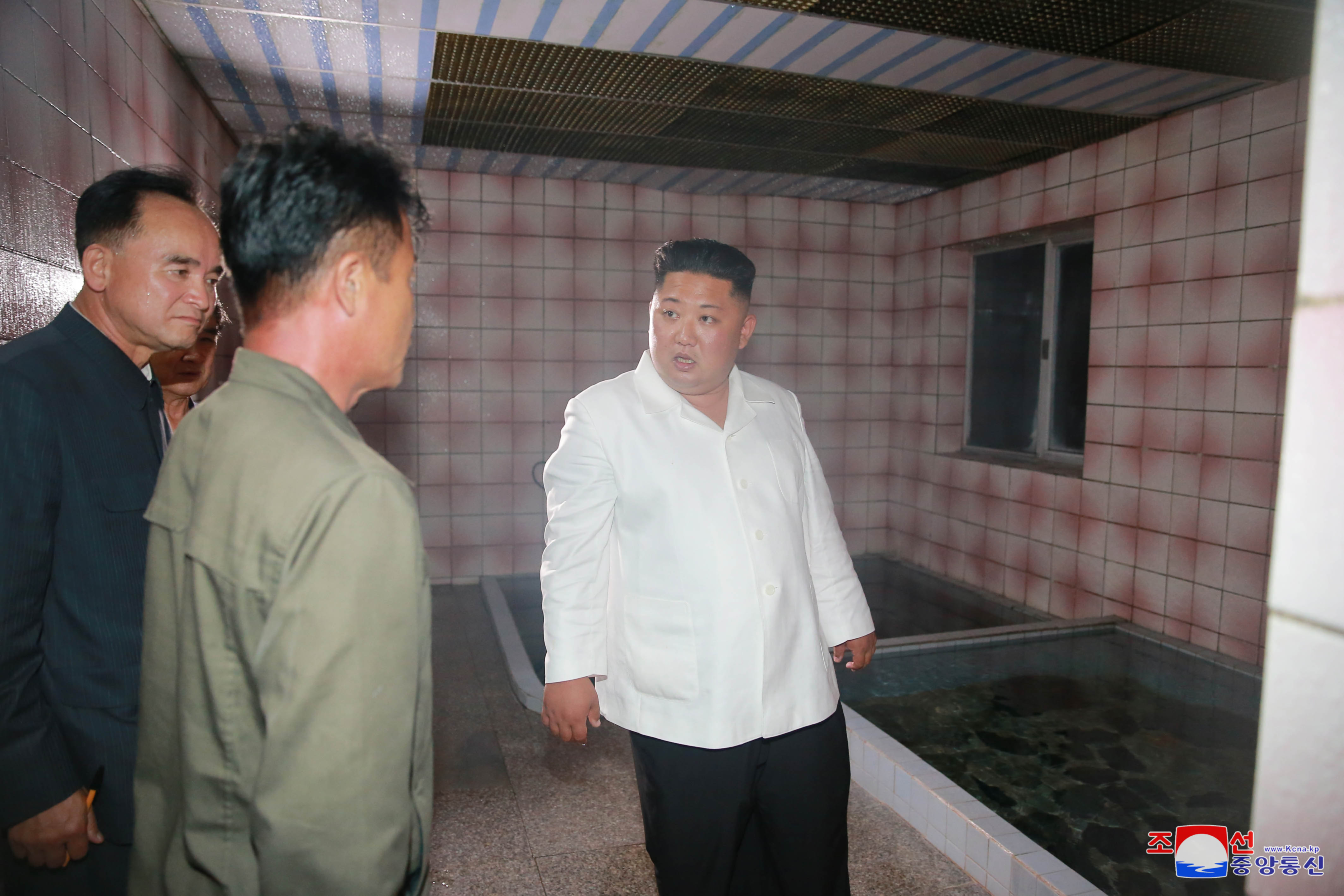
Jong Un visited Onp’o Holiday Camp during the evening and learned about its management and operation. He pointed out the camp’s bathroom was in “very bad condition, saying bathtubs for hot spring therapy are dirty, gloomy and unsanitary for their poor management. If the camp draws criticism by the people instead of their favor due to such poor operations and management though it is holding a signboard indicating that it is a building visited by President Kim Il Sung and leader Kim Jong Il, it will commit a sin of bringing to naught the exploits of the great leaders who built a holiday camp for the people before anything else in the scenic place where hot spring water is gushing out all the year round.”
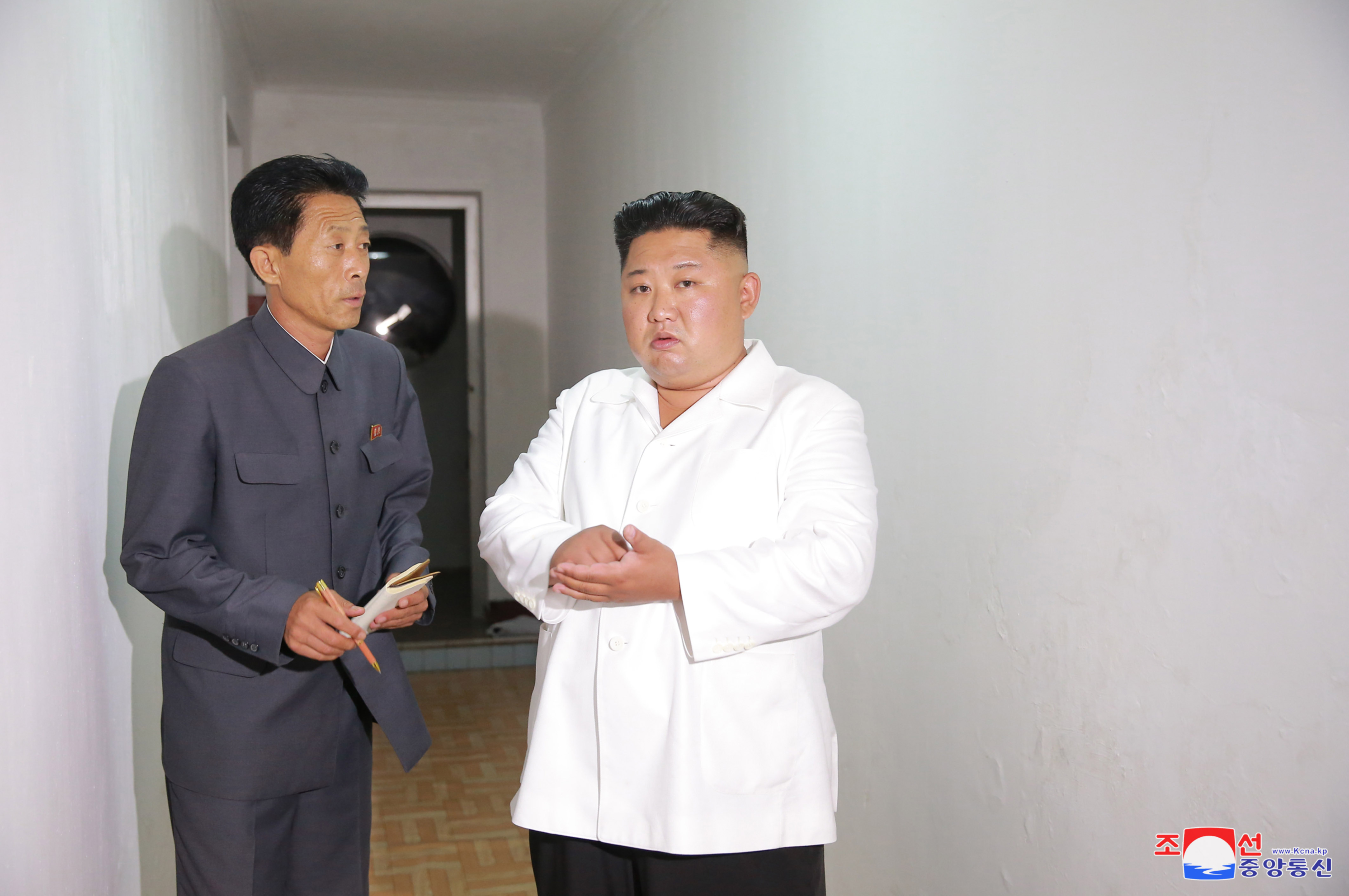
Kim Jong Un inquired of the Kyo’ngso’ng County WPK Committee Chairman about “the output of hot spring water and its temperature at the point of gust and accommodation capacity of the camp and the number of rest-home visitors” and “gave a task to modernly and newly build the camp.” He also called for “sprucing up the area of the camp which is famous for spring water in the country to be a peculiar resort which meets the convenience and growing cultural and emotional demands of the people at the best level.”
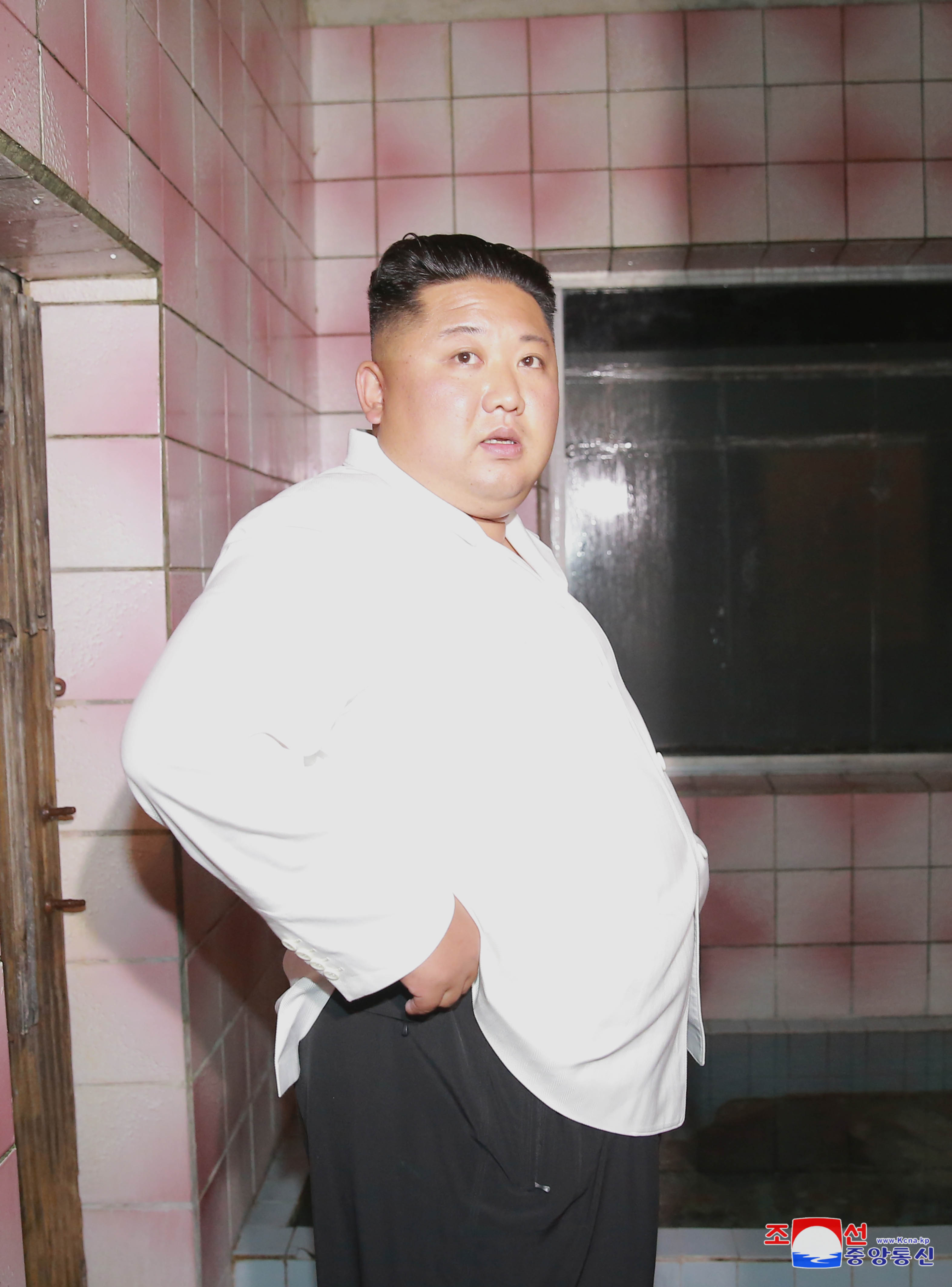
He said that he “would make sure that the People’s Army would excellently build it next year and present it to the people as a gift” and that the “camp should be built excellently to be an all-round service center, therapy center with all catering establishments so that people can enjoy full rest and spring water therapy during their holiday.” Kim Jong Un also added that the “design should be worked out in a peculiar manner to meet the features of the spring water area and thus build the camp into a model of the spring water holiday camps without an equal in the country.”
Jong Un spoke with the Kyo’ngso’ng County party boss and asked about “the work of the county party committee and the work it plans to do in the future” and provided “precious teachings for developing the county in a peculiar manner.” He noted that the “county has fields, mountains and a sea and good traffic conditions” and said “that as it has some foundation for developing industry, agriculture and fisheries, the county party committee should study and work hard for the earlier development of the economy of the county which has favorable natural and economic conditions.”
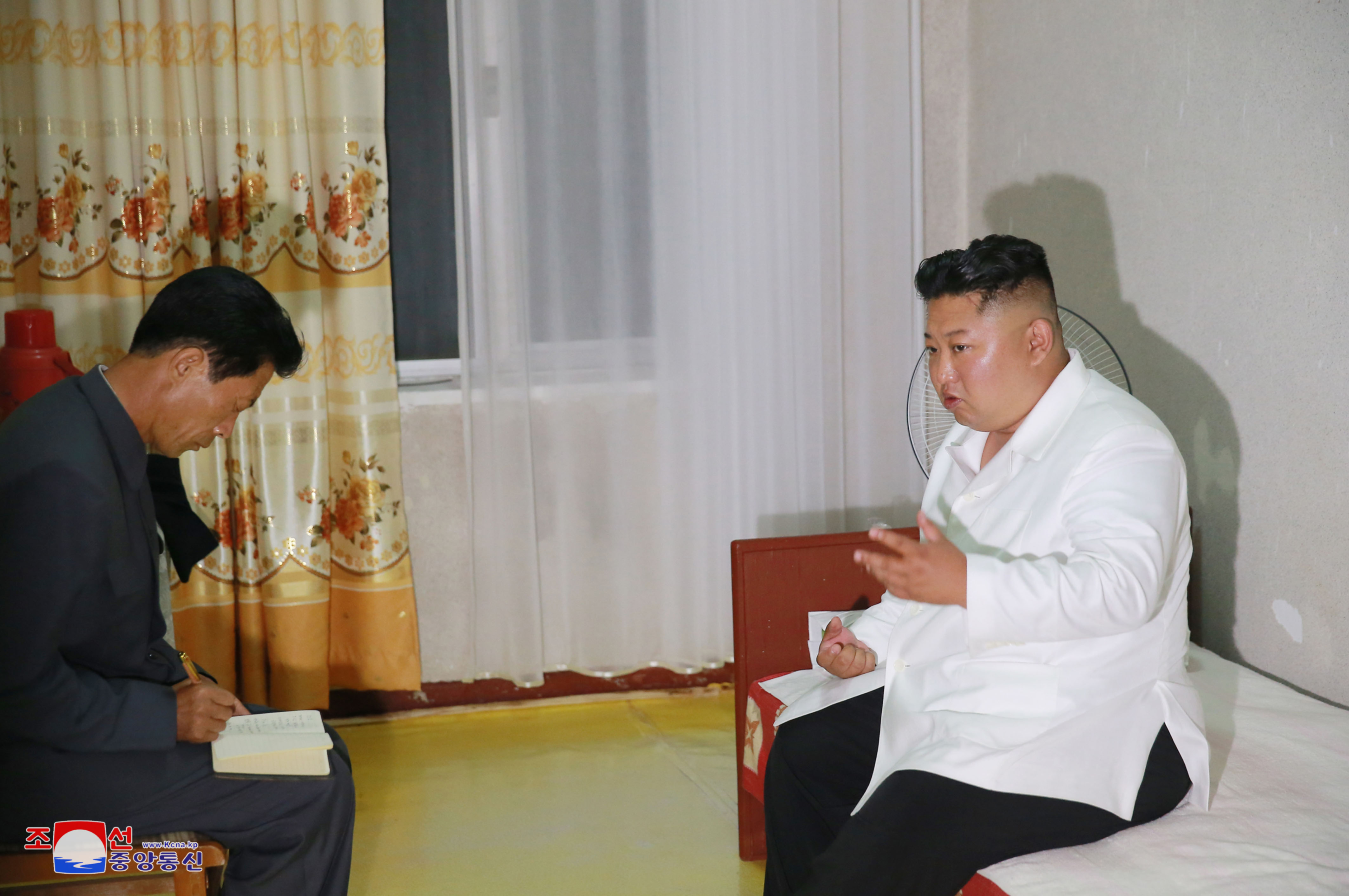
Kim Jong Un expressed his “expectation and belief that the county party committee would bring about a decisive turn in the struggle for turning the county into a marvelous one good to live with its own efforts by inspiring the people in the county to the drive for implementing the party policy.”
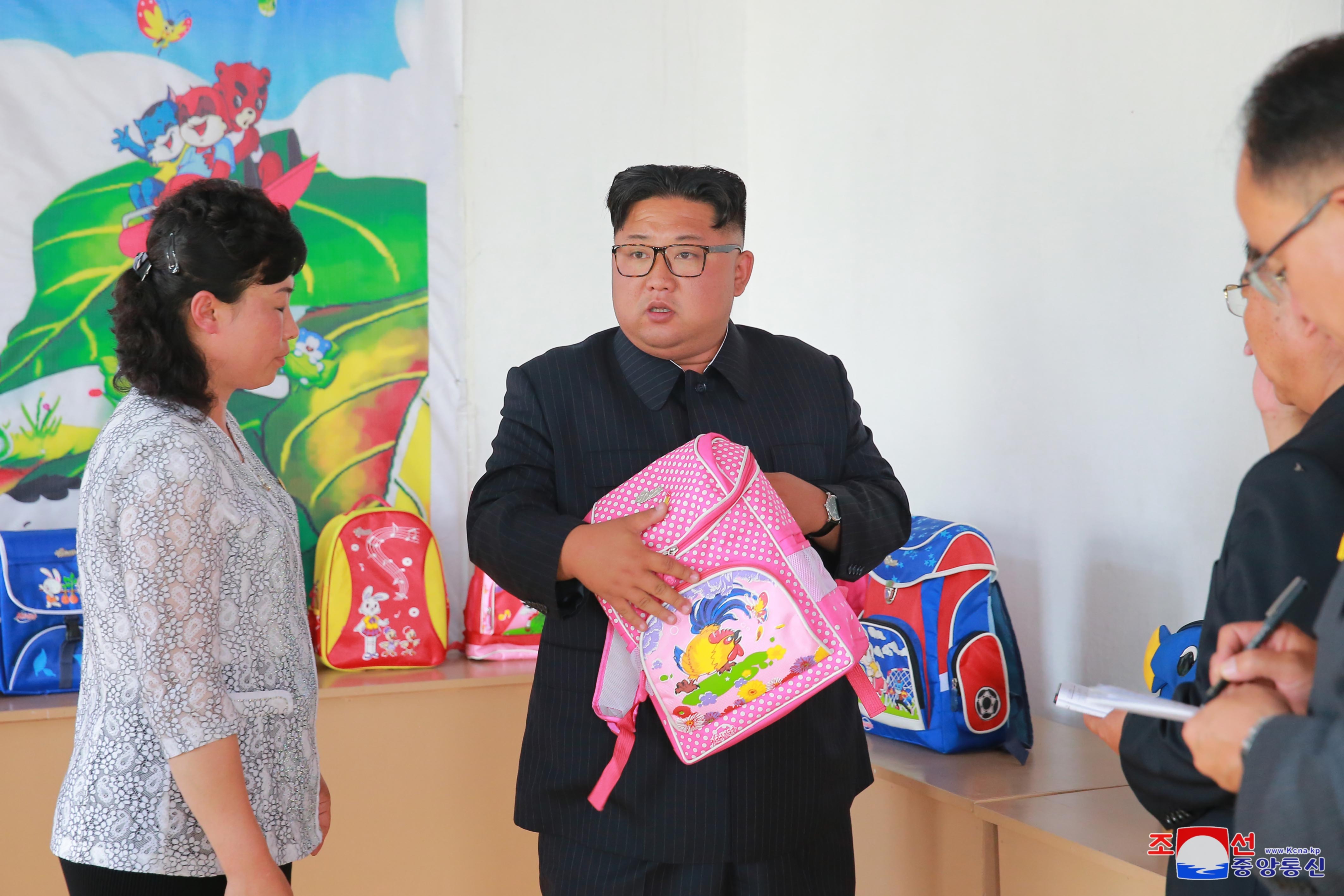
Jong Un inspected and provided guidance to the Ch’o’ngjin Bag Factory. The factory is part of the WPK’s education policies, in which provinces establish production units and factories to manufacture school supplies, particularly various backpacks, satchels and other bags for students with specially earmarked materials. According to DPRK state media the North Hamgyo’ng WPK Provincial Committee did not “sincerely accept the Party’s policy on newly building a bag factory in line with the capacity while disregarding the work initiated by the Party to provide all necessary things for the schoolers with our own products, giving top priority to the education for the generations to come.”
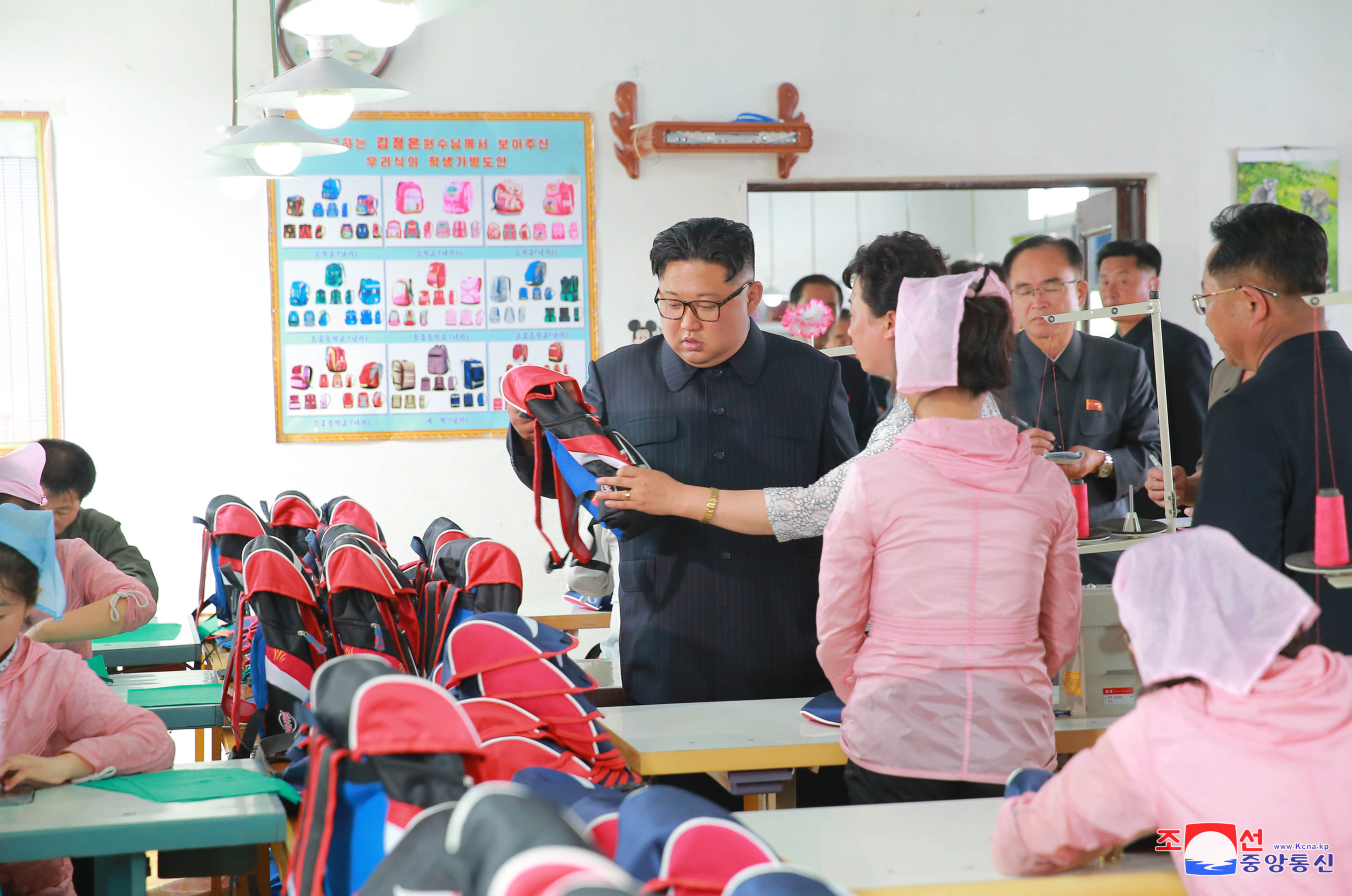
Instead the provincial party apparatus “offered shabby rooms of the building at the Chongjin Regenerated Fibre Factory for a bag production base and thus caused great anxiety to Kim Jong Un who came to the factory to learn about the bag production in localities.”
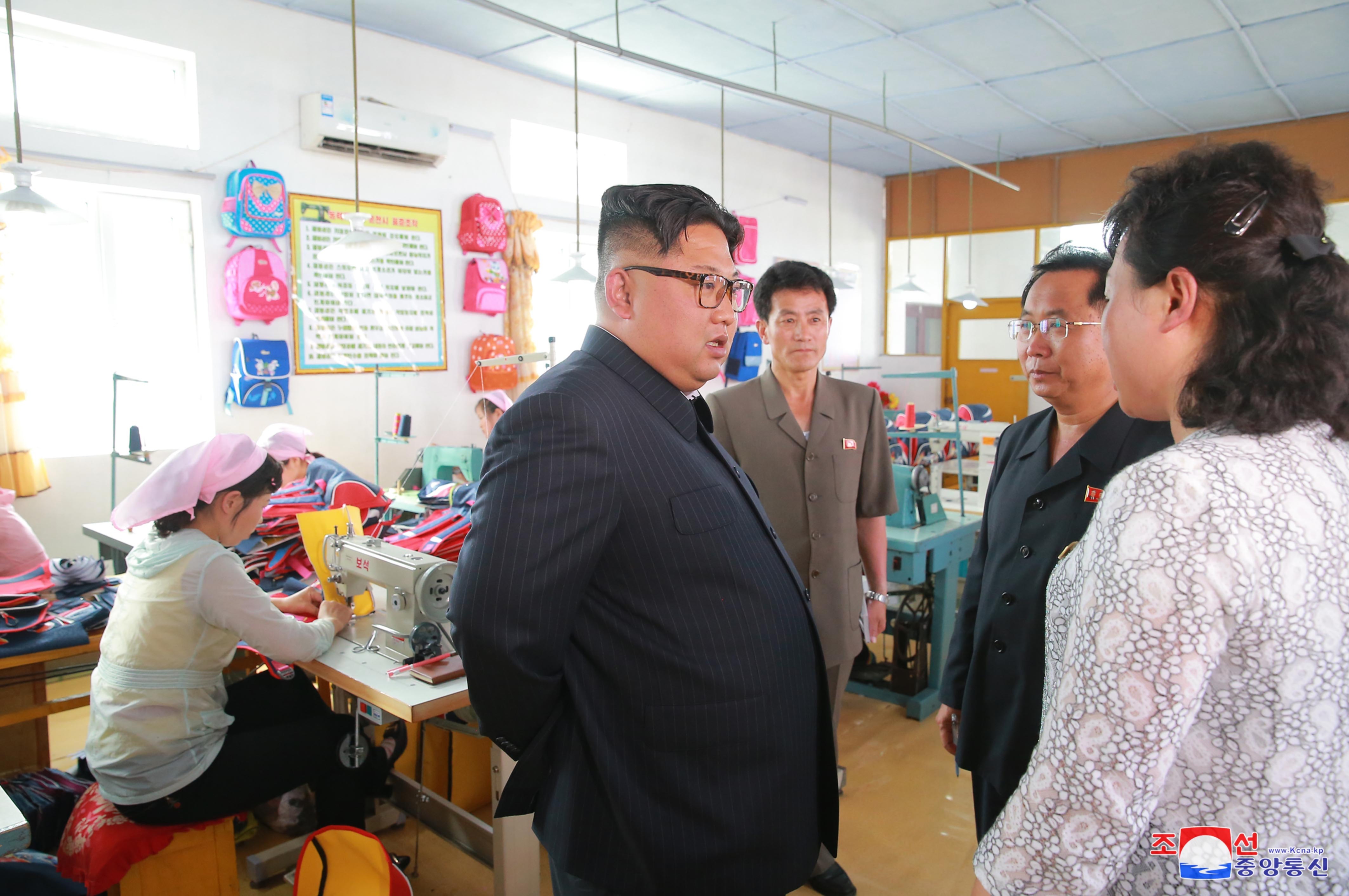
Kim Jong Un pointed out that the “Provincial Party Committee is working in a perfunctory manner, disregarding an important policy to be prioritized by it and that its attitude toward the acceptance and implementation of the Party policy is very wrong and the committee has no revolutionary spirit and responsible attitude of working hard to implement the Party policy.” He toured the product sample room and said that “the factory’s level of producing bags is high though its production began one and half a year ago and the skills of its employees are high and that the bags are diverse in color and size and they were well made with much care according to the ages.”
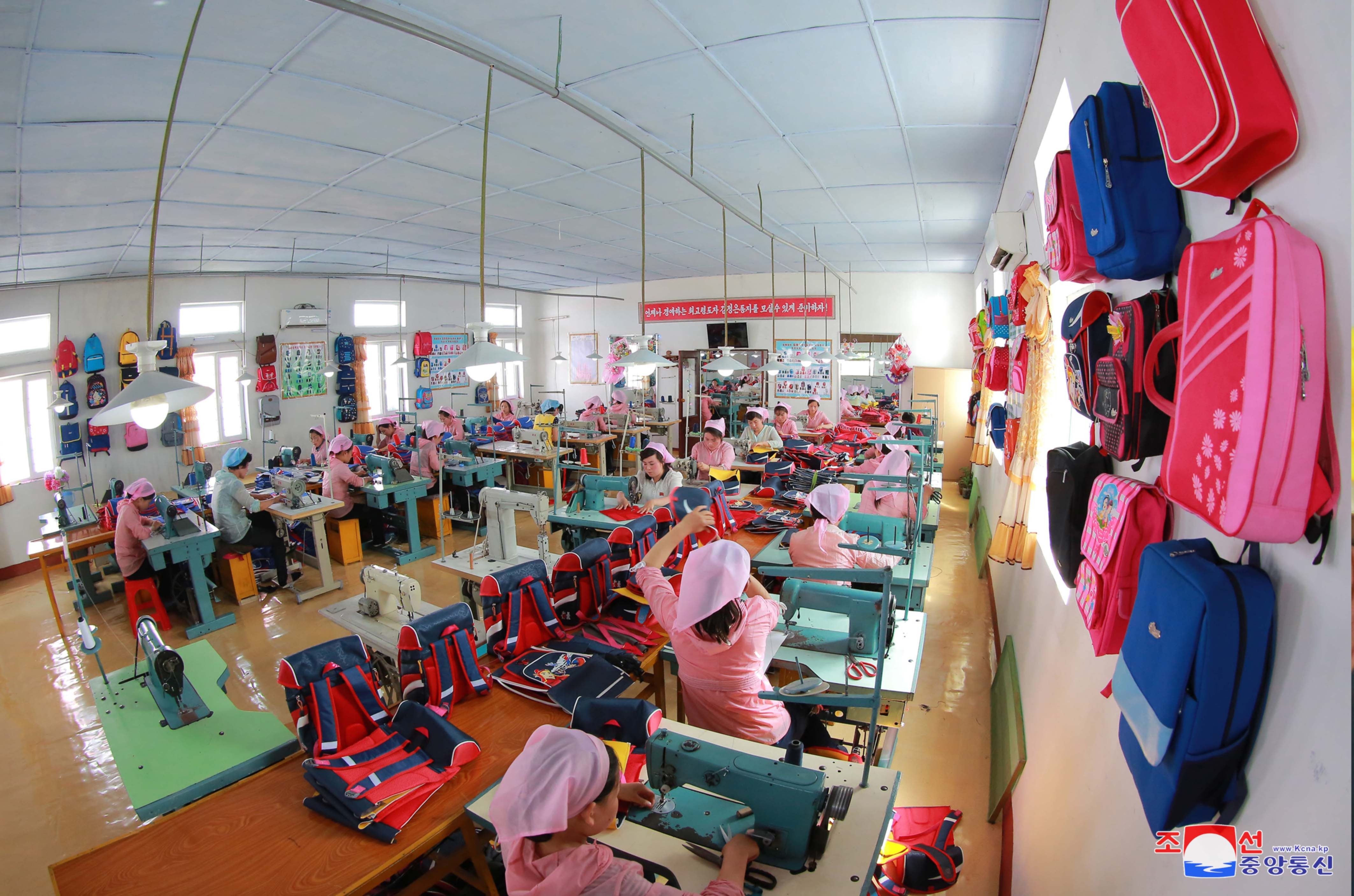
He said that it “is necessary to make the shoulder straps of bags with thicker sponge, noting that they should be made with twice thicker sponge than now so that their users may not feel pain” and stressed the “need to strive for further raising the quality of bags.” Jong Un said that the “central factories responsible for production of raw materials should produce the accessories of bags such as cloth, zip and tape with locally available materials and ensure their production on a high level.” He called for “qualitative and meticulous sewing to produce quality bags so that they should not get unfastened or ripped though children and pupils handle them at random.”
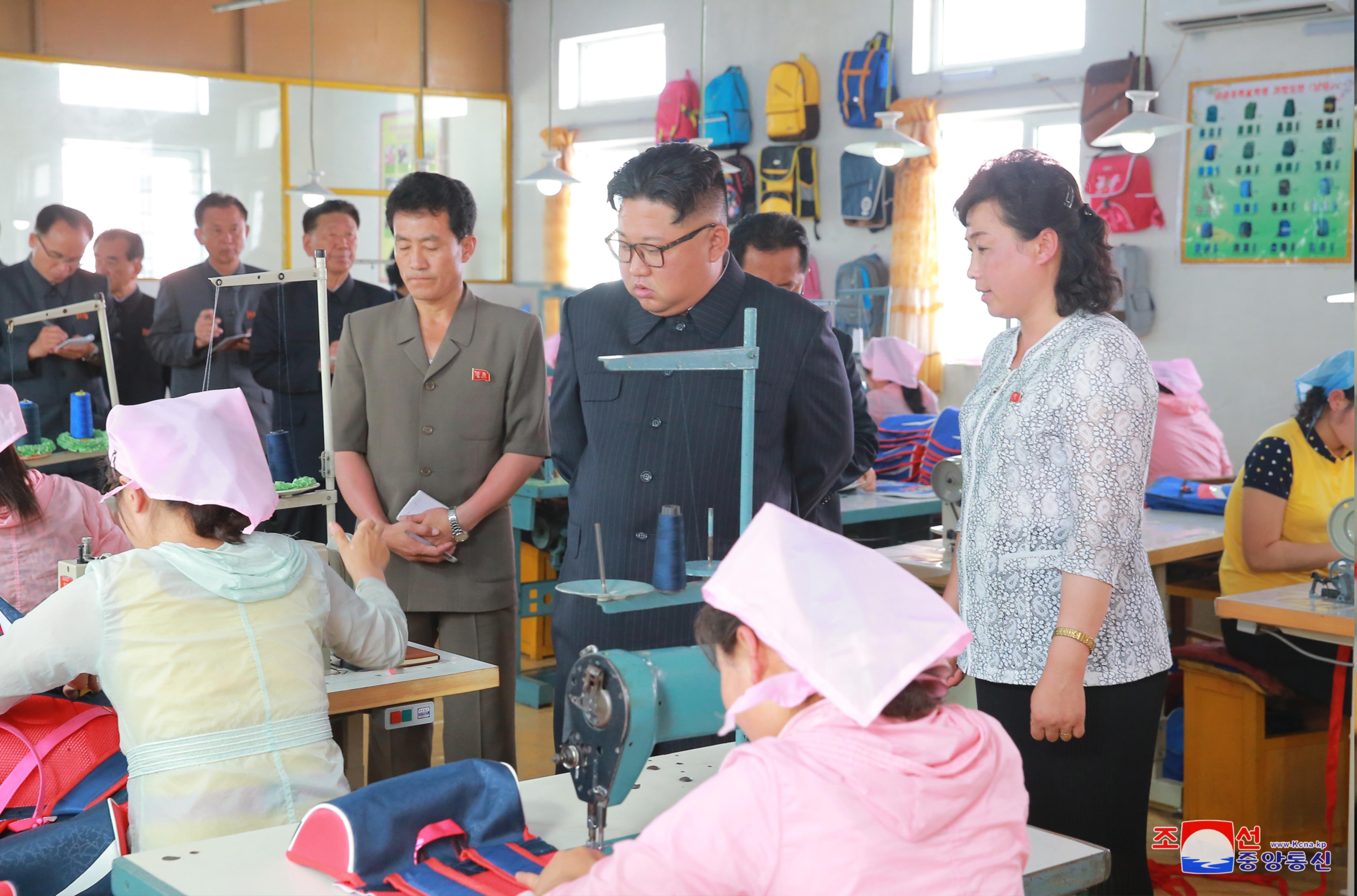
Kim Jong Un said that it is “necessary to further reduce the bag production cost” and issued an instruction to ” reexamine the price of school things including Mindulle notebooks and bags being supplied to pupils.” He said that “even though the state has more burdens, it should not give inconvenience to the people” and needs to “correct the price after listening to the view of inhabitants.”
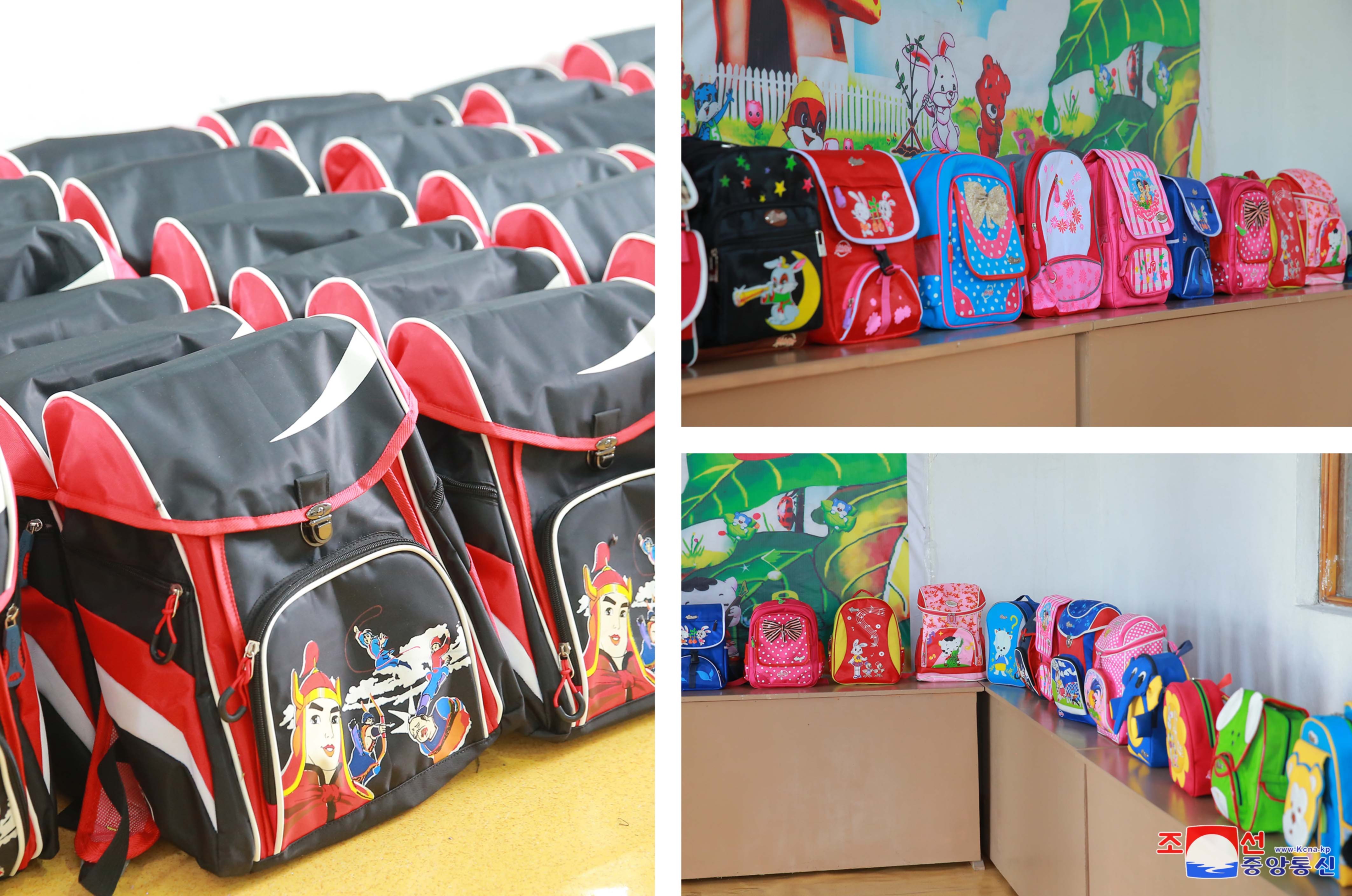
He charged that there must be a “problem in the work of the Provincial Party Committee as it has not yet built a design room, paying no attention to a poor products show room” and he noted that he “gave an instruction for provincial party committees to build a schoolbag factory in a responsible manner in every province and learned about the construction of bag factories in some provinces and they are considerably different in level. Such differences should be considered as a gap in the officials’ ideological attitude toward the Party policy, not difference in the economic power of provinces.”
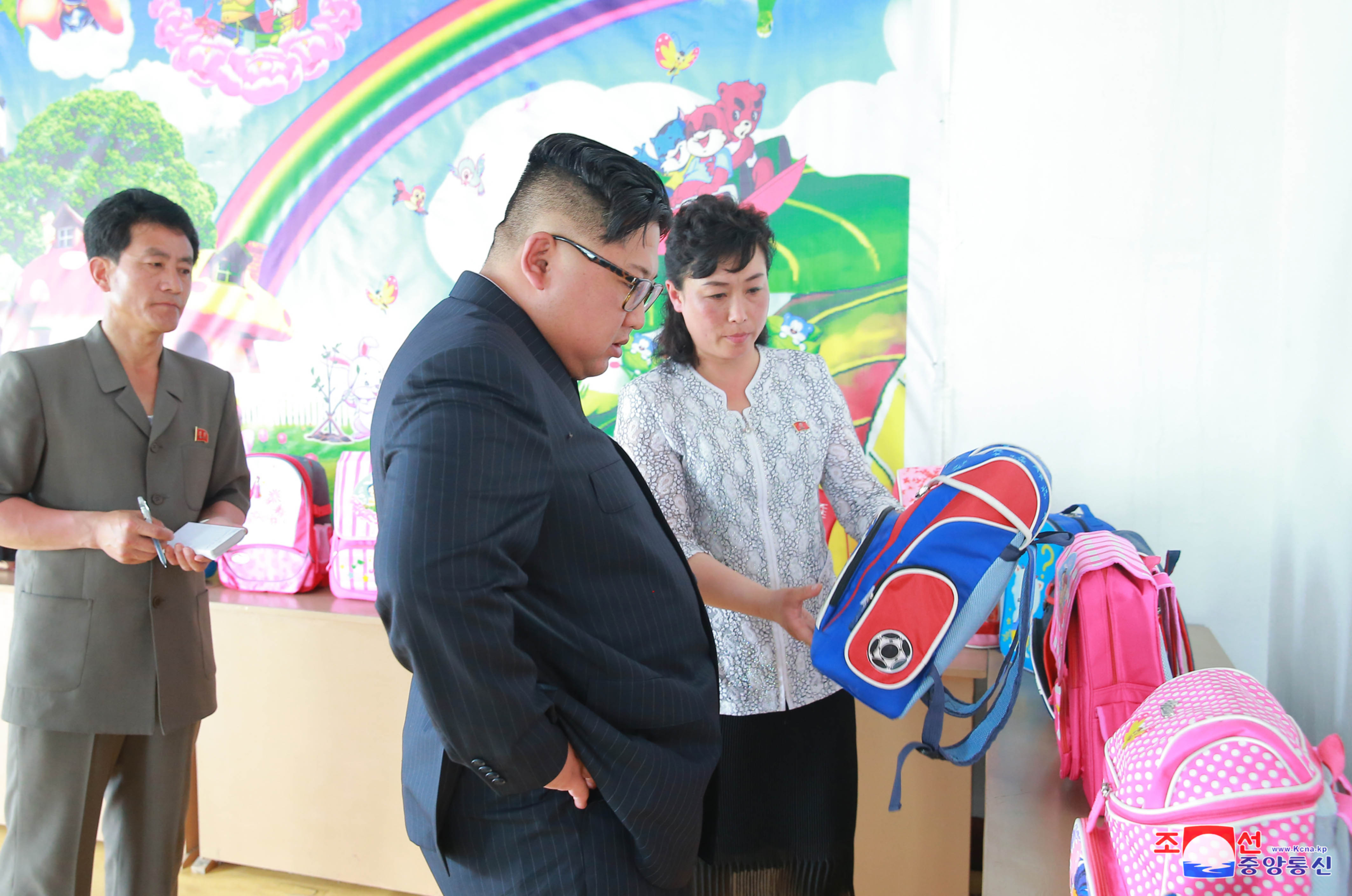
Kim Jong Un remarked that the “overall economy of the country can vigorously progress when North Hamgyo’ng Province with great industrial potentials stands up” and he expressed his “belief that the Provincial Party Committee would rectify its faults as soon as possible and wage a dynamic struggle for implementing the Party policies and thus build up the province into a reliable key industry zone of the country and bring about a radical turn in improving the people’s living standard.”
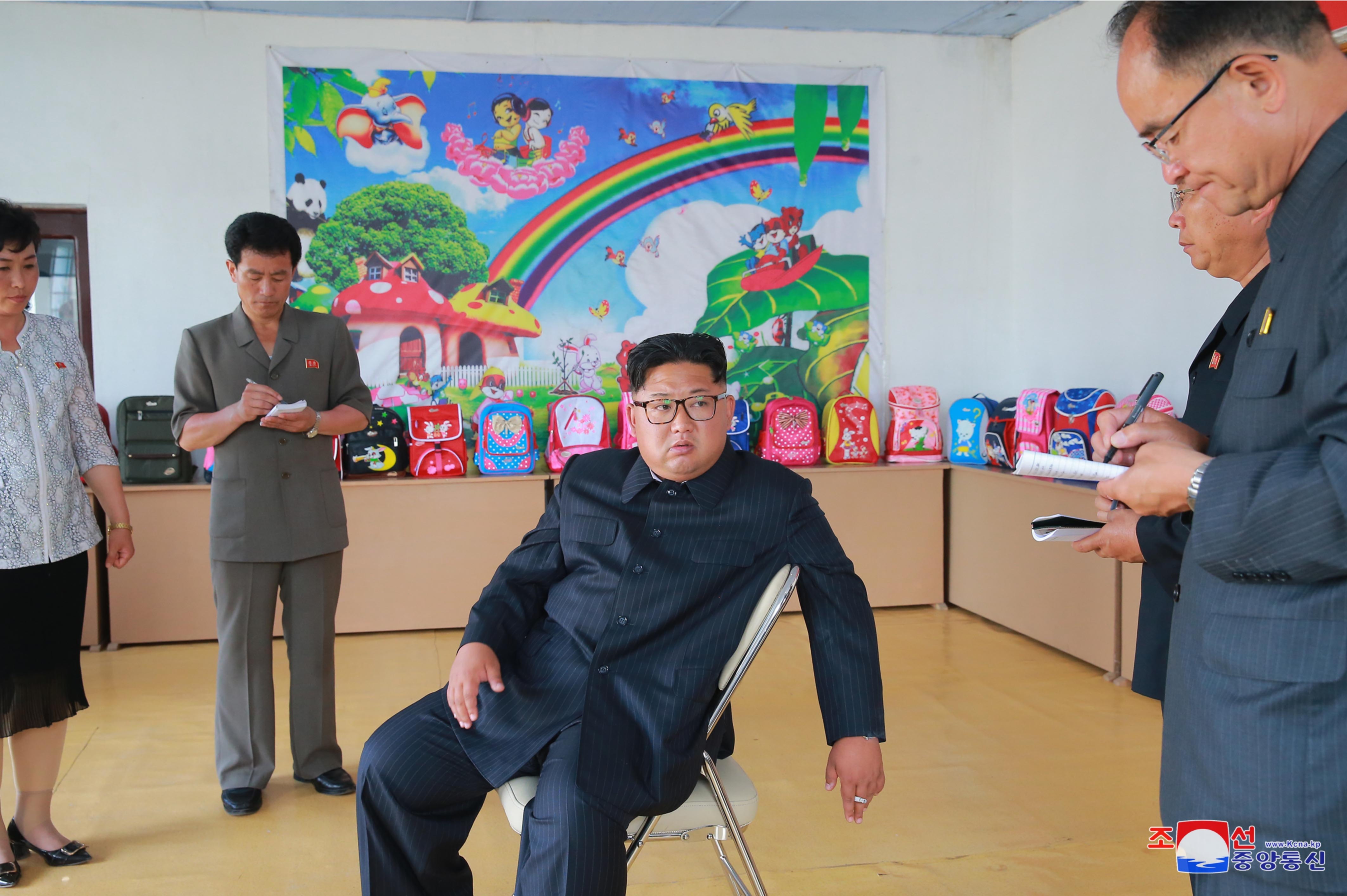
Dam, son
Kim Jong Un’s batch of visits to Kyo’ngso’ng County and Ch’o’ngjin, North Hamgyo’ng, have attracted some extra attention from international media outlets due to state media having reported several occasions of him critiquing and upbraiding “leading officials of the Cabinet,” along with leading cadres of the North Hamgyo’ng WPK Provincial Committee and some other local officials. For some Pyongyang watchers, this raises the prospect that a group of senior functionaries will soon find themselves sent out to be shot.
State media reporting of Jong Un’s expressions of displeasure, anger and anxiety are not, despite the claims of some analysis, are not anomalous. He has chastised and reprimanded officials in state media reports (in 2013 he blew up at amusement park officials because they had not sufficiently weeded or maintained the landscape) and in the voiceover narrations of the documentary digest films about his on-site visits and inspections. Meetings of the WPK Central Committee and other top-level gatherings (i.e. CMC meetings and Politburo meetings) have referred to “defects” and “problems.” This adds to the profile that in highly relative terms, Kim Jong Un’s leadership style has a certain degree of transparency and candor.
There are some other, possibly more notable things about this visit. During his visit to Jungp’yo’ng-ri, state media noted that the CMC (WPK Central Military Commission) had issued an order (likely during its May 2018 meeting) that the air force turn over a vast parcel of land over for the development of a civilian-use agricultural site. This has been a gradual, even slow process, whereby KPA real estate is turned over for civilian and Party development and use.
Also, quite notably, this is Kim Jong Un’s first observed guidance tour of North Hamgyo’ng Province’s production units and, all but one, to civilian-use economic sites since he assumed power. Aside from visiting flood relief and reconstruction efforts near Raso’n and conducting some field inspections of KPA corps units, Jong Un has largely stayed away from North Hamgyo’ng.
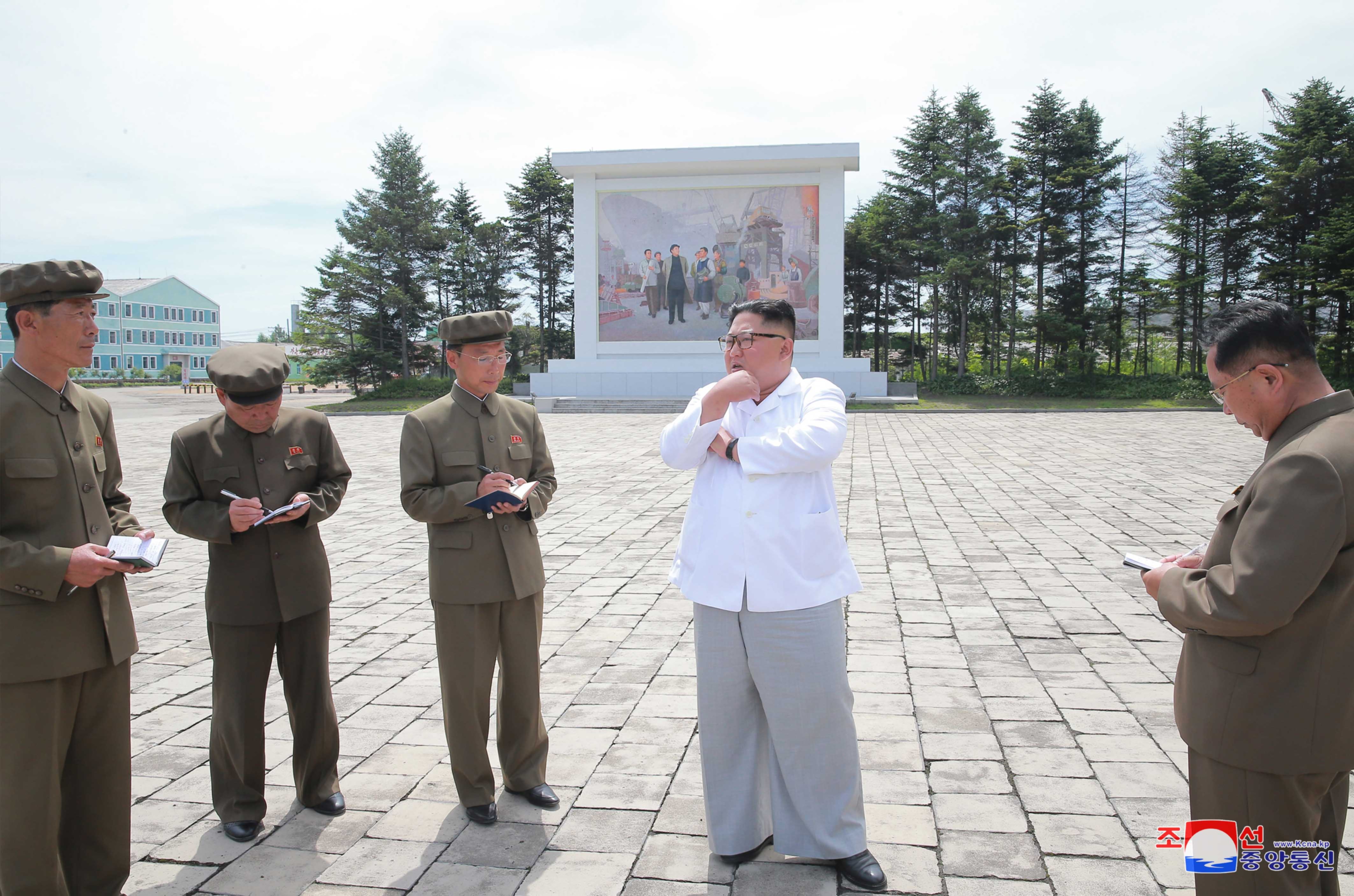
North Hamgyo’ng functions as a kind of half-assed autonomous administrative zone in the DPRK. It is the outermost boundary of the mosquito net of the Raso’n Economic Trade Zone. During the last 50 years, the province has been a reception point for the DPRK’s population categorization and compelled relocations. The Arduous March had a tremendous impact on North Hamgyo’ng. According to some sources, the central leadership picked four of the province’s counties and determined these areas were cut off from international nutritional assistance. The burial mounds of those who starved to death are visible in the foothills overlooking the provincial capital Ch’o’ngjin.
When one is assessing Kim Jong Un’s upbraiding officials at all levels regarding North Hamgyo’ng Province, there is a powerful message he trying to convey. His critiques were tempered with his instructing local officials to contact the core leadership when they encounter resource allocation problems or labor or management inefficiencies. He is attempting to tell functionaries and citizens of North Hamgyo’ng Province that in contrast to the recent past, they are not on their own and that their concerns will not be ignored by the central leadership.
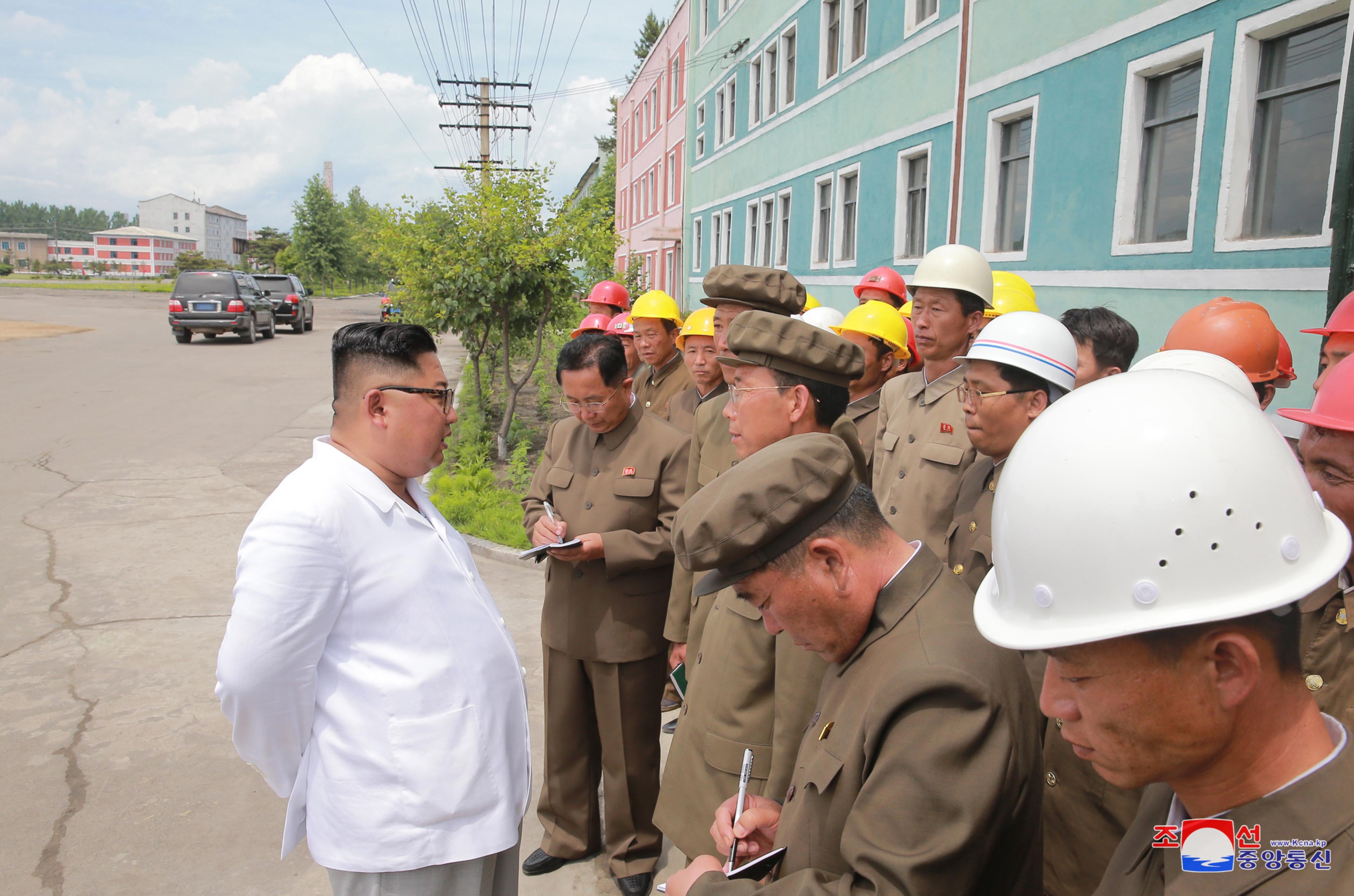
It remains to be seen if or how Jong Un’s subtle message will be received. It might also help that a number of senior DPRK officials were born or are from North Hamgyo’ng Province, chief among them DPRK Premier Pak Pong Ju (Pak Pong-chu).
Until the appointment of Ri Hi Yong as the Chairman of the North Hamgyo’ng WPK Provincial Committee, the party apparatus has historically been run by a former senior DPRK Cabinet official–those “leading officials of the Cabinet” who incurred Jong Un’s enmity. Past party bosses include Kang Song San (former DPRK Premier), Hong Sok Hyong (former Chairman of the State Planning Commission), O Su Yong (former DPRK Vice Premier) and Jon Sung Hun, the immediate past head of the province’s party apparatus and a former DPRK Vice Premier [n.b., the same can be said of South Hamgyo’ng].

Kim Jong Un is certainly within his rights to be frustrated at the slow pace of progress at O’rangch’o’n Power Station. Construction on the first parts of the power station began in April 1985. Construction paused during the 1990s, but Kim Jong Il ordered that the O’rangch’o’n Power Station’s construction resume in 2000, and construction on the dam began in 2001 and there have been attempts to accelerate its development in 2004 and 2010. Considering Kim Jong Un has given the project a loose deadline of October 10, 2019 and parsing his rhetoric, it is highly likely it will serve as the focus of a national publicity and work harder campaign during the next year.
View Original Article